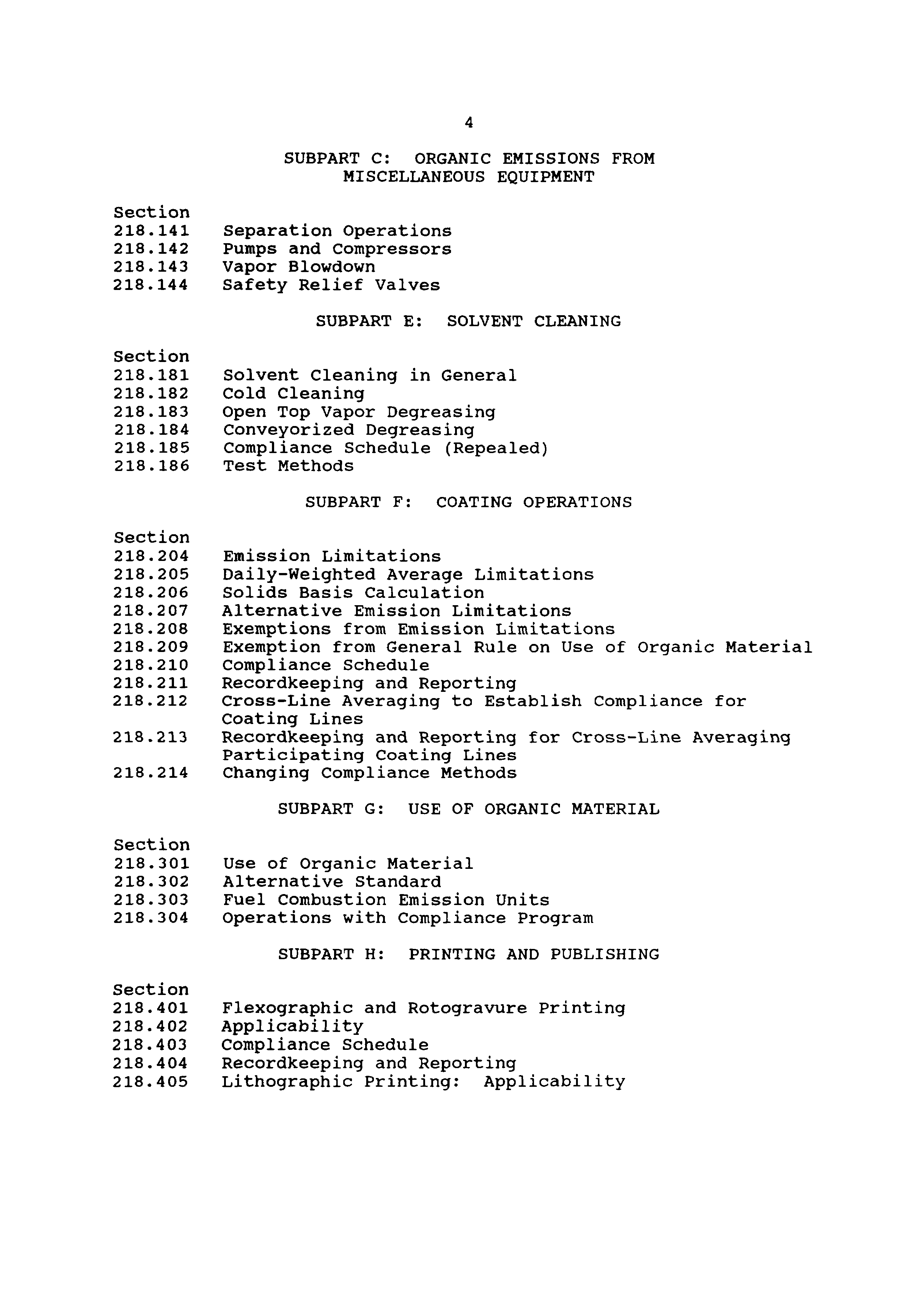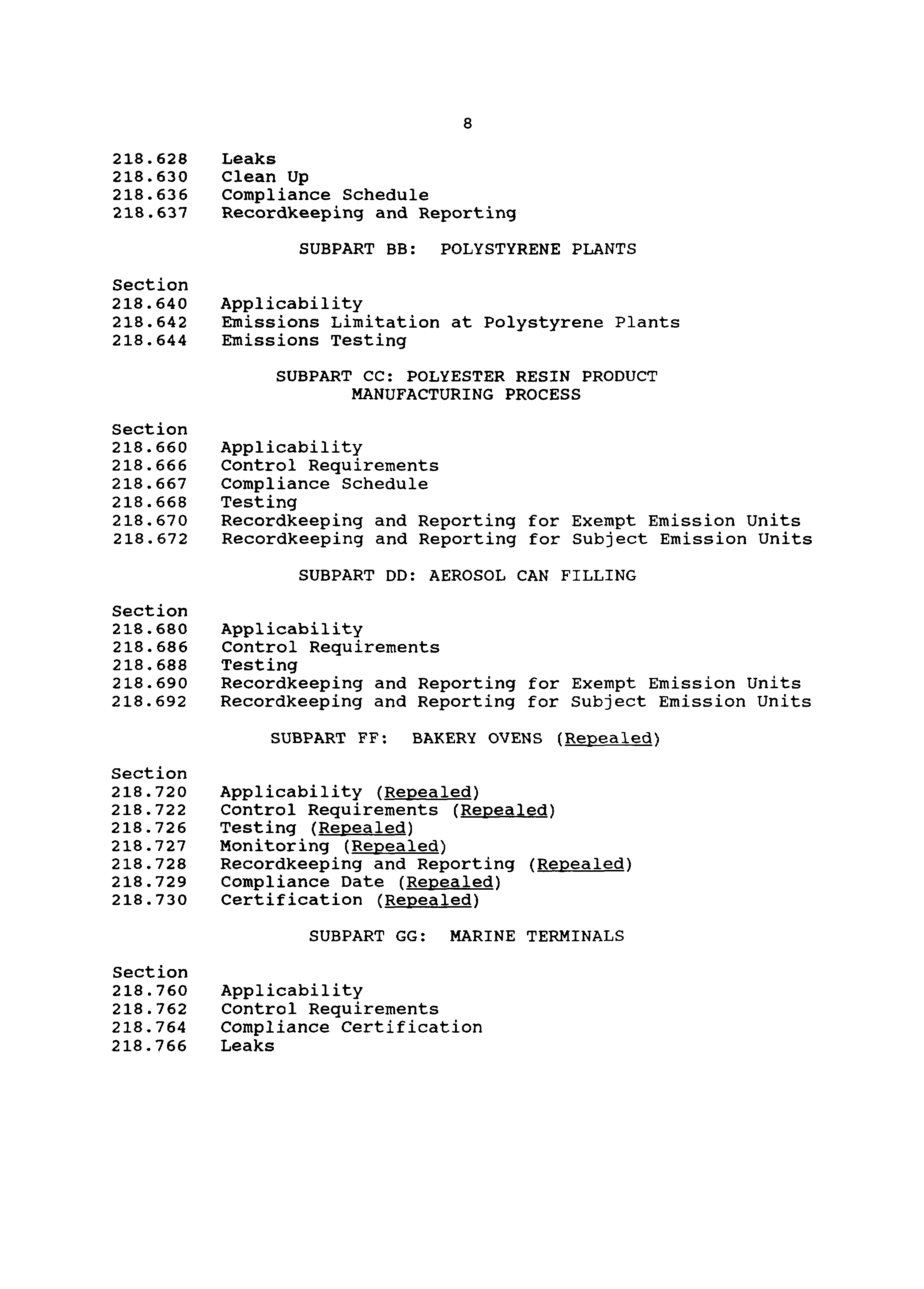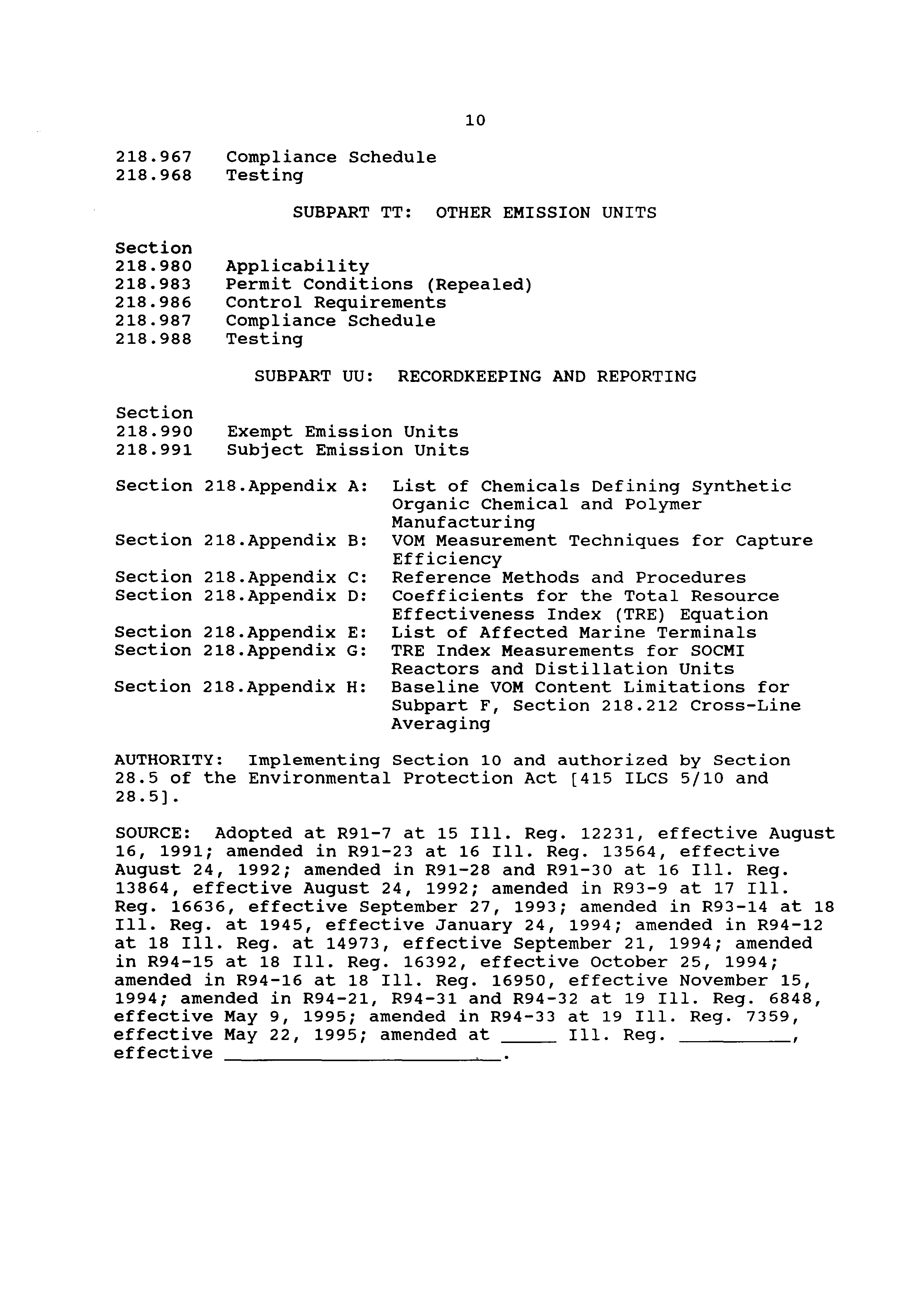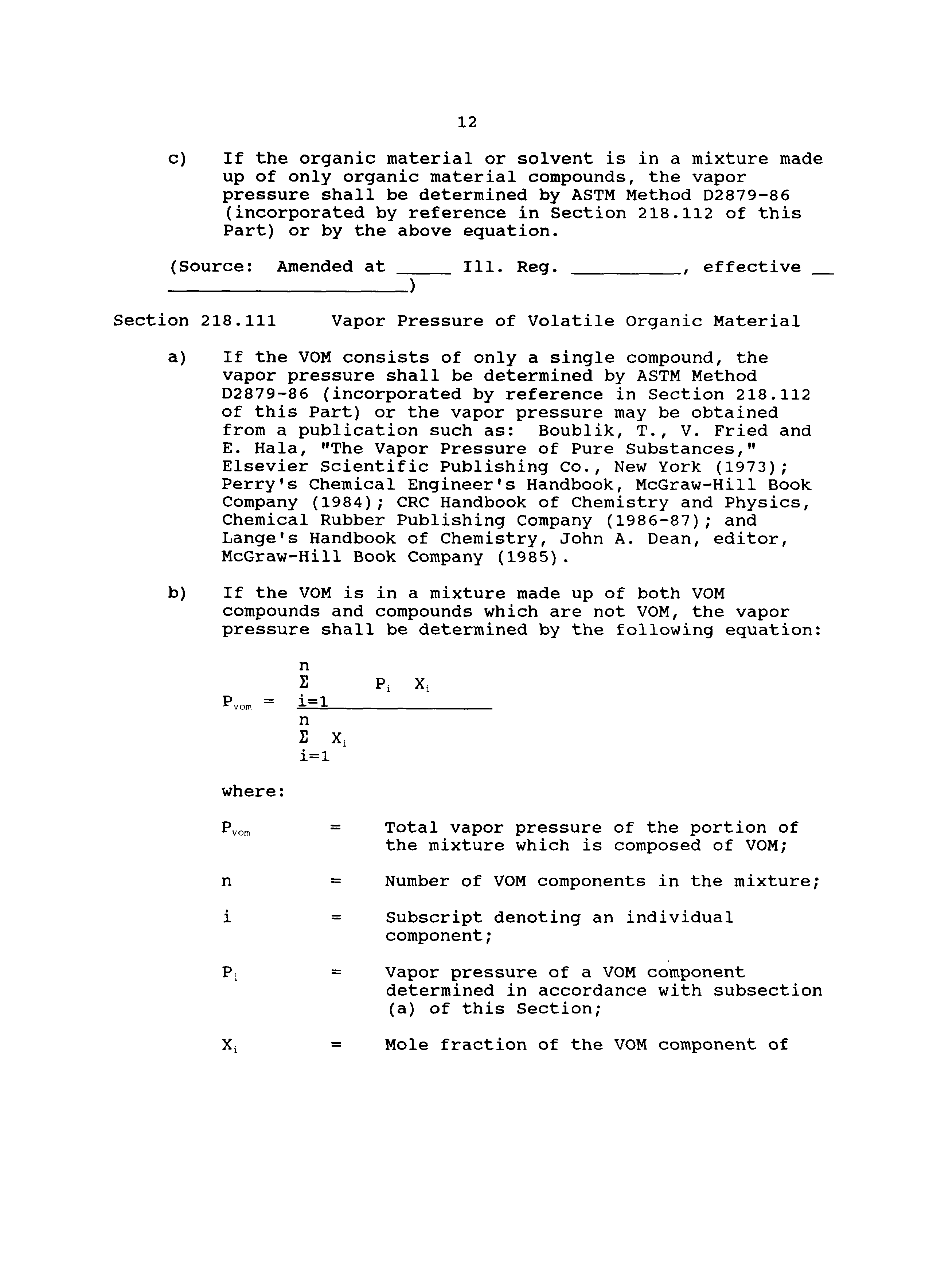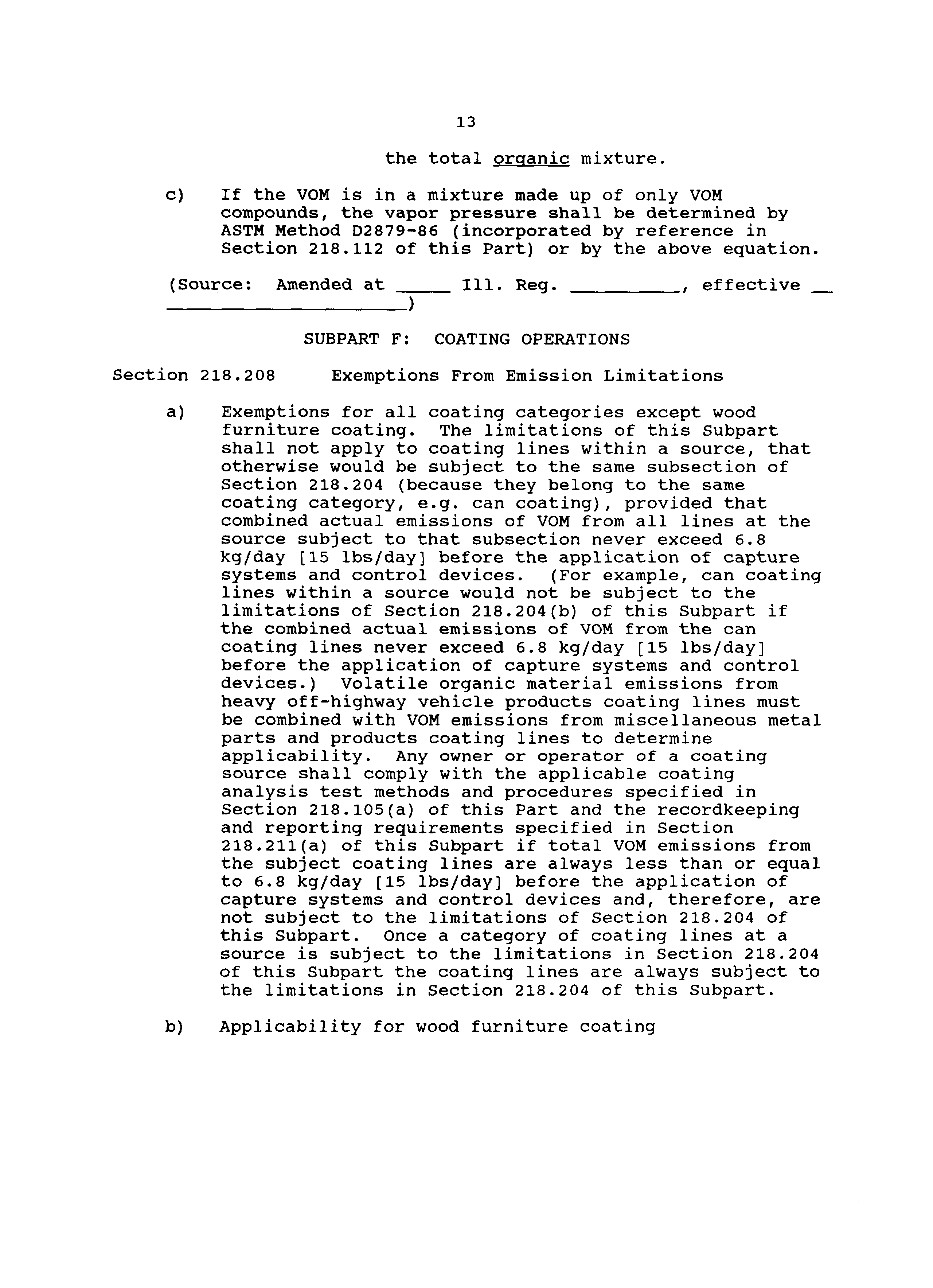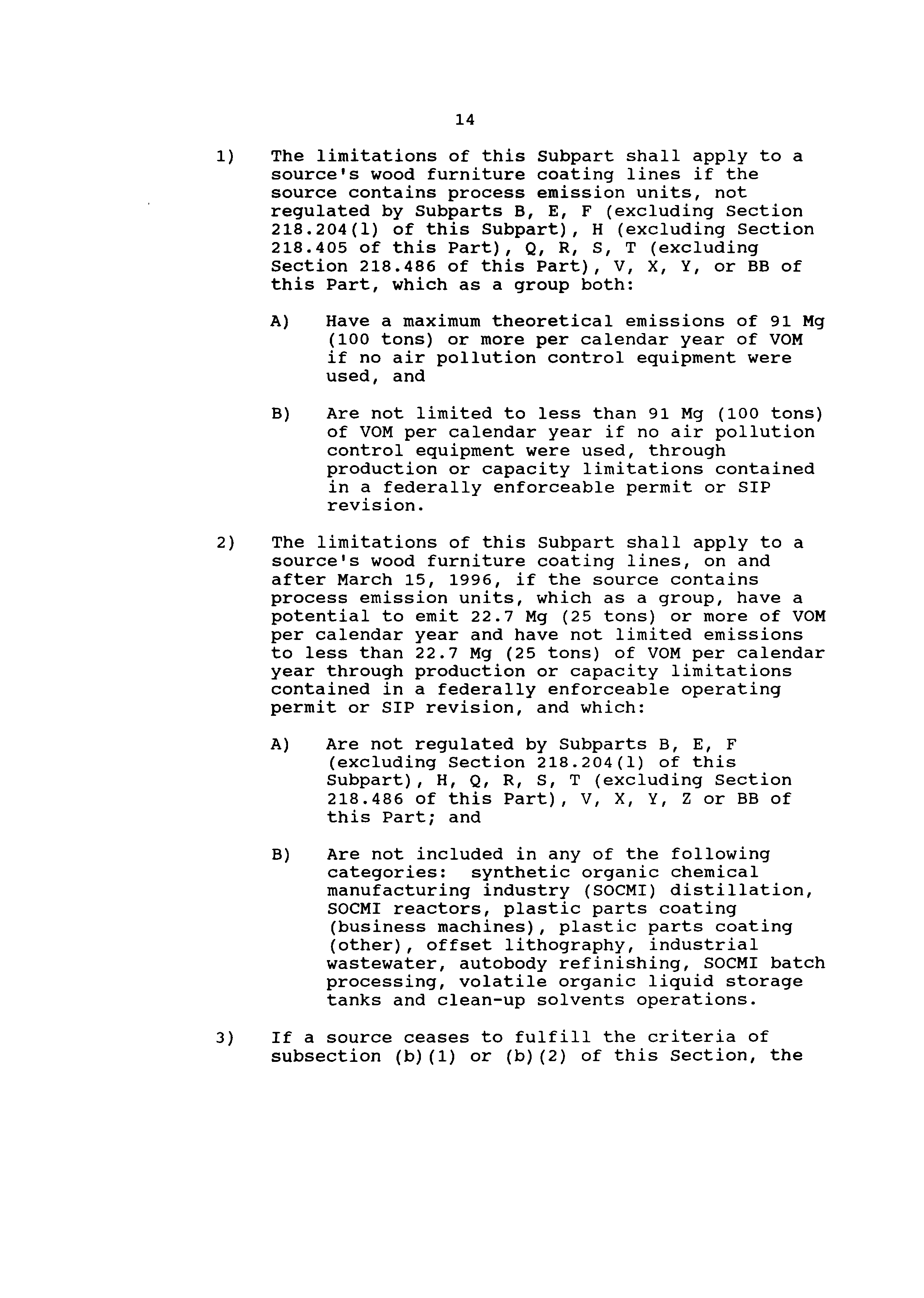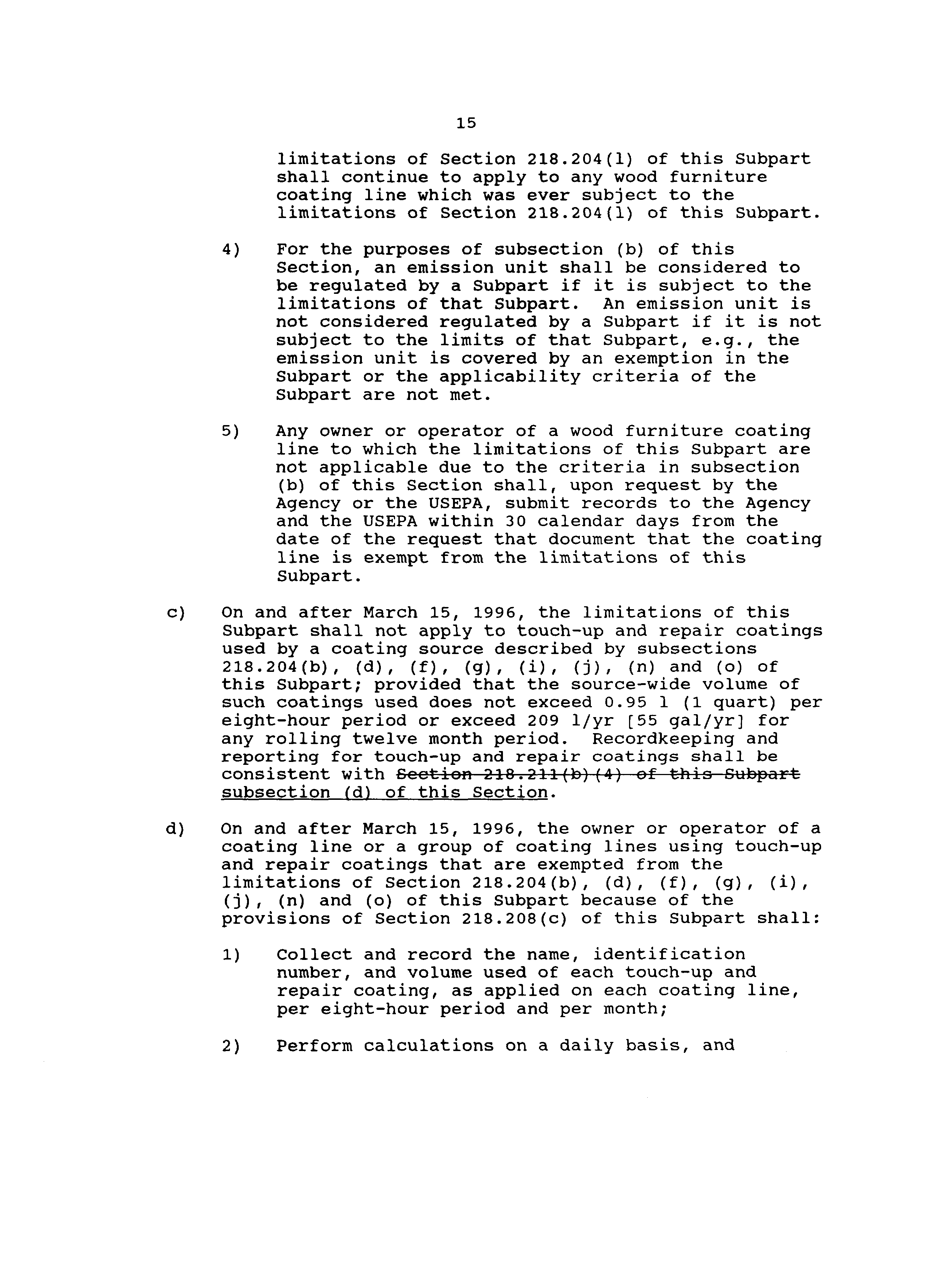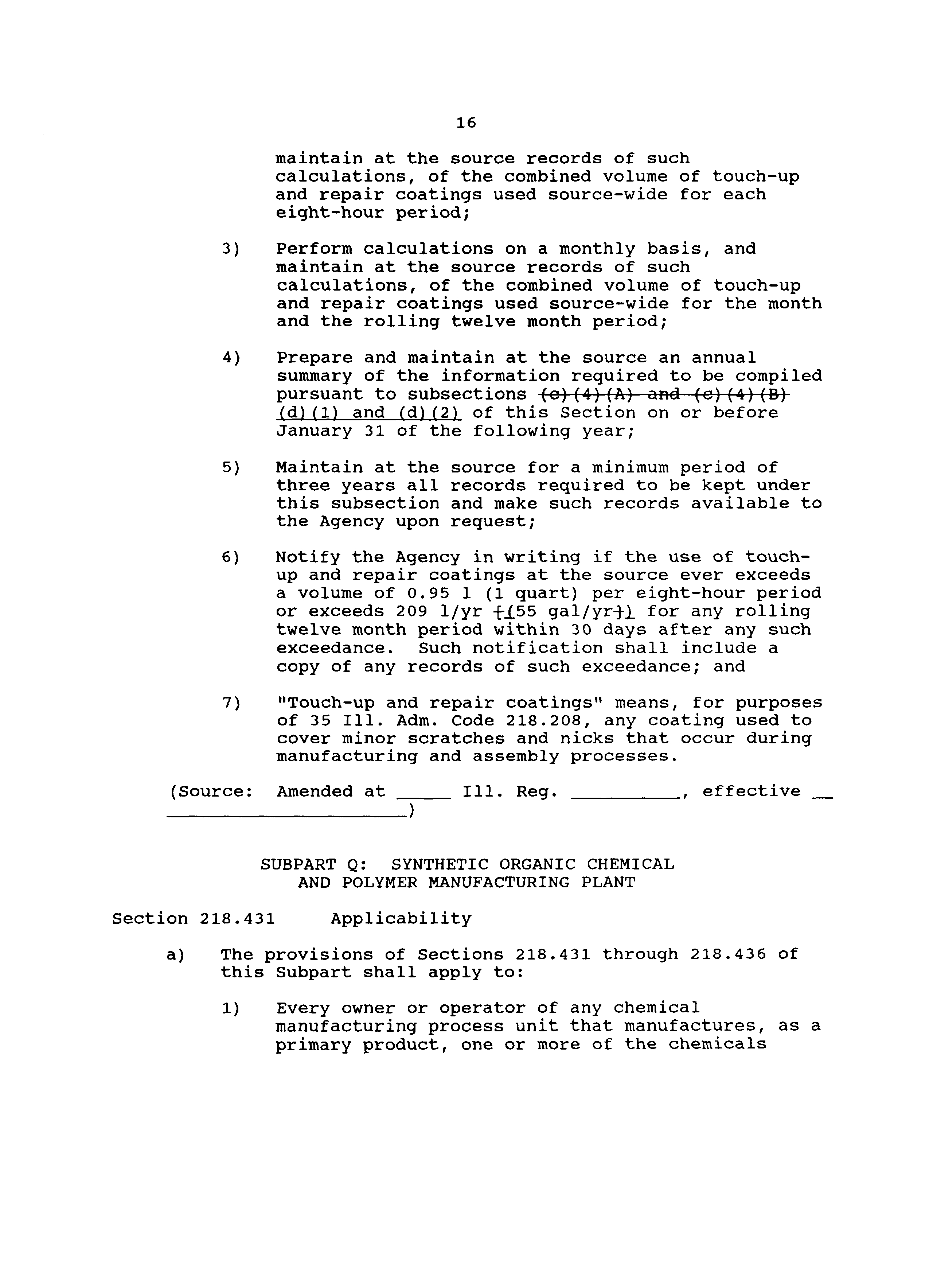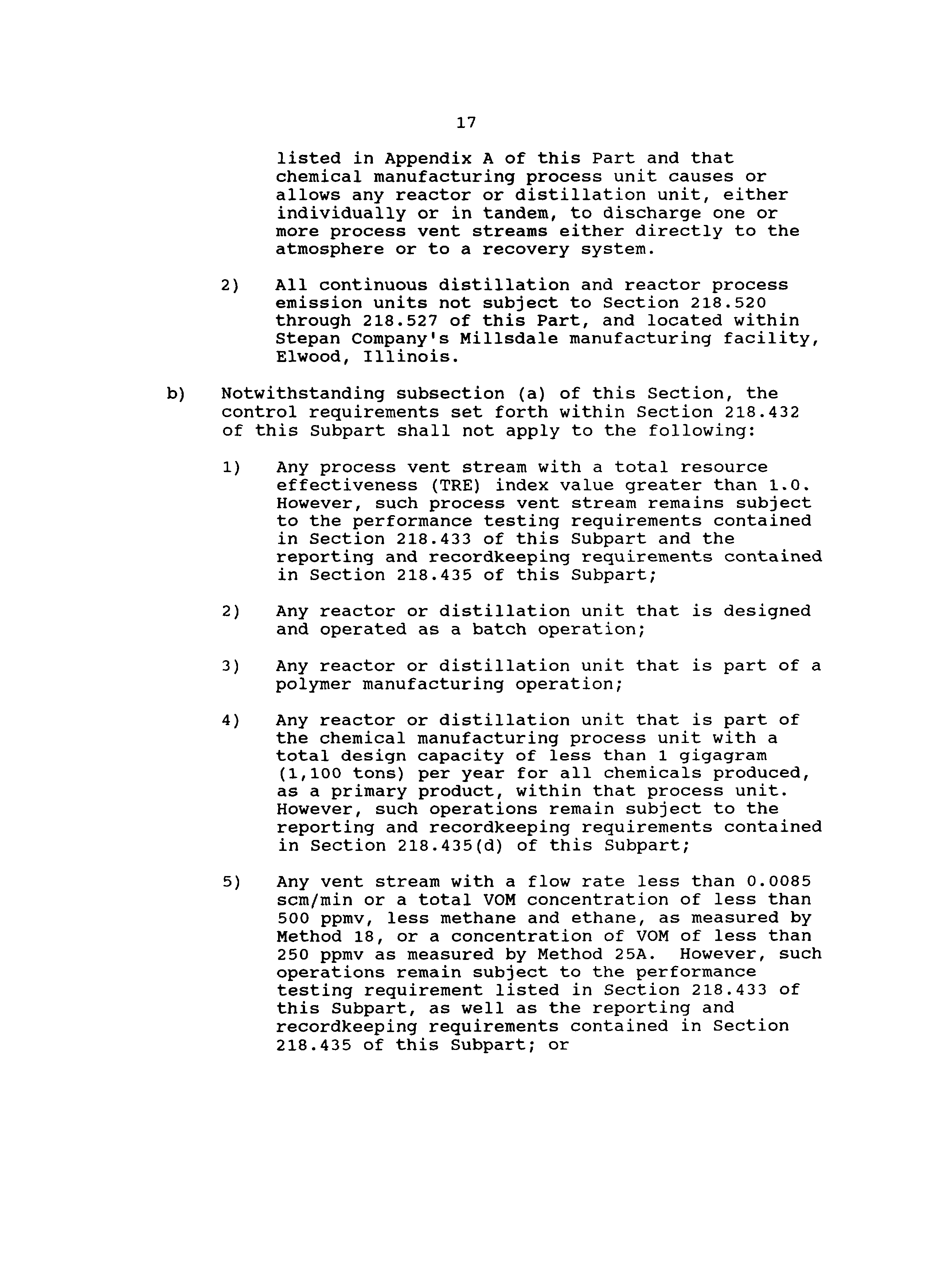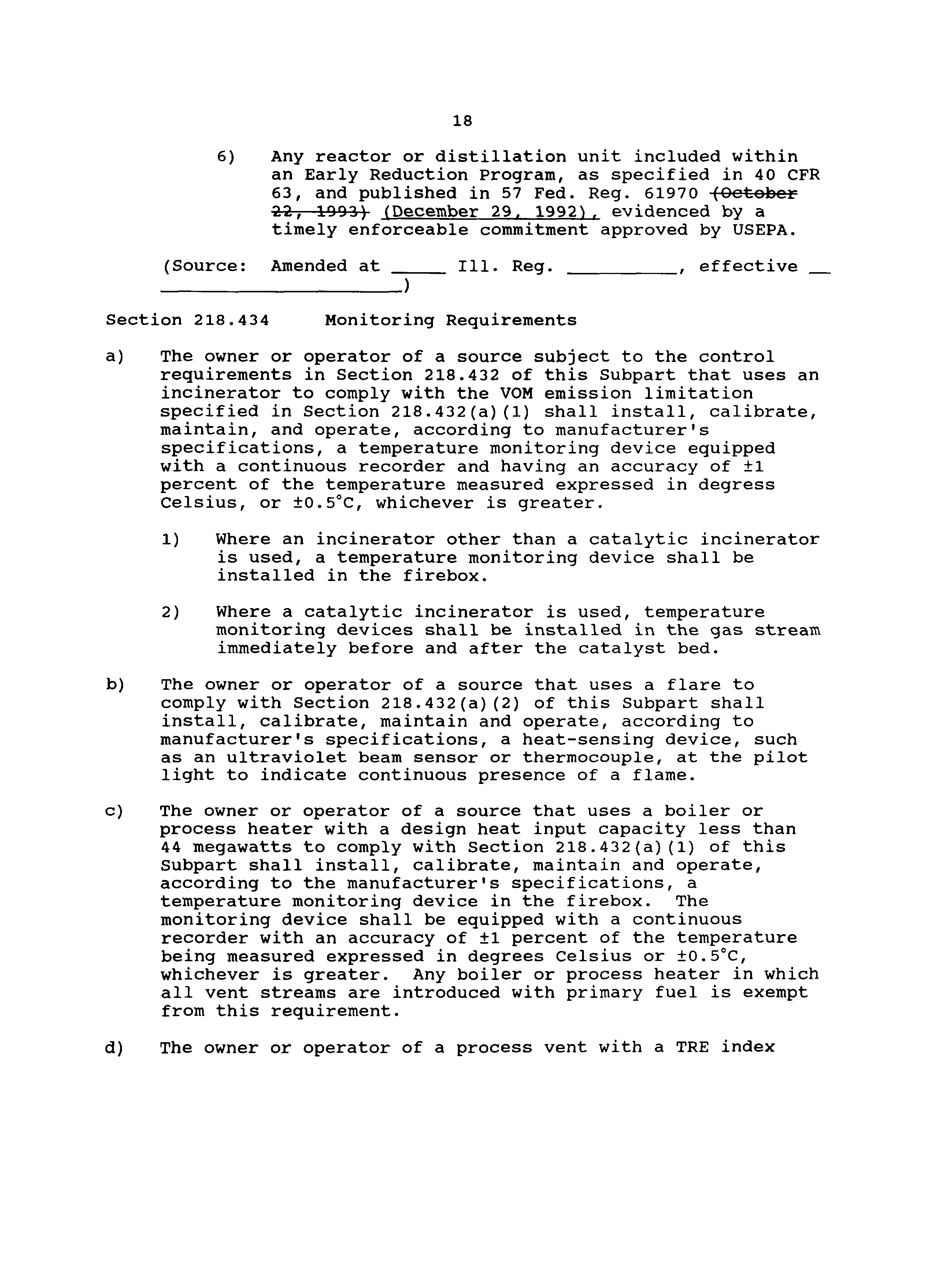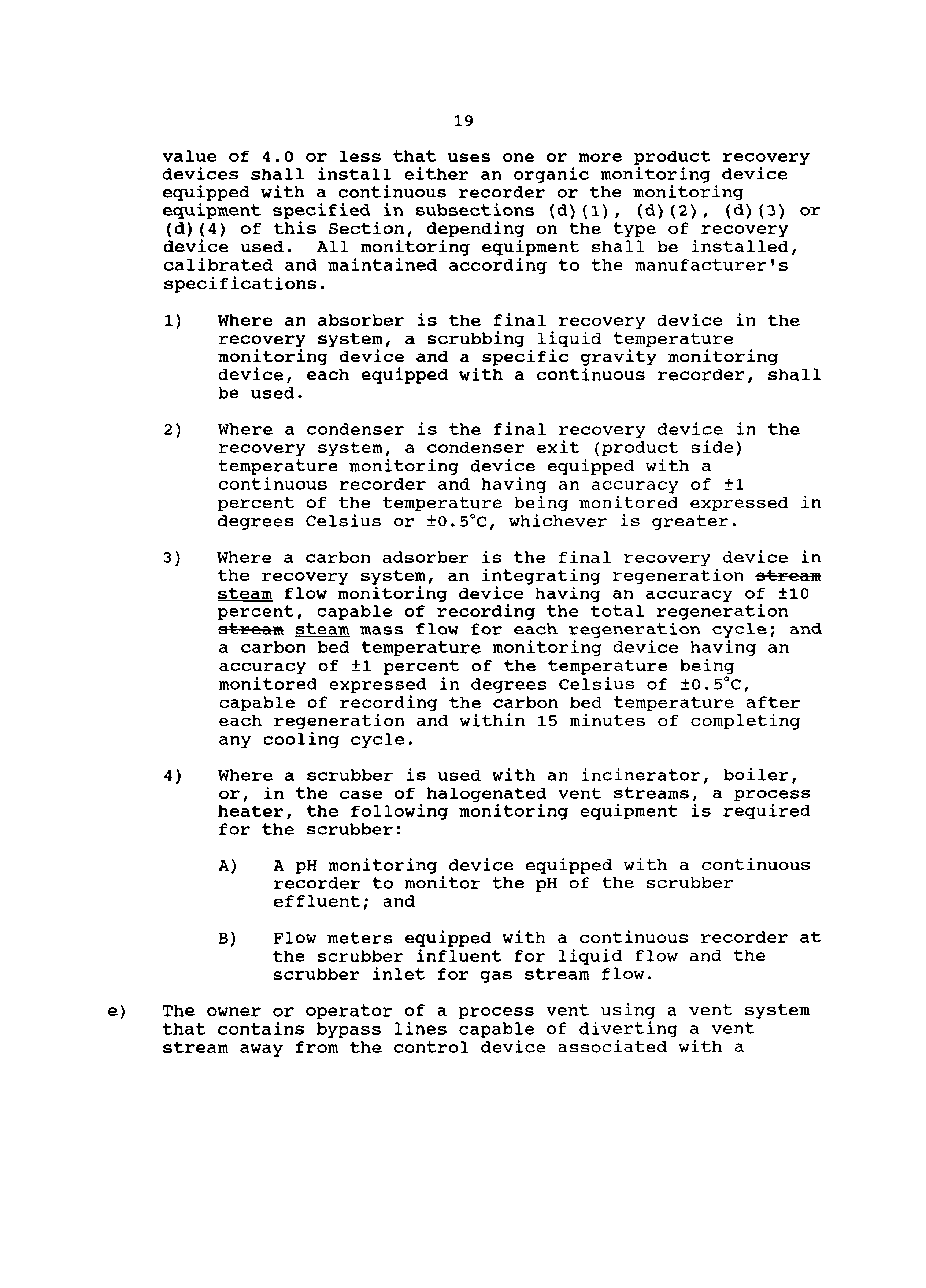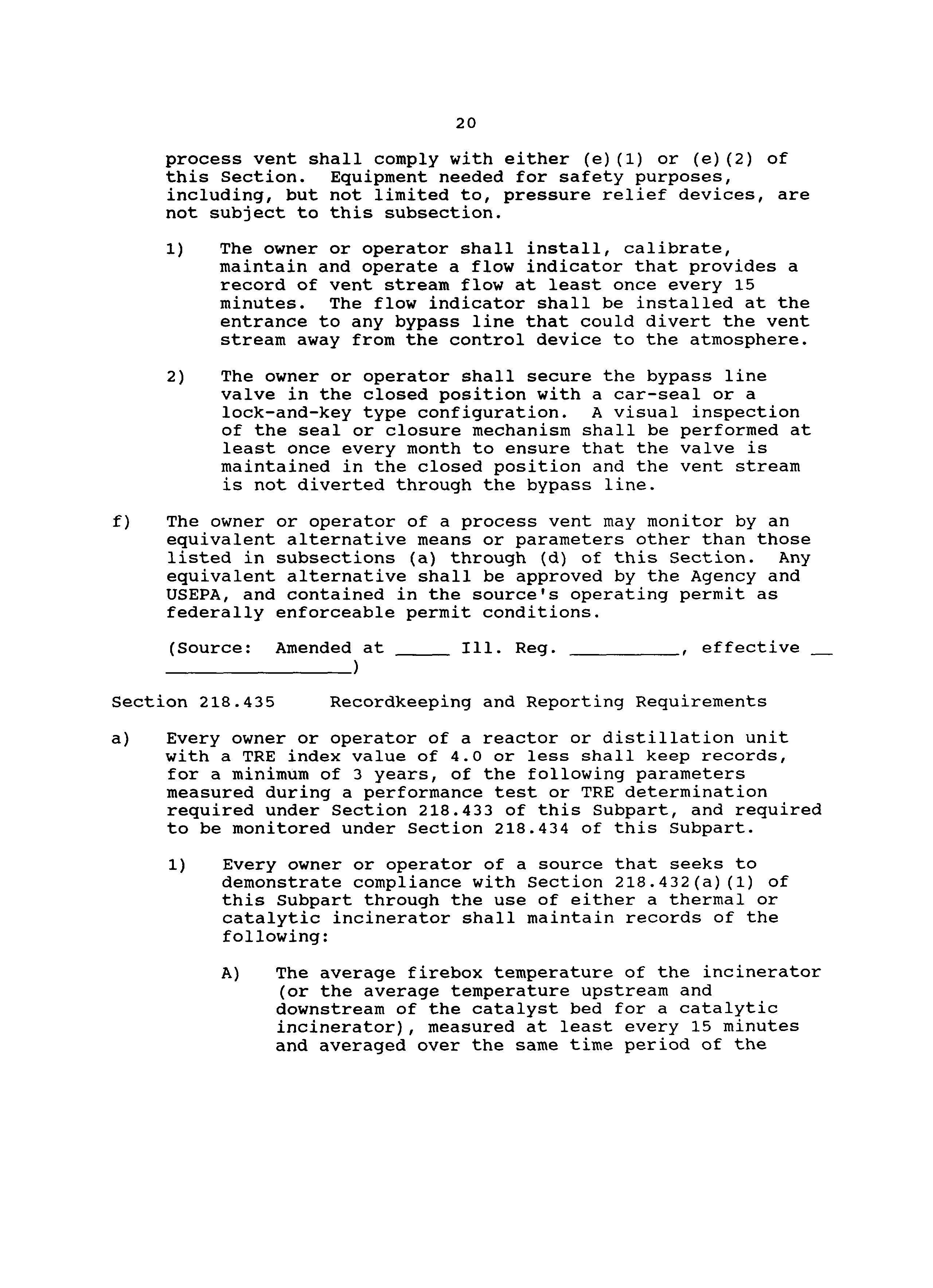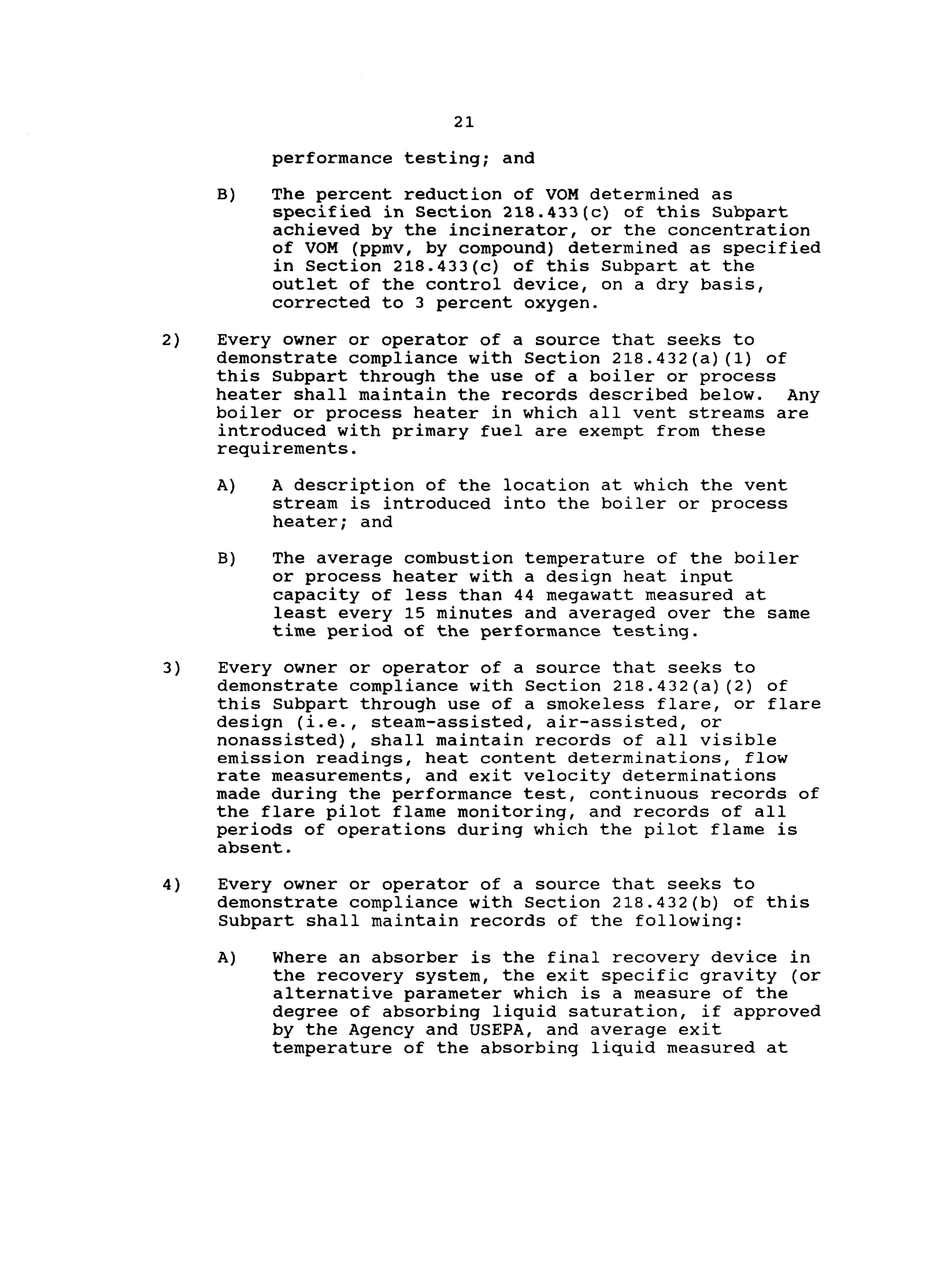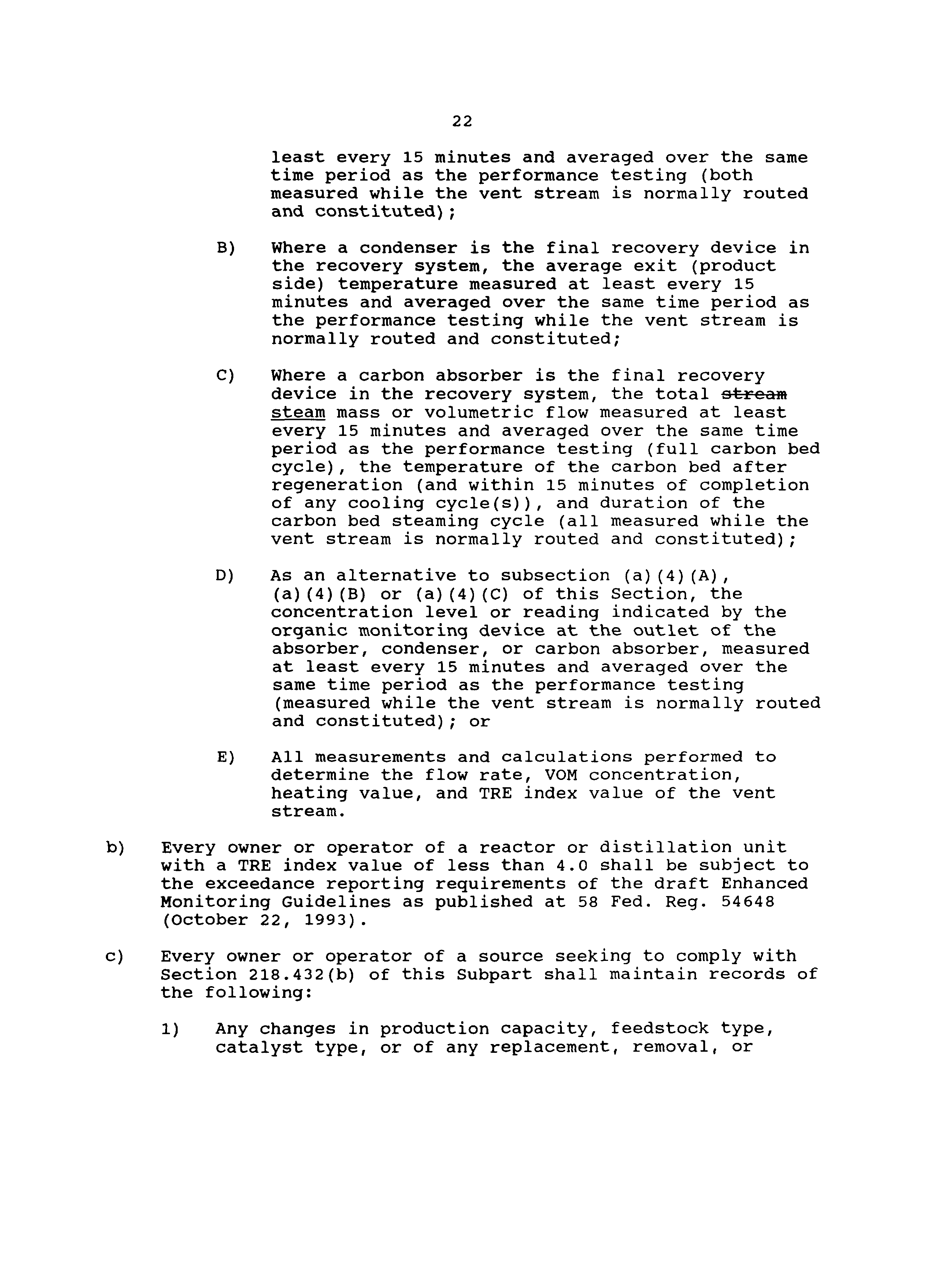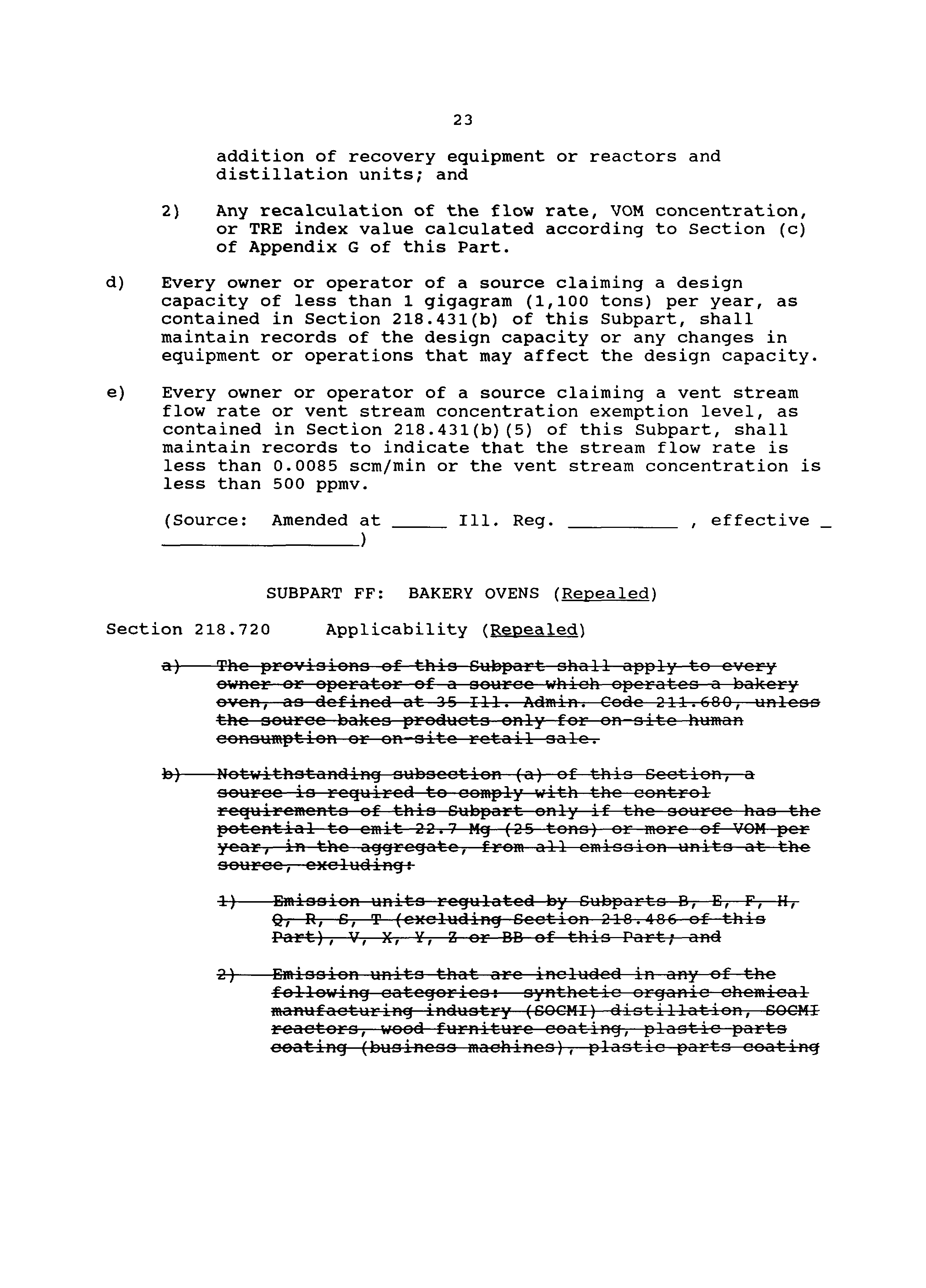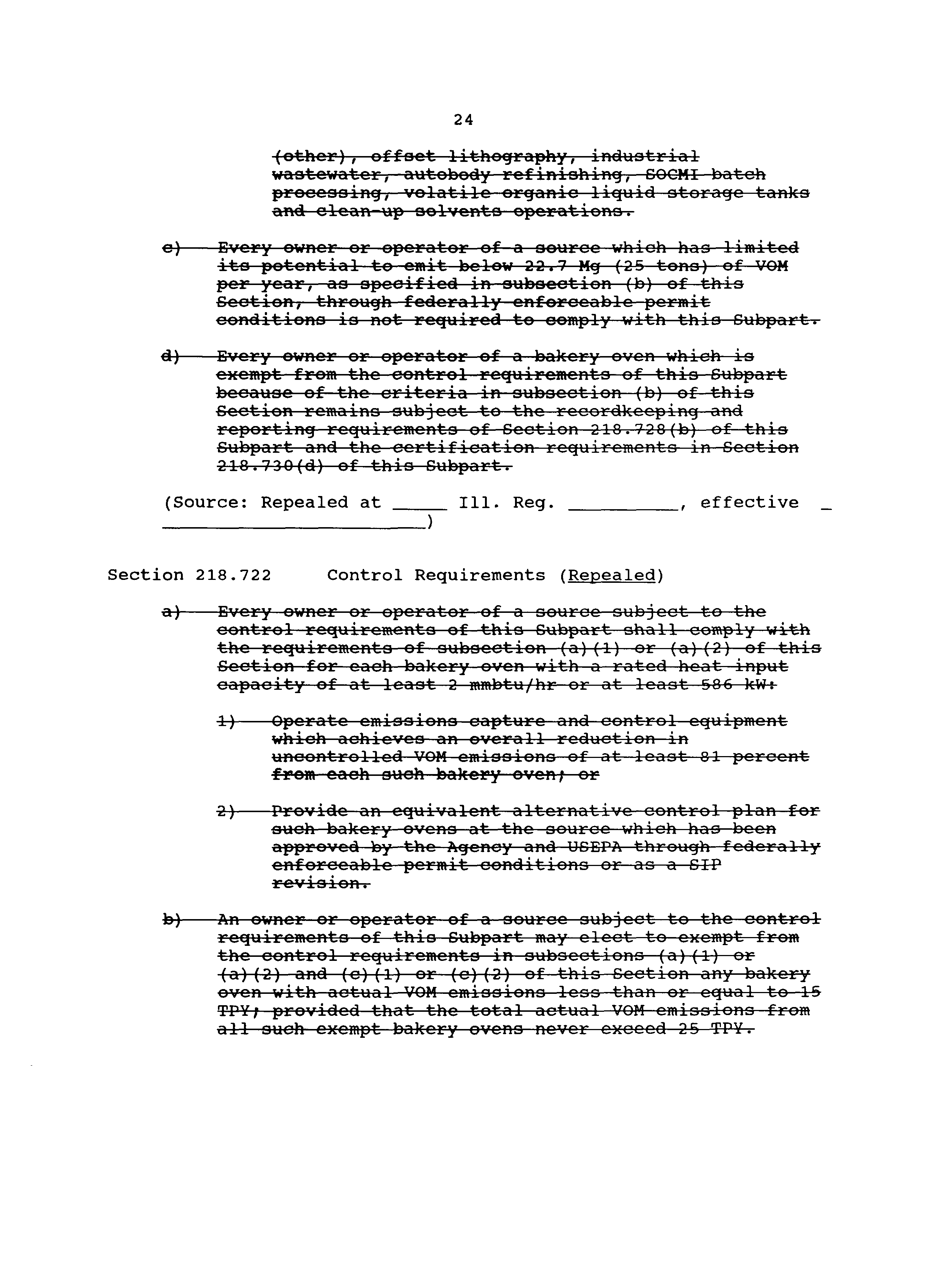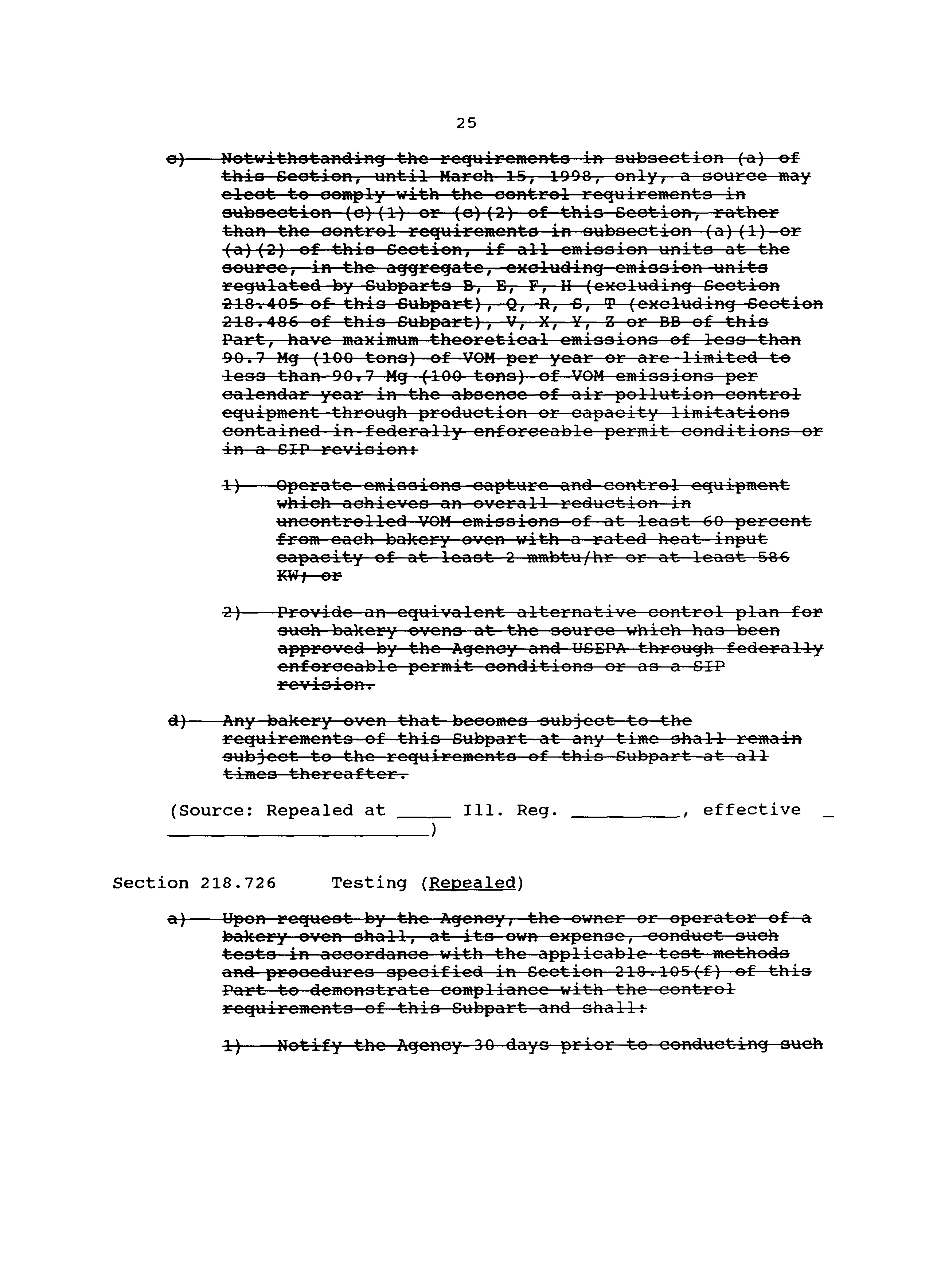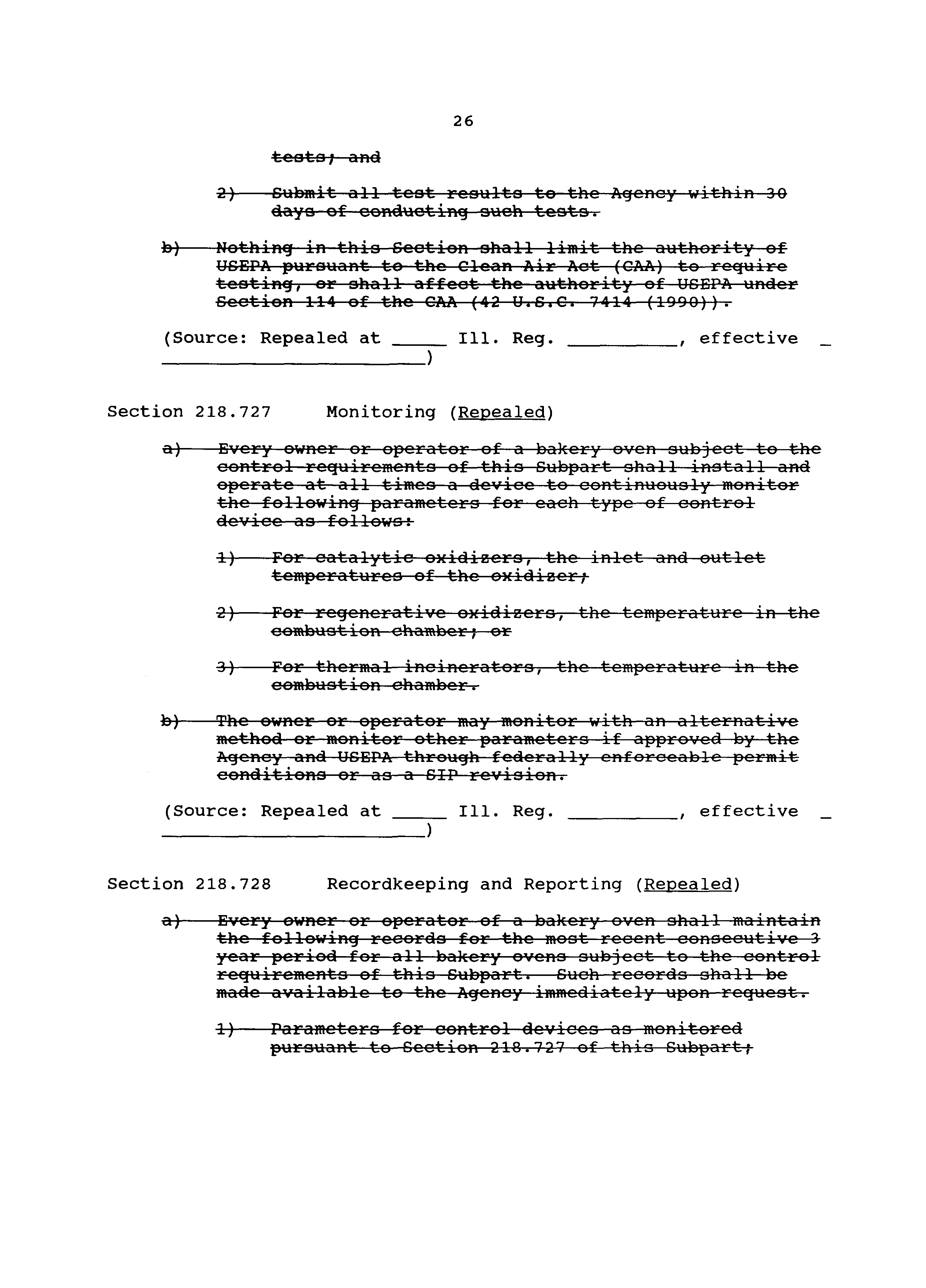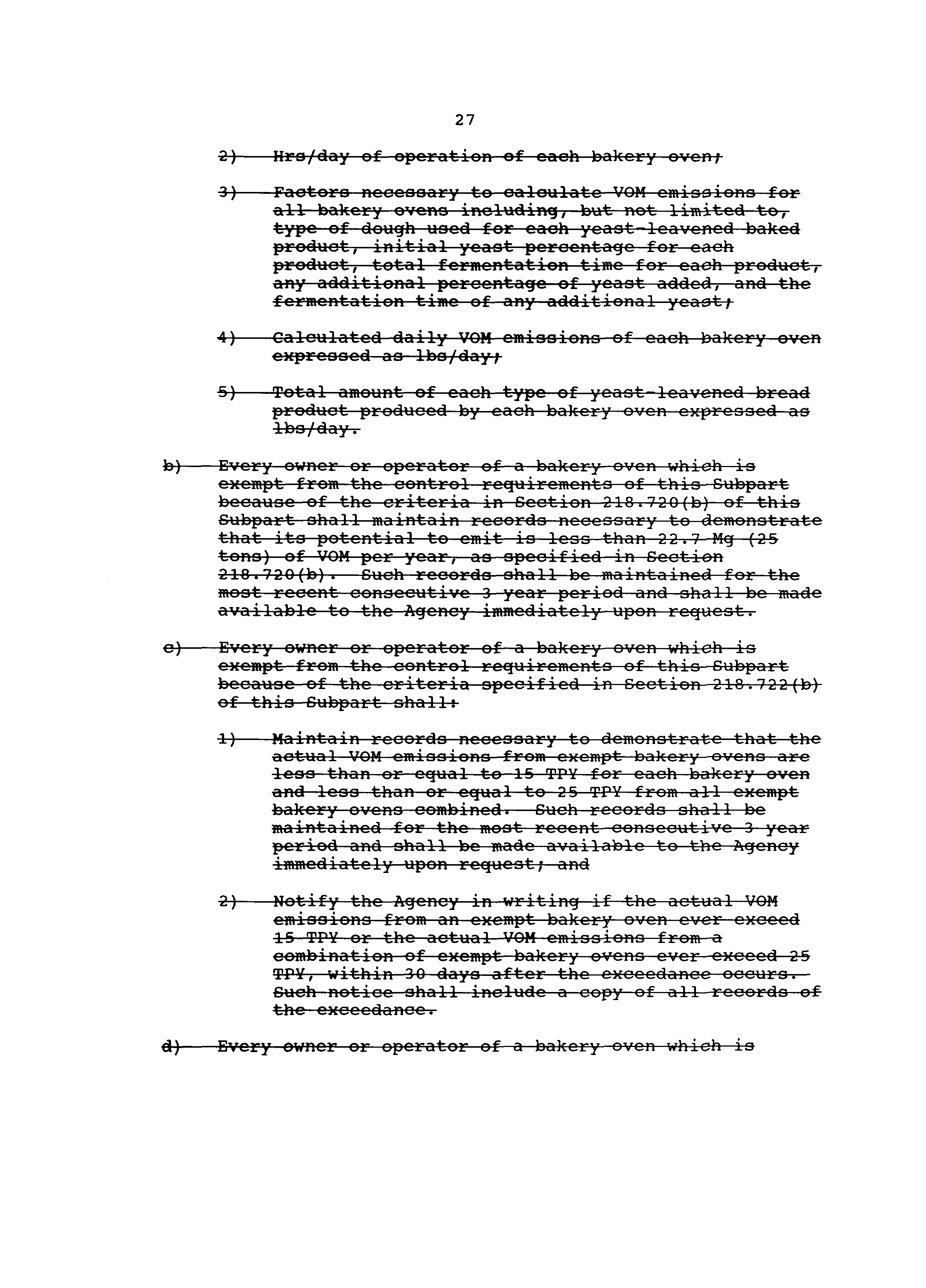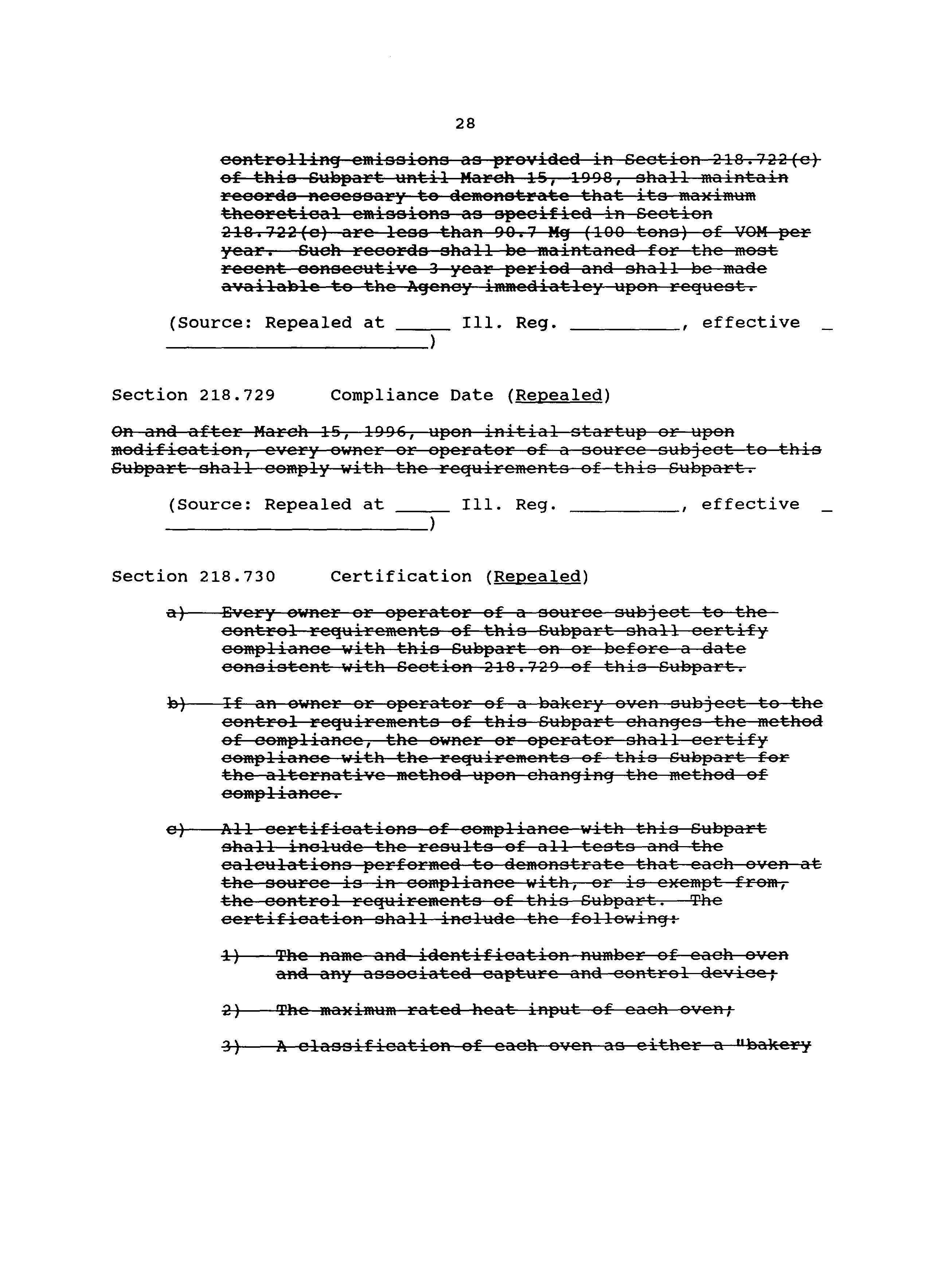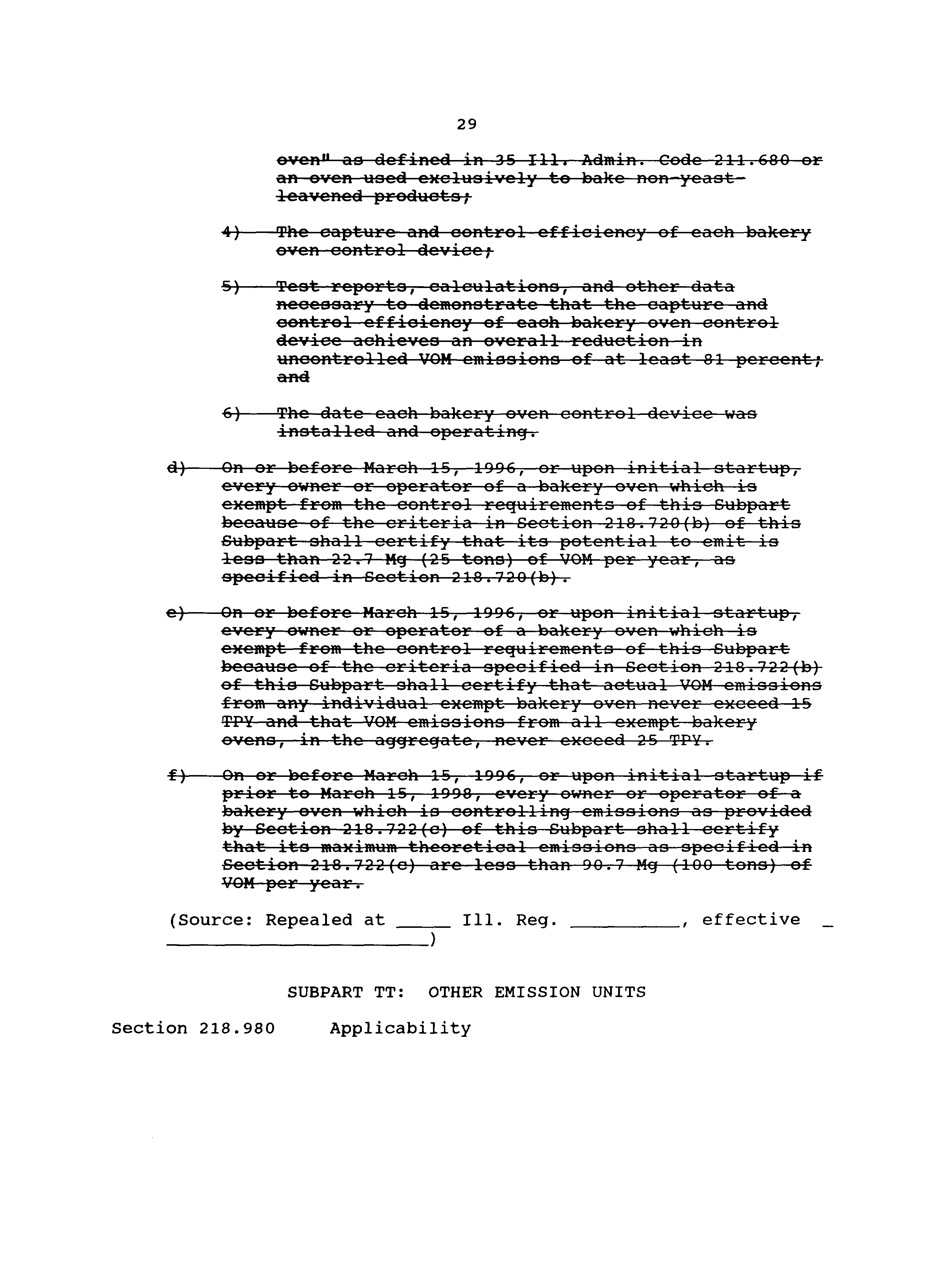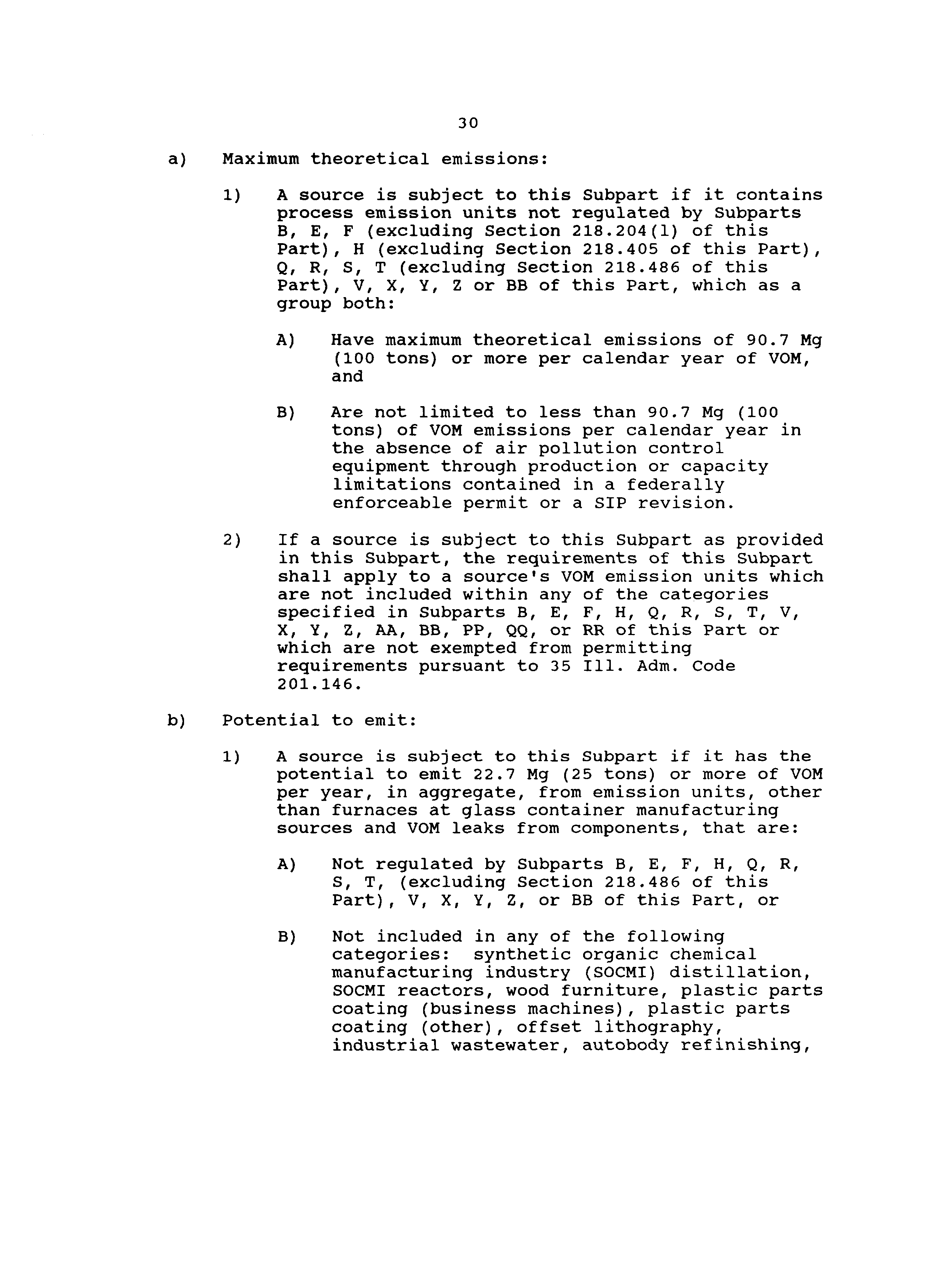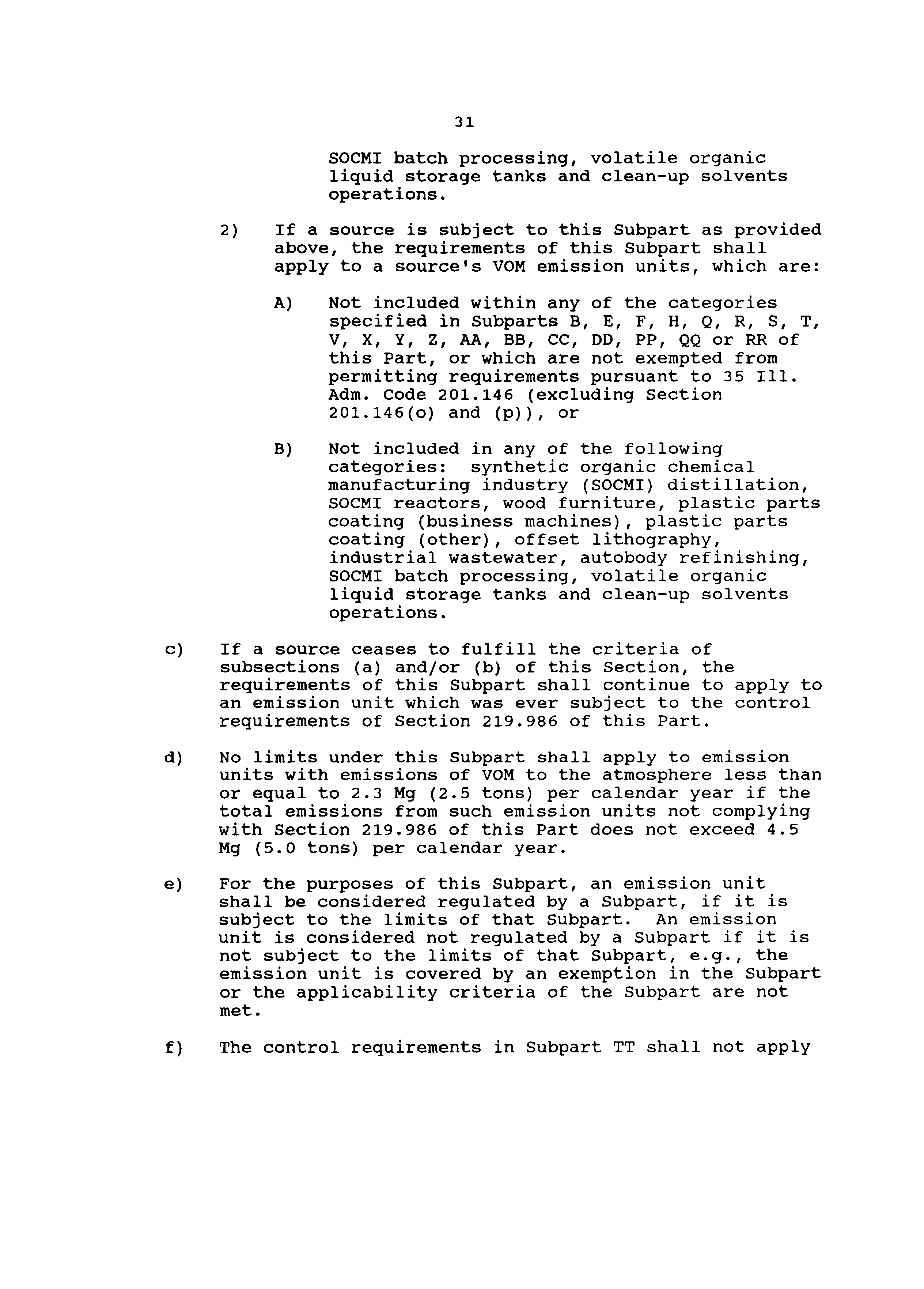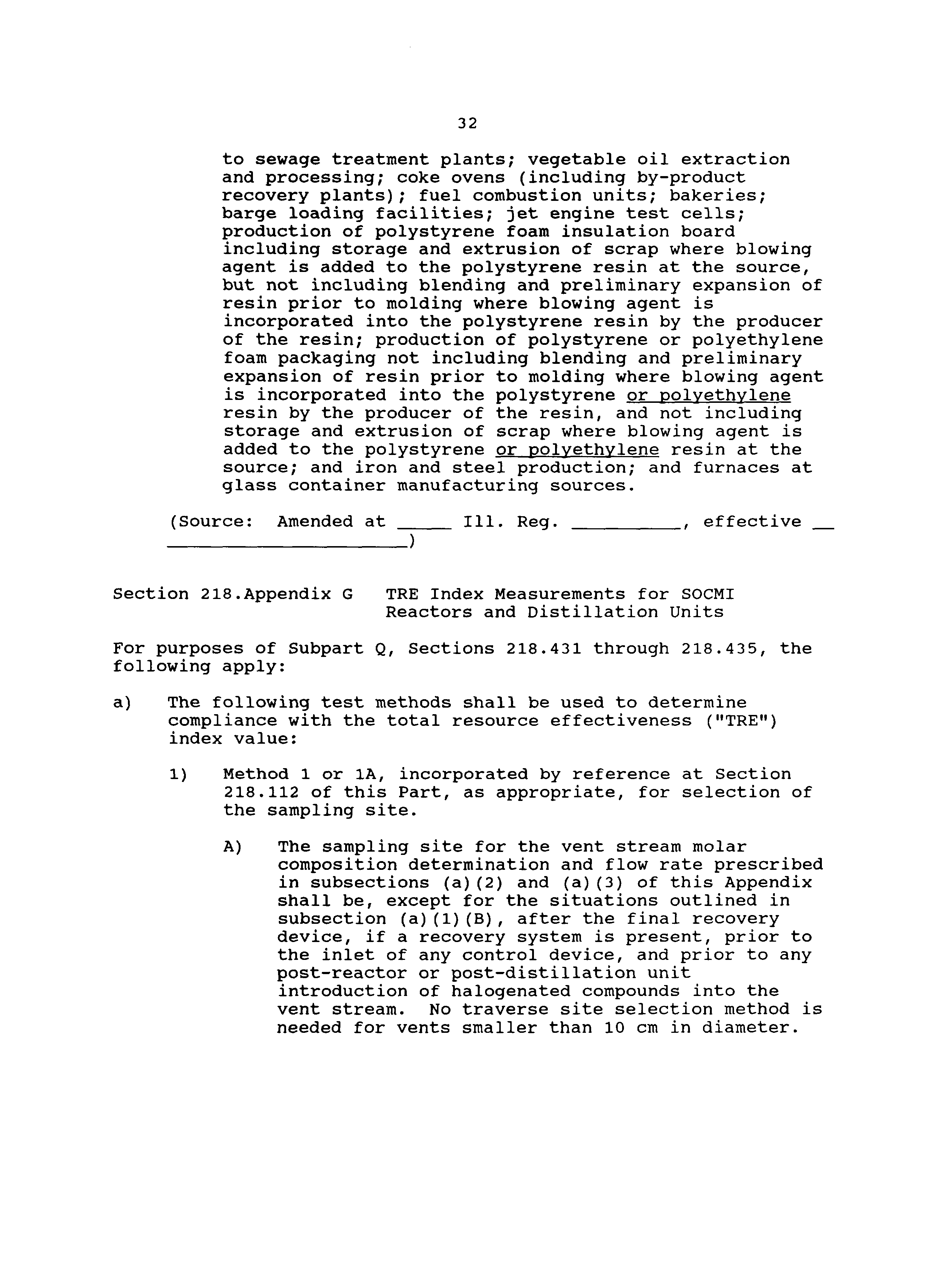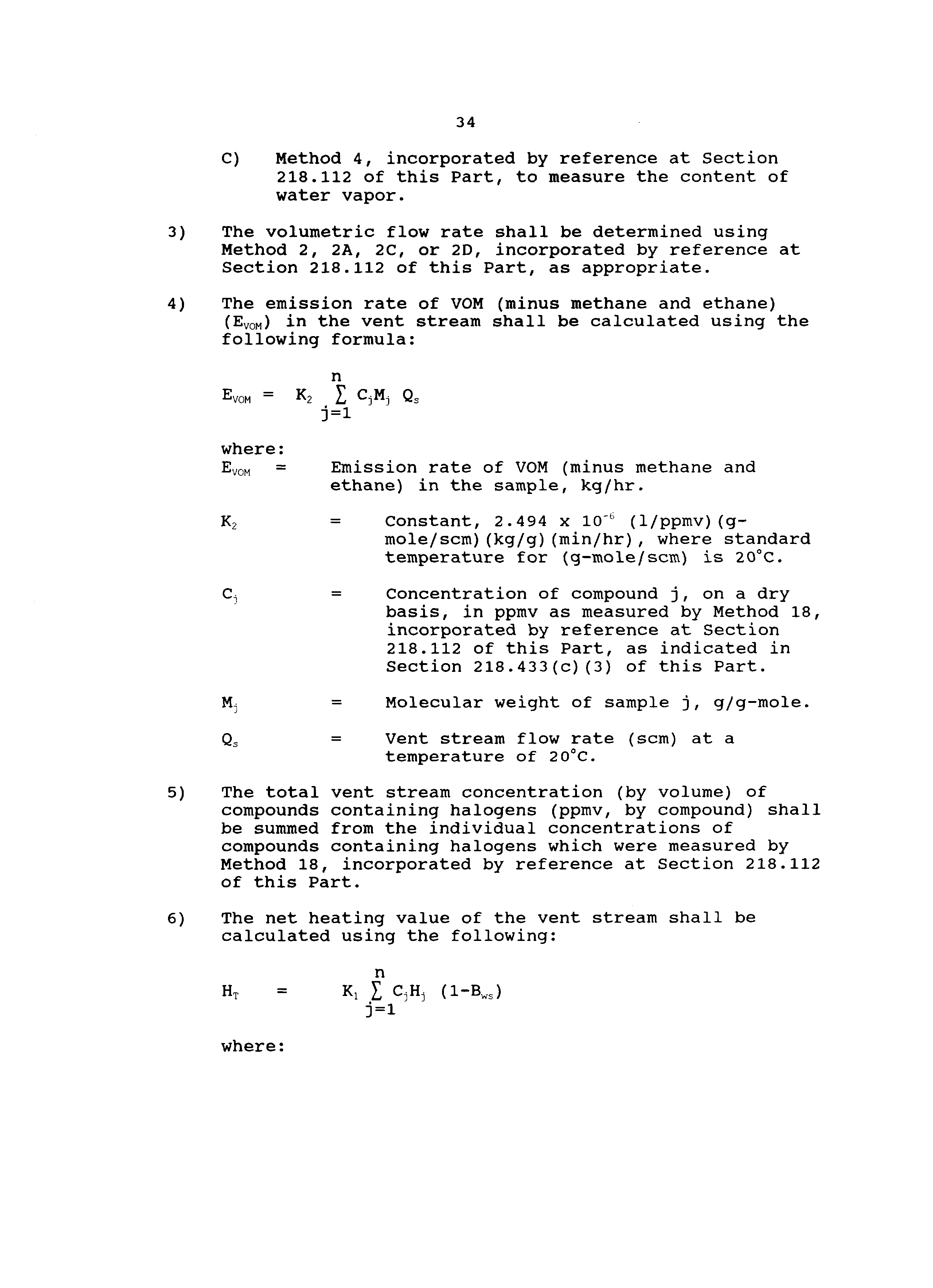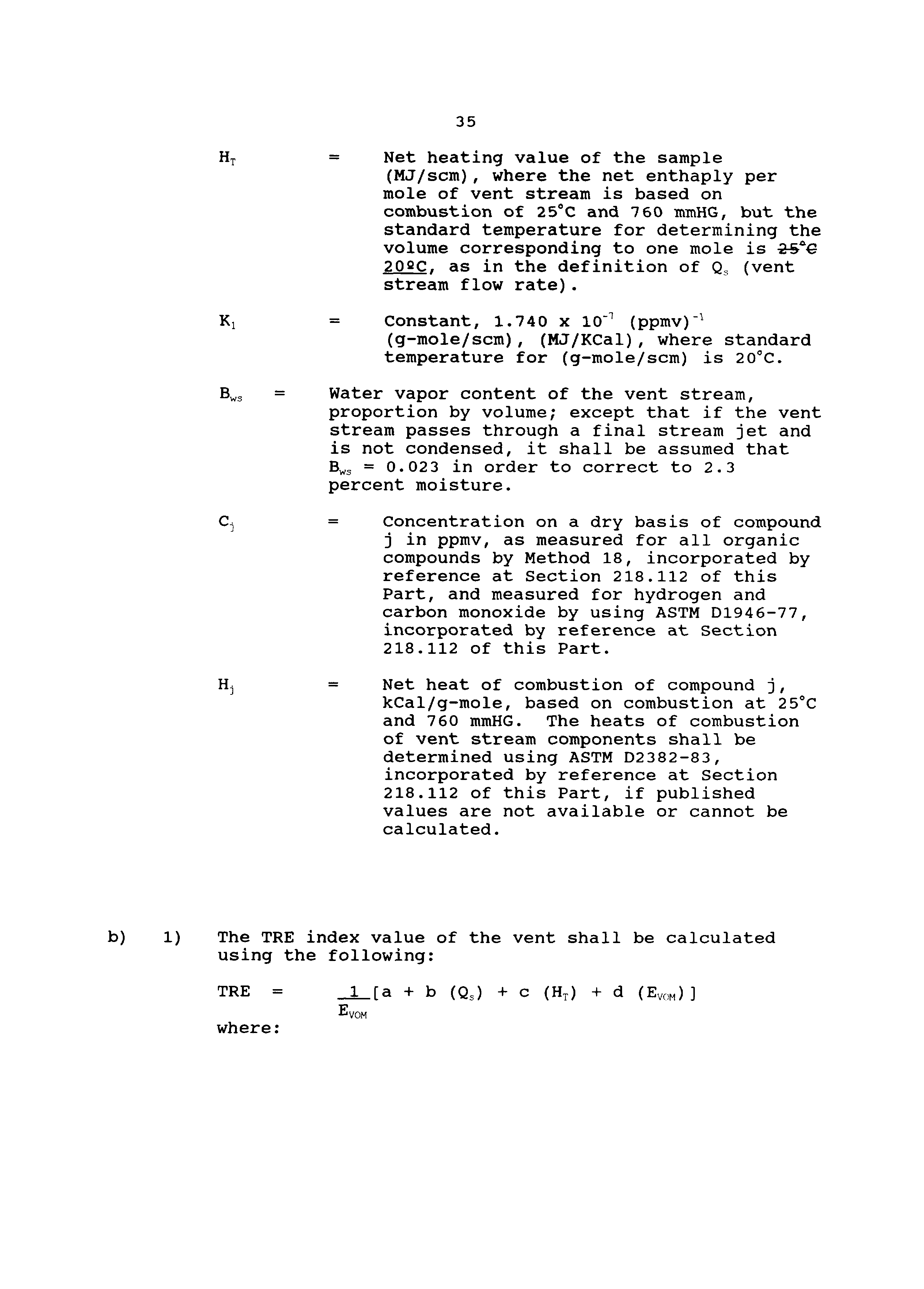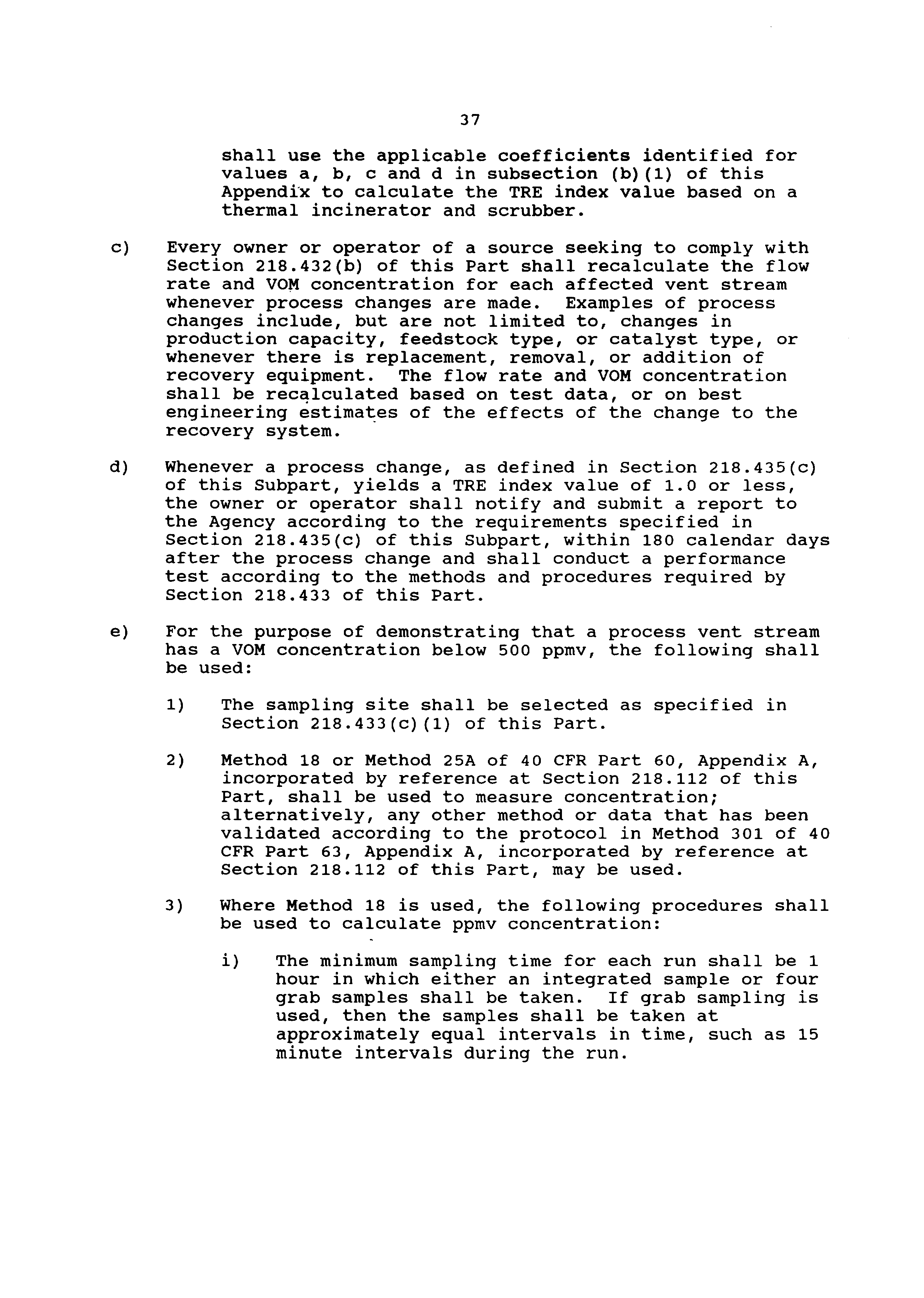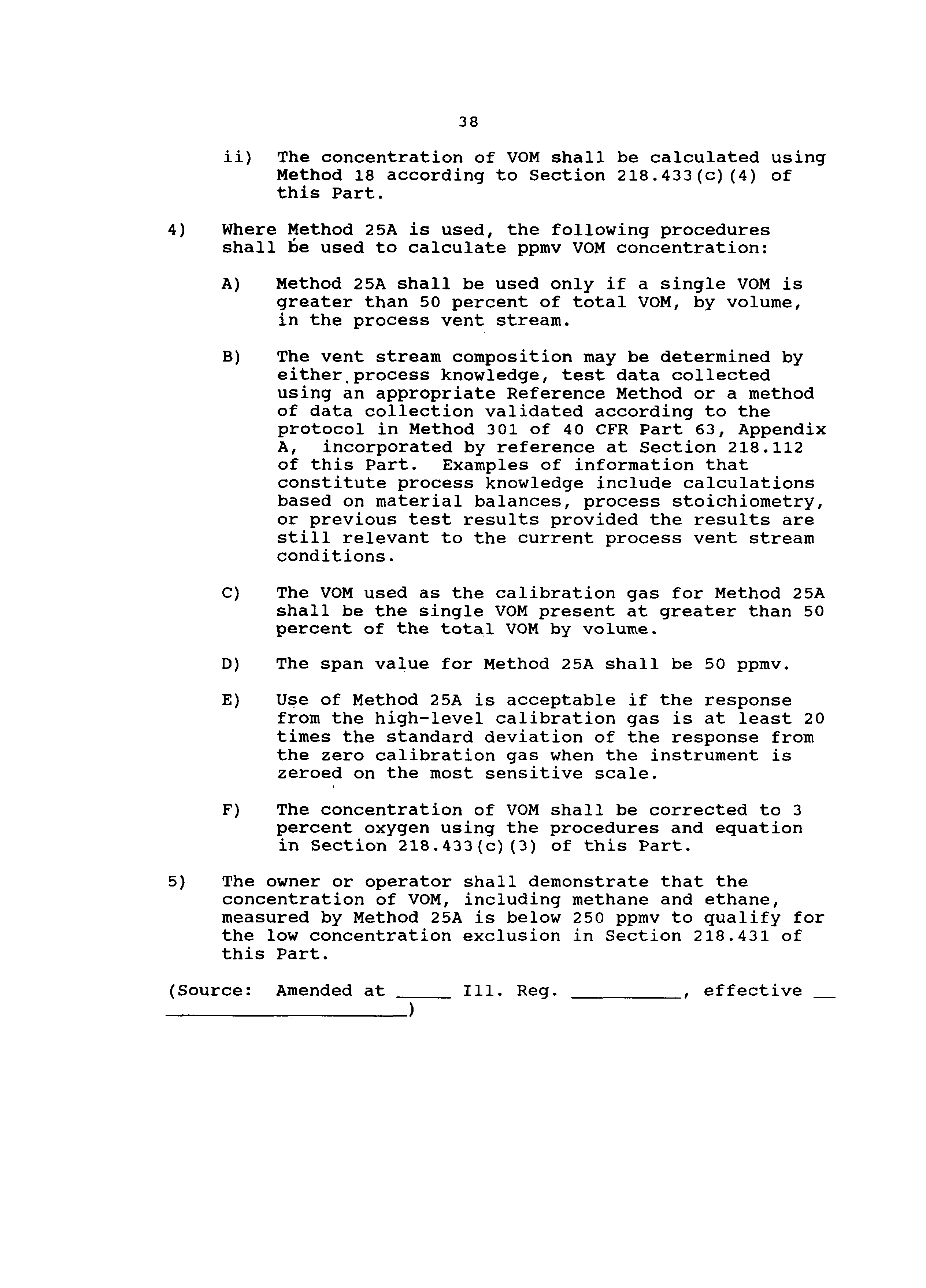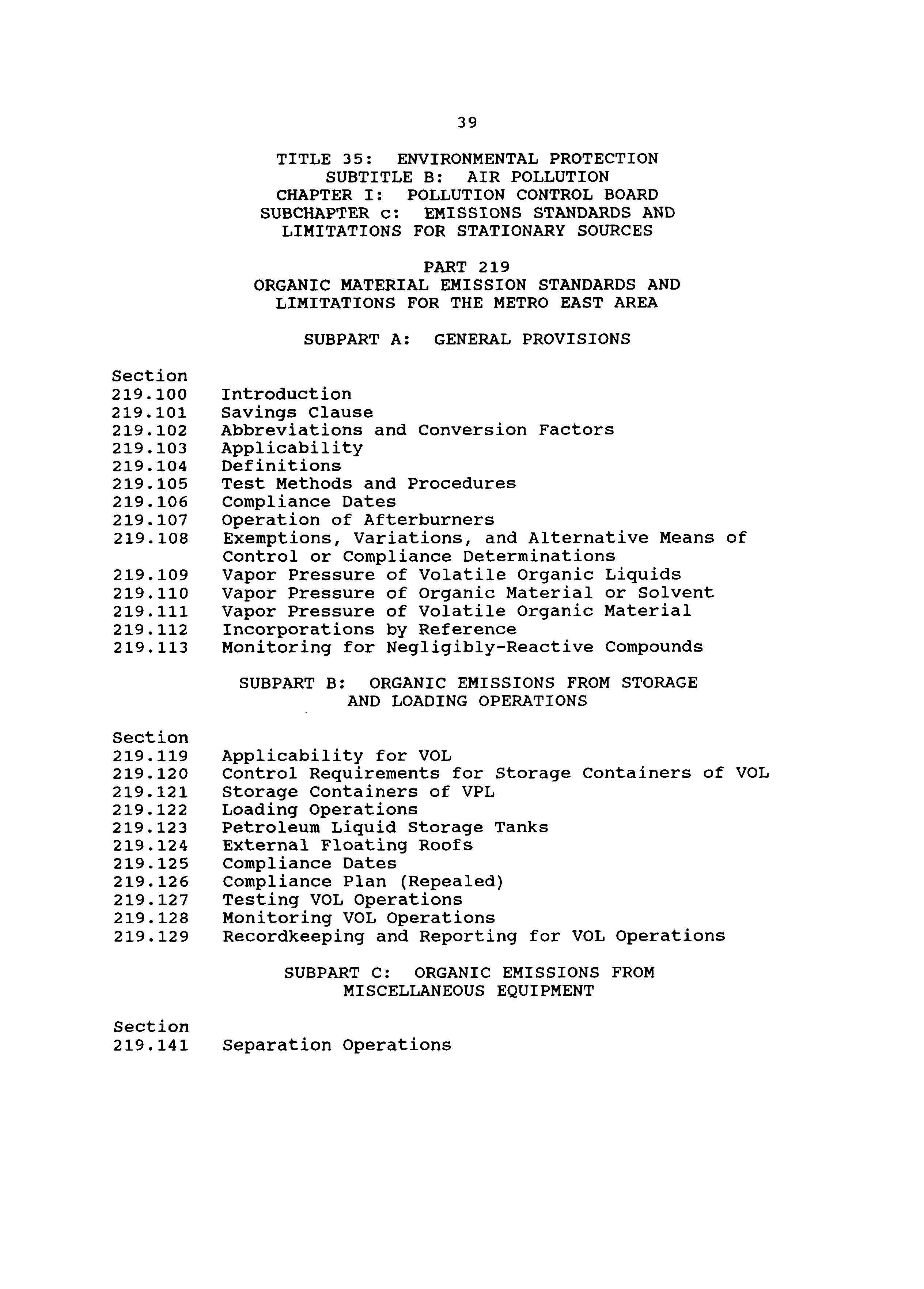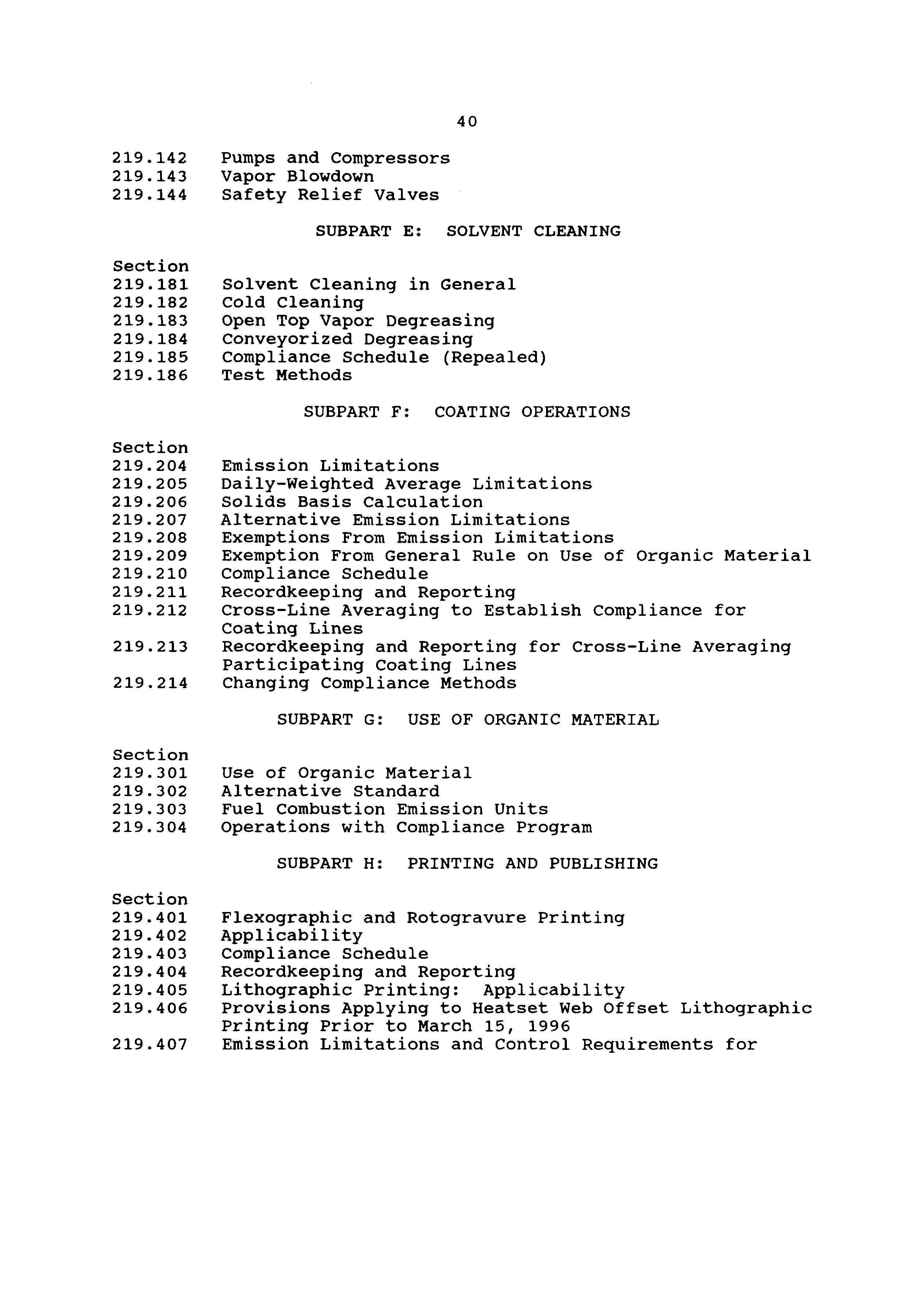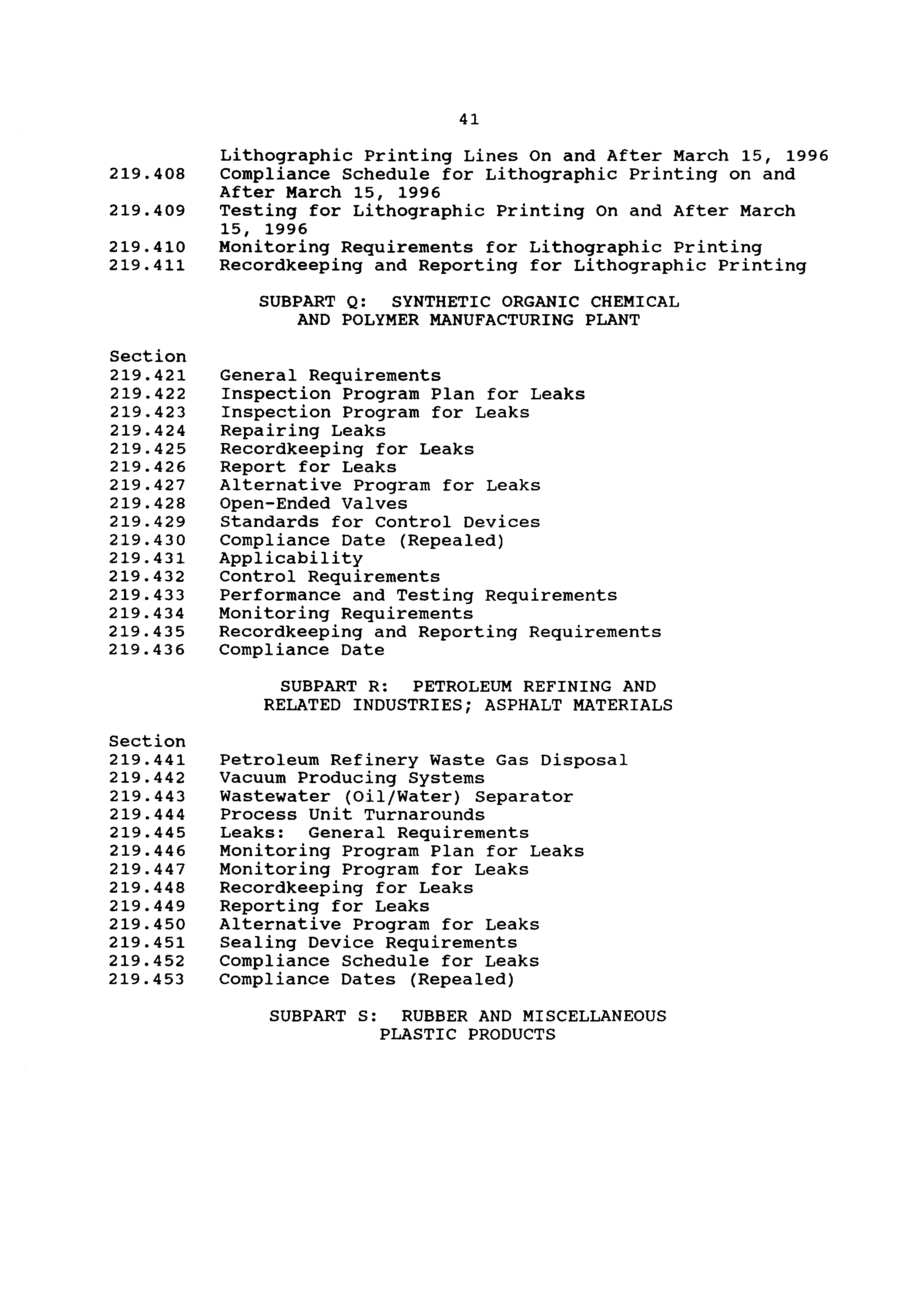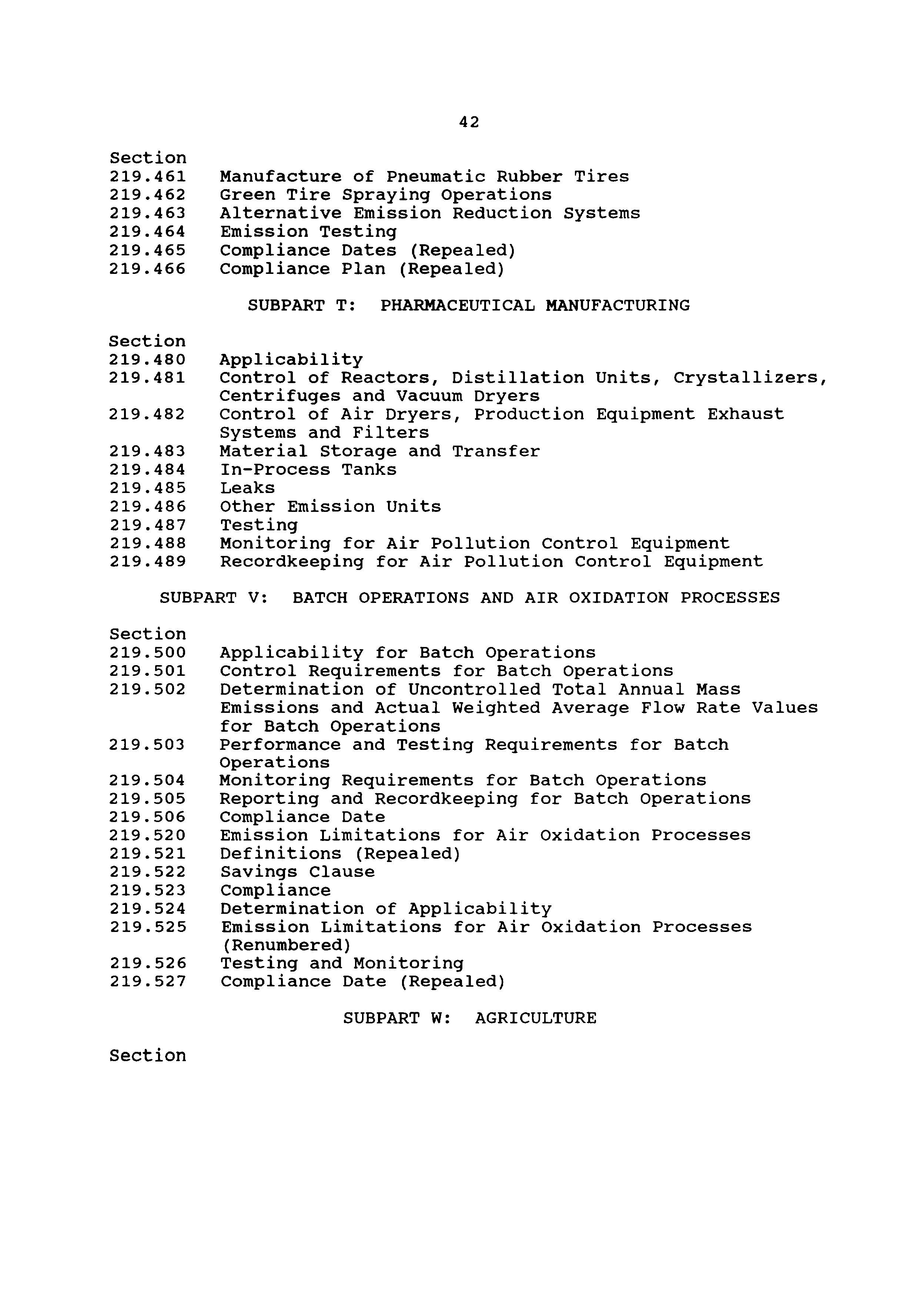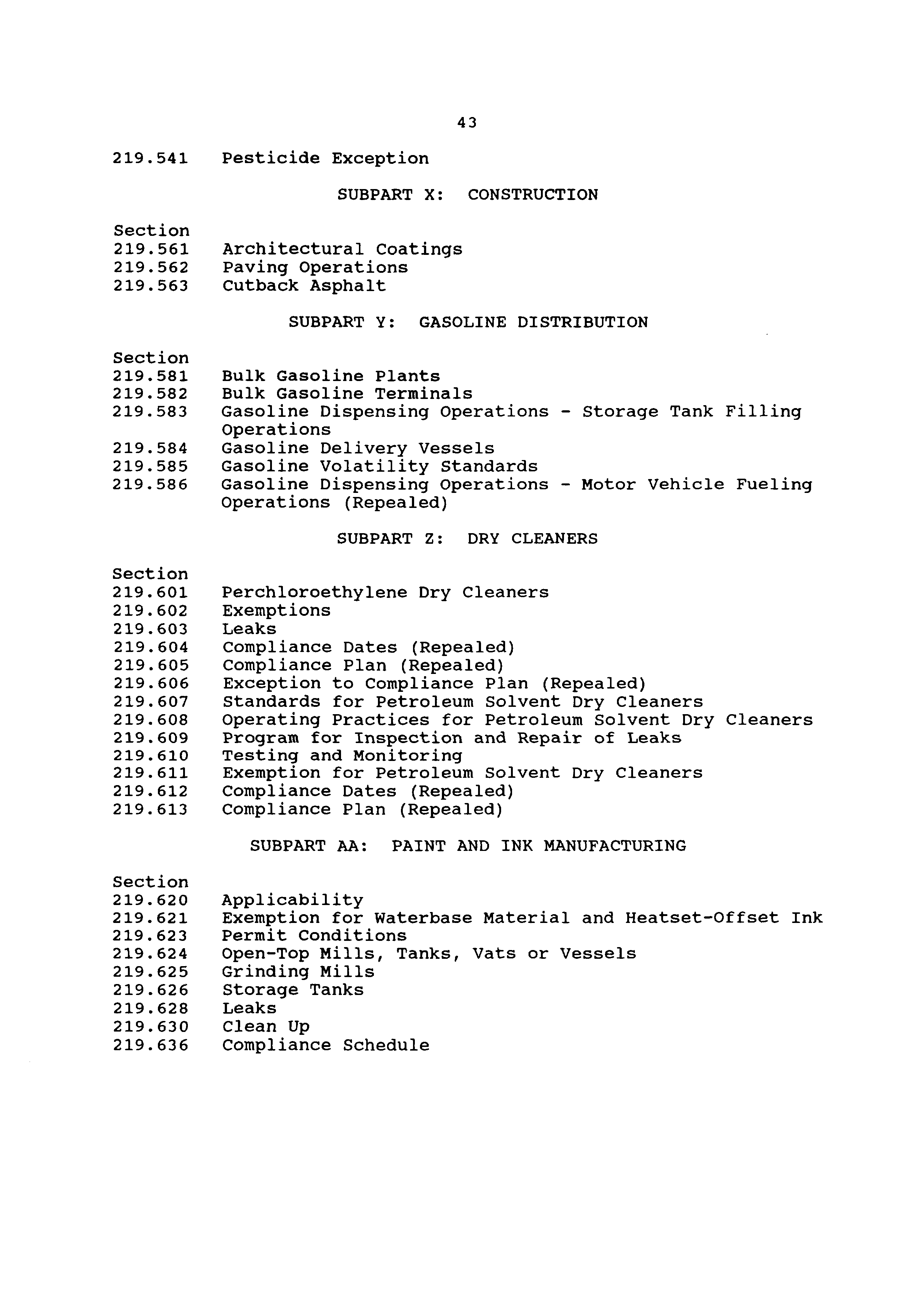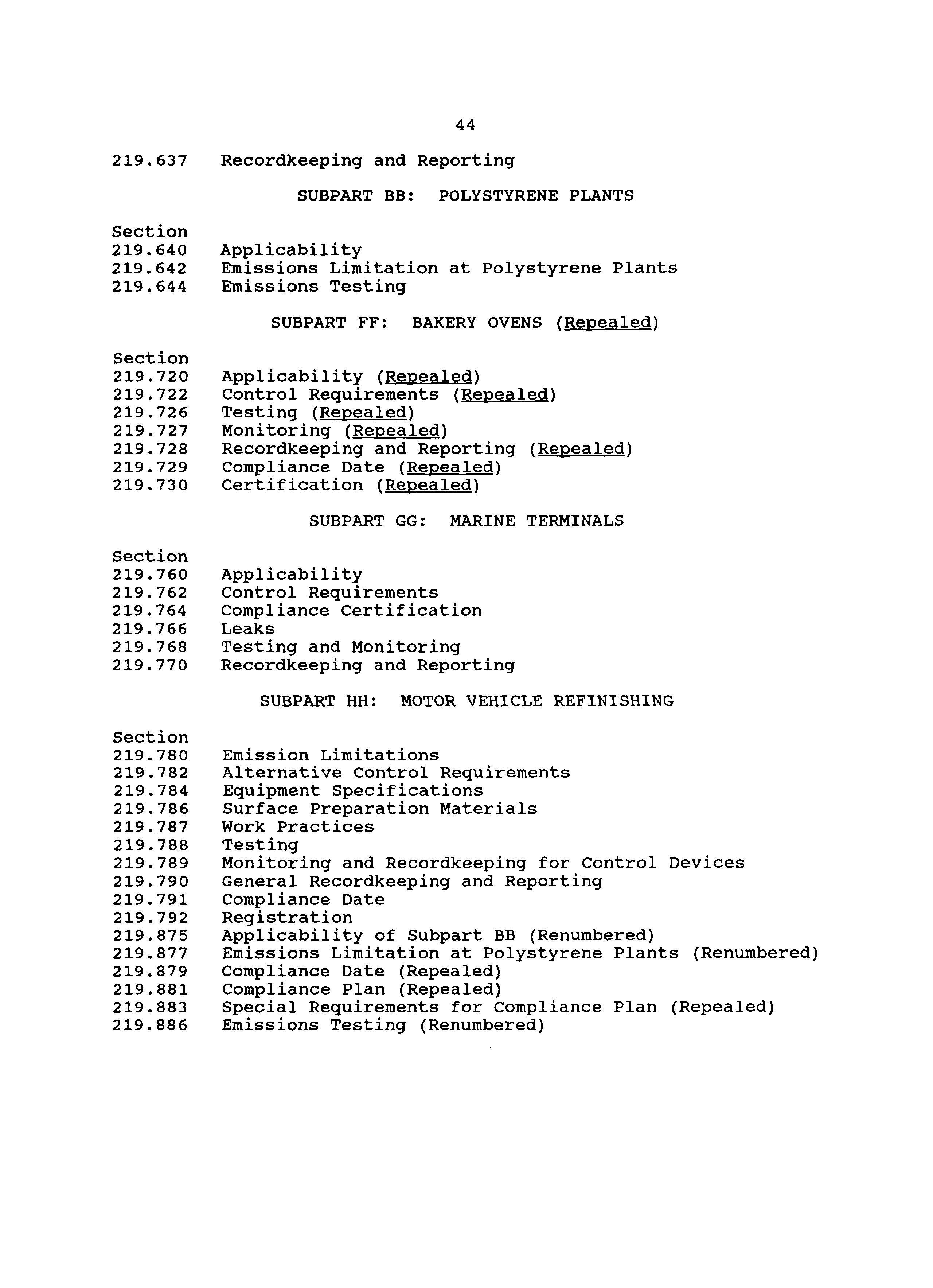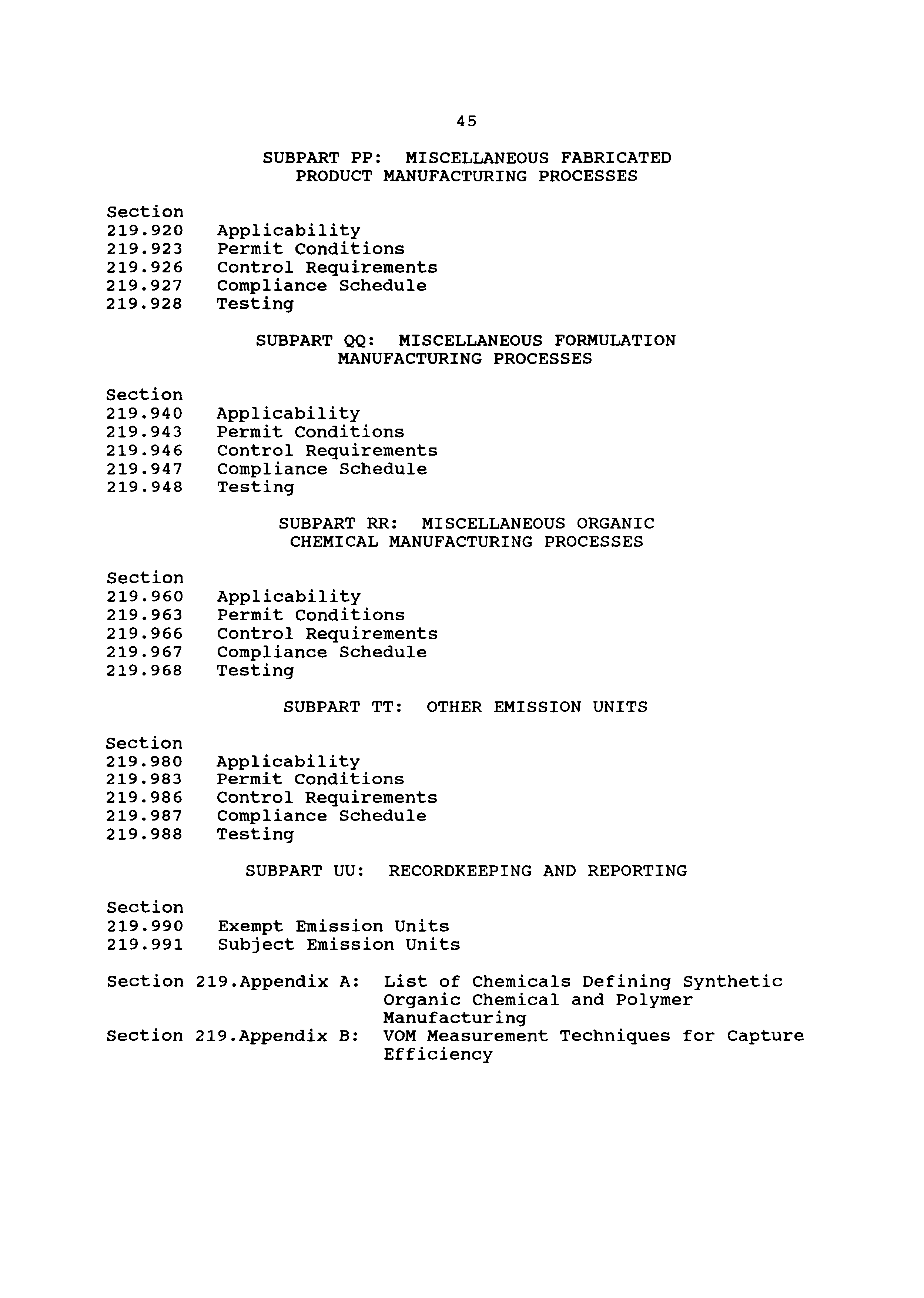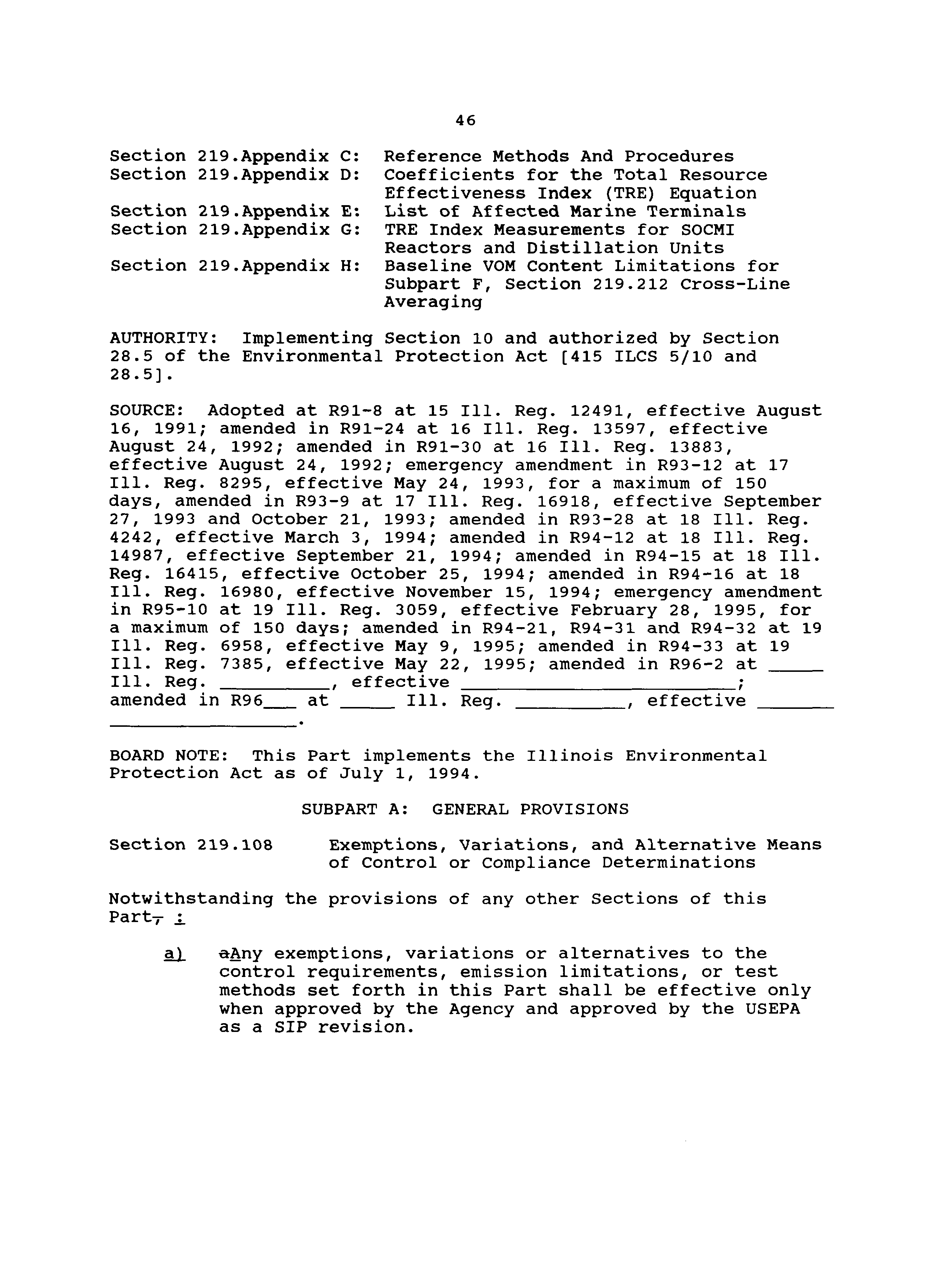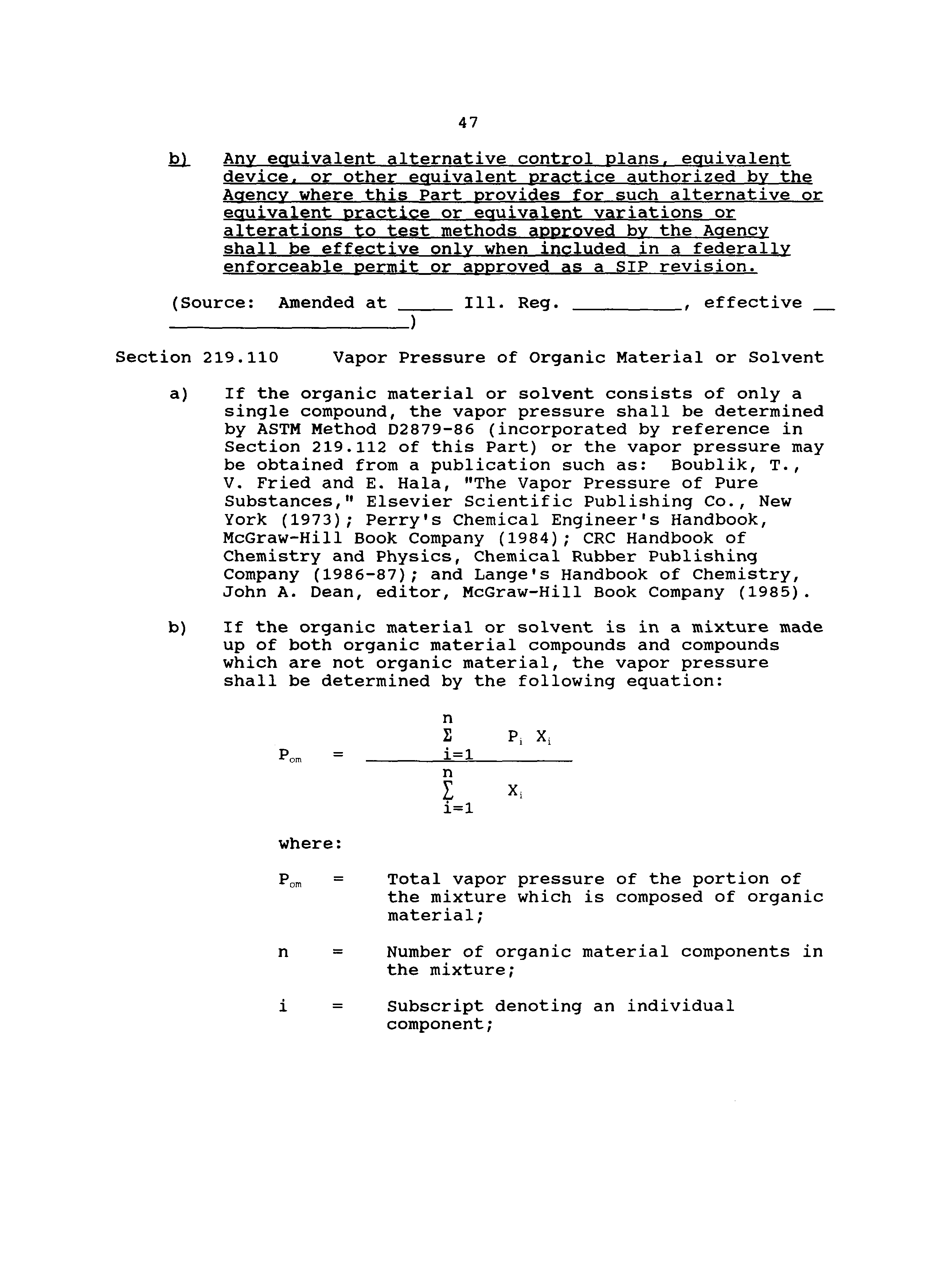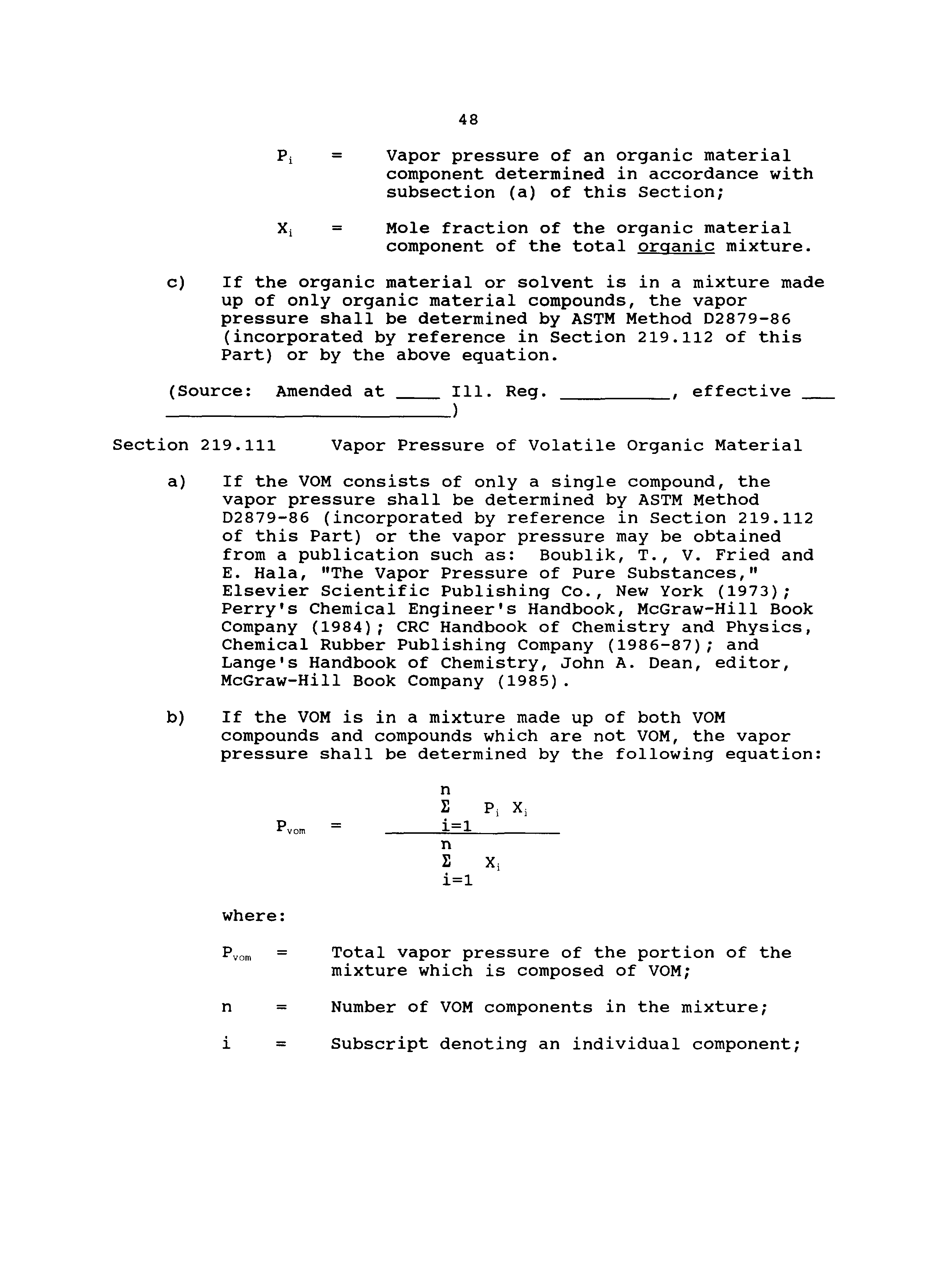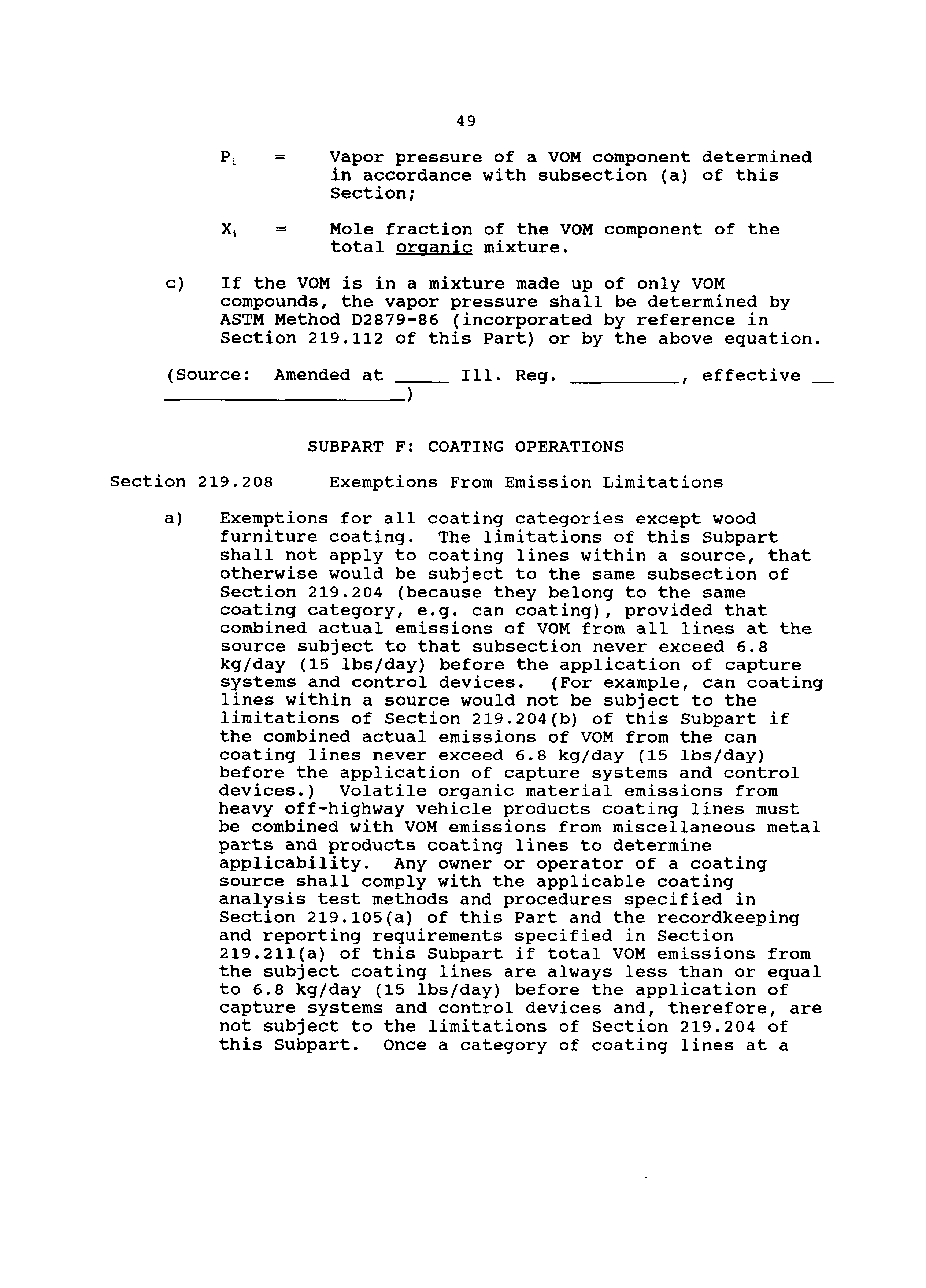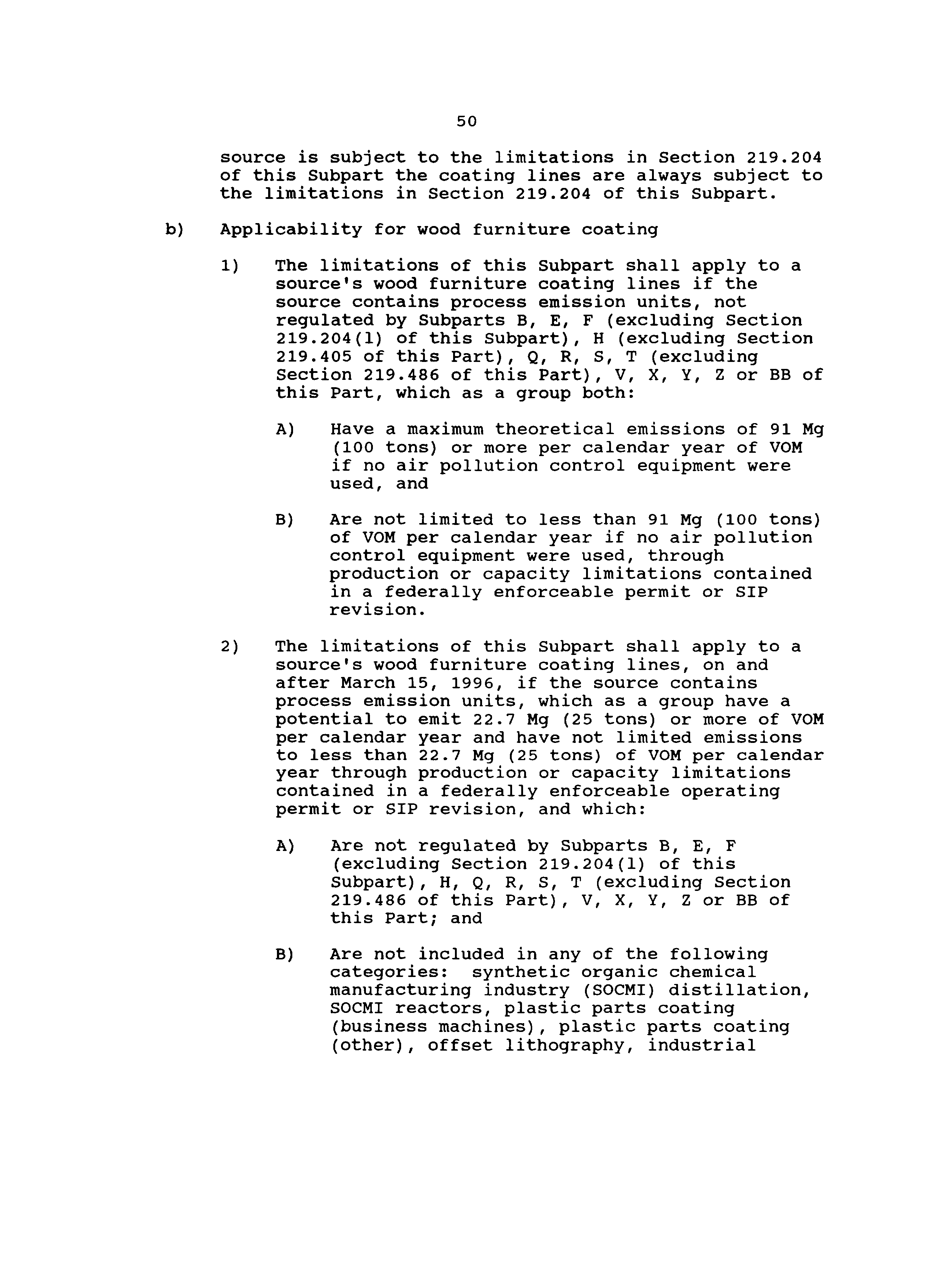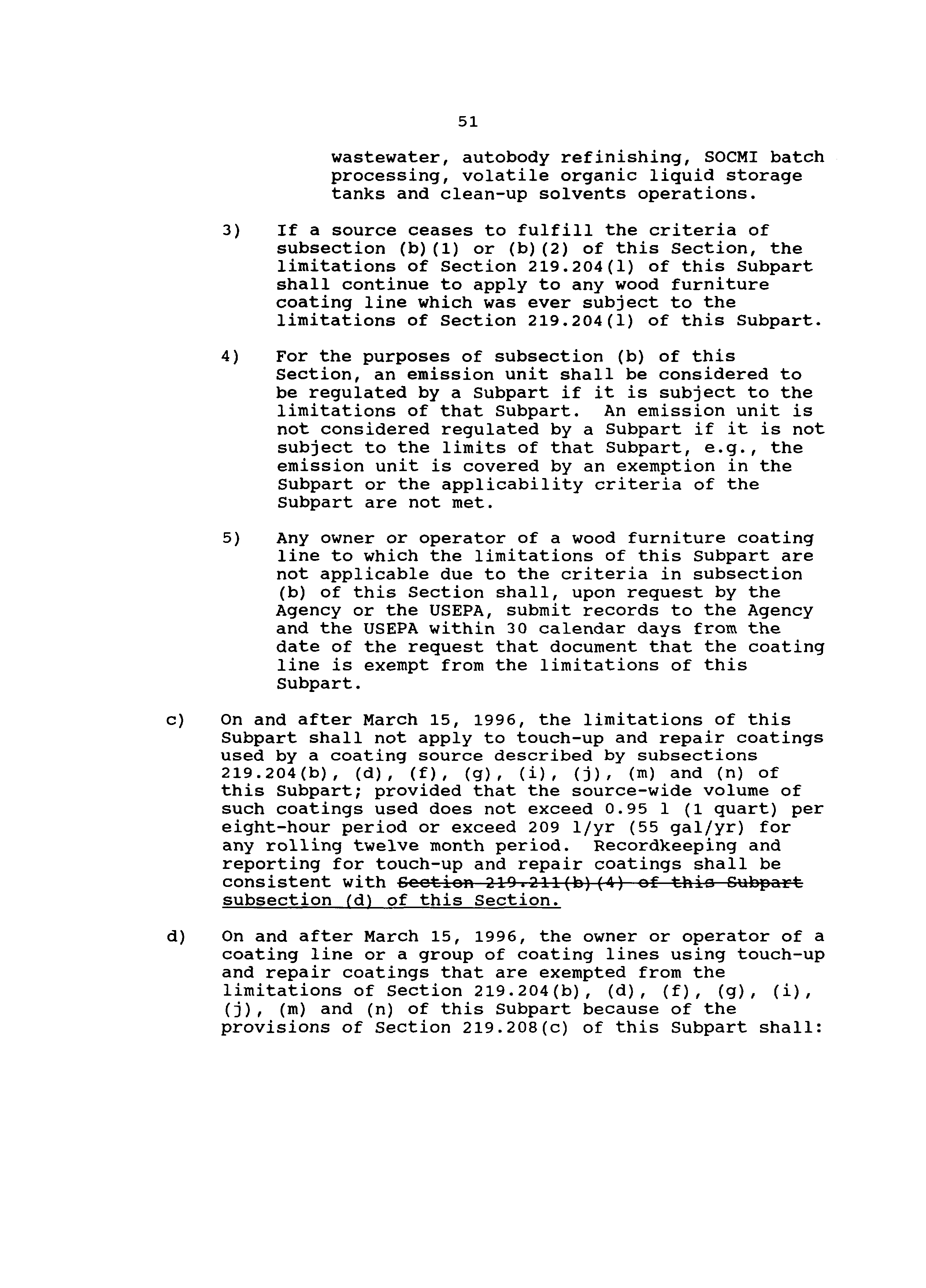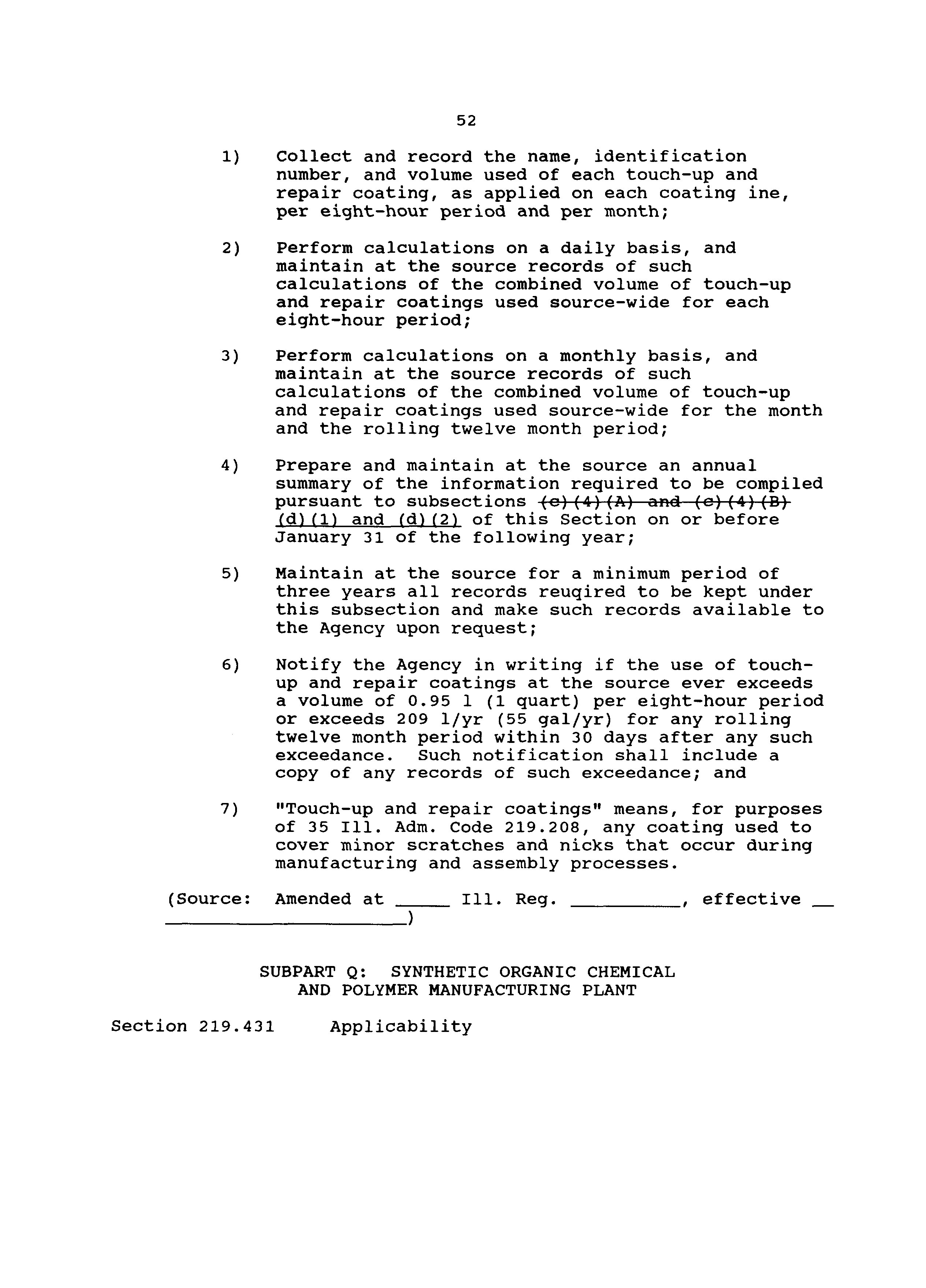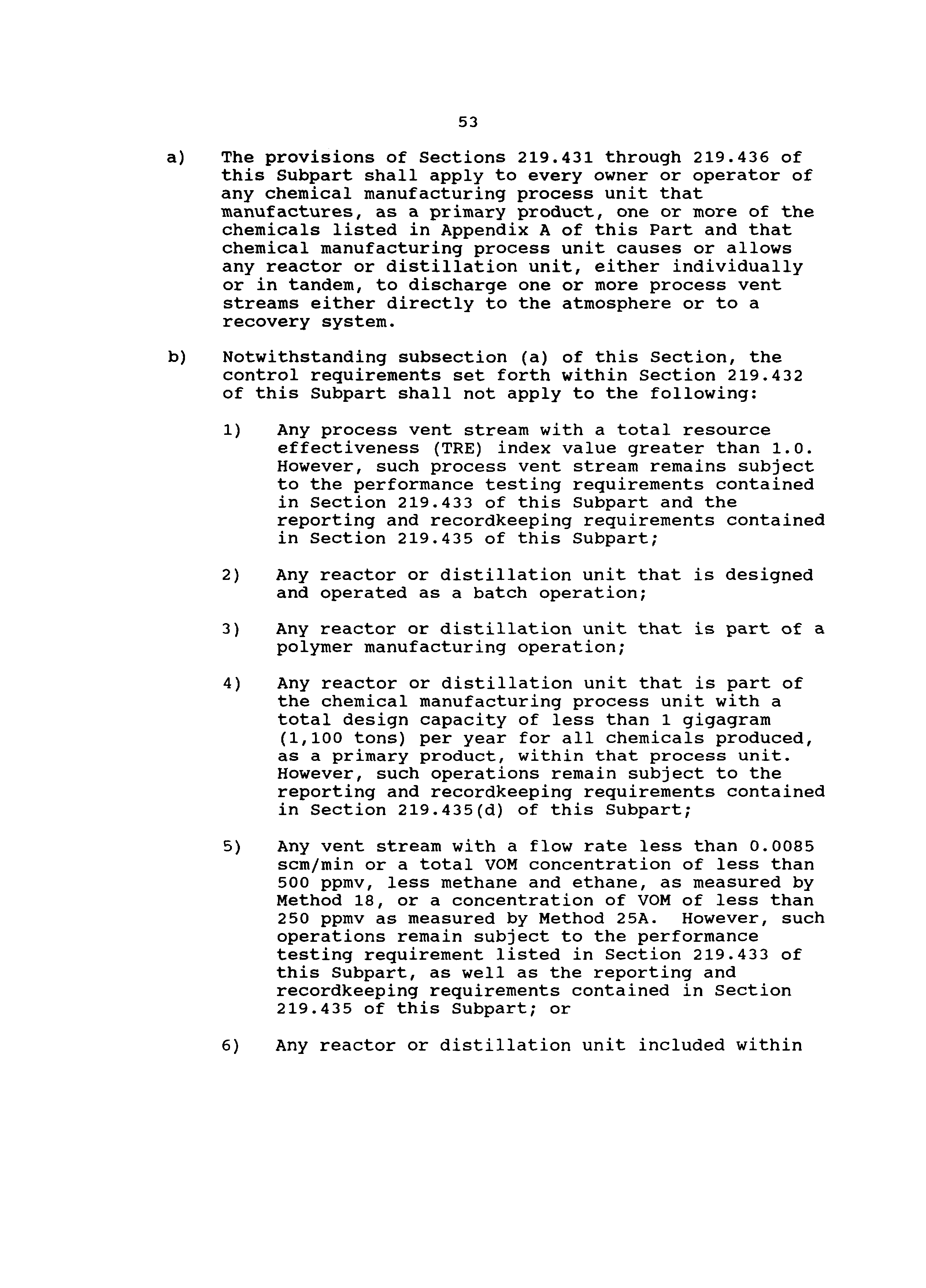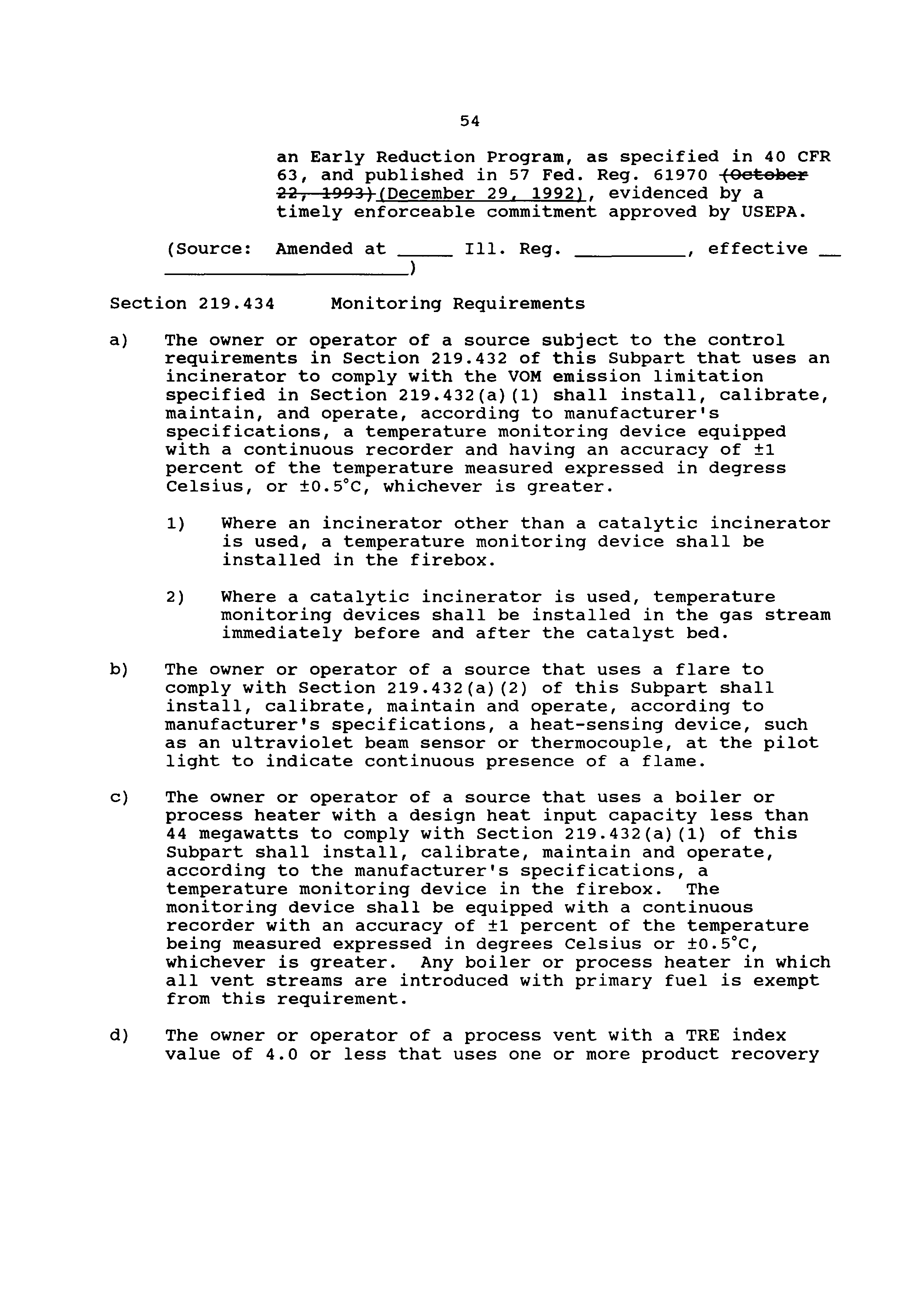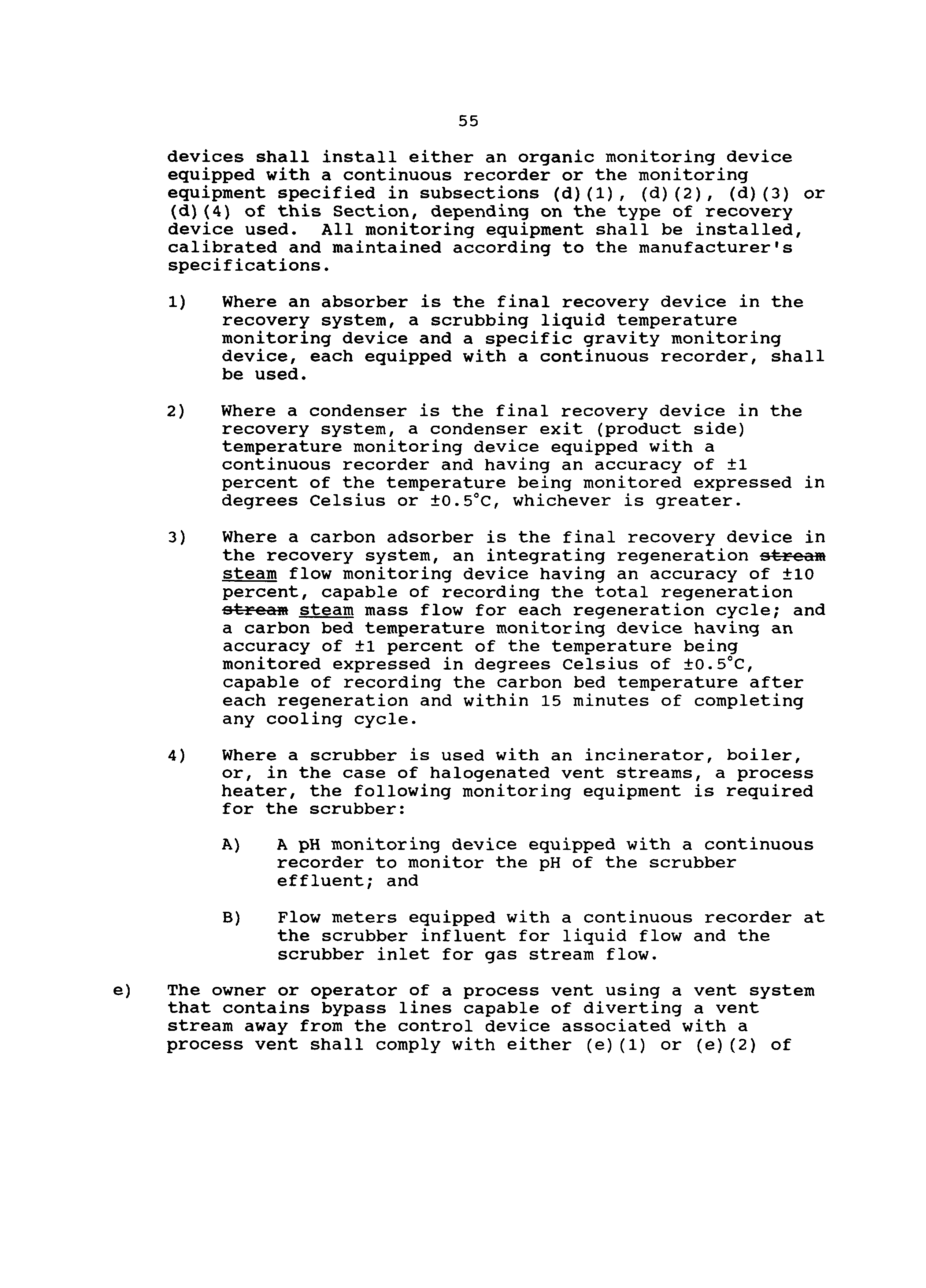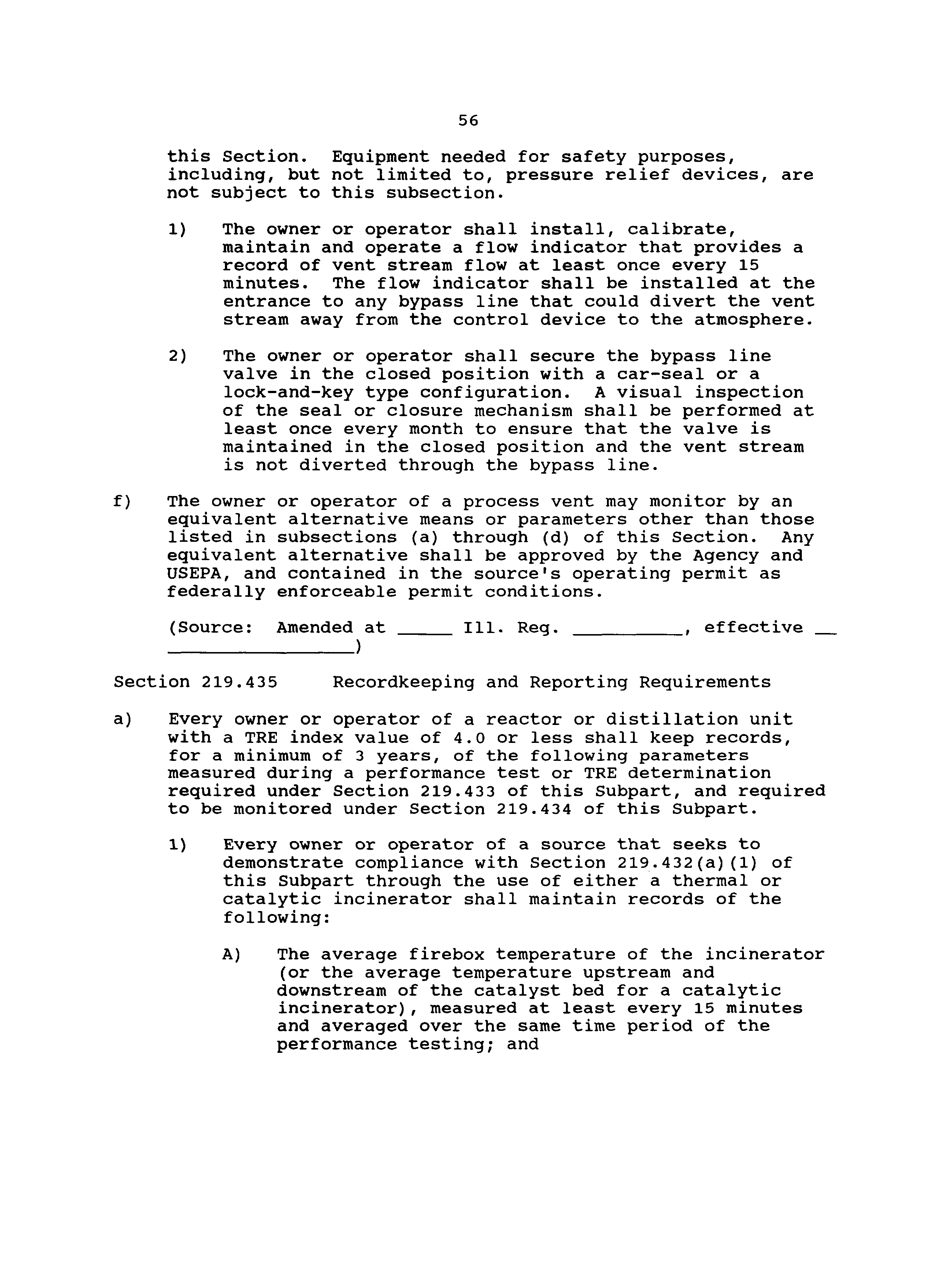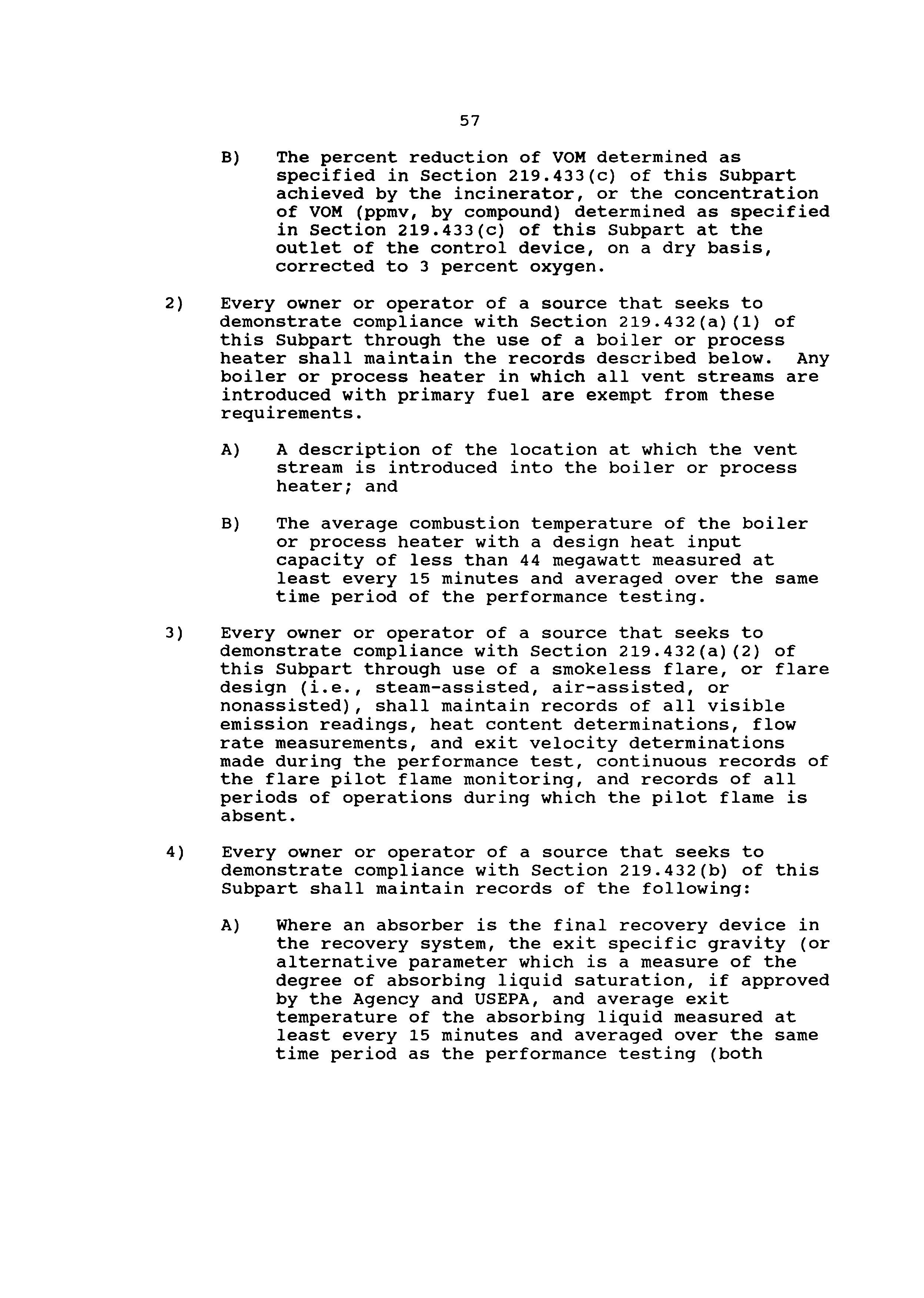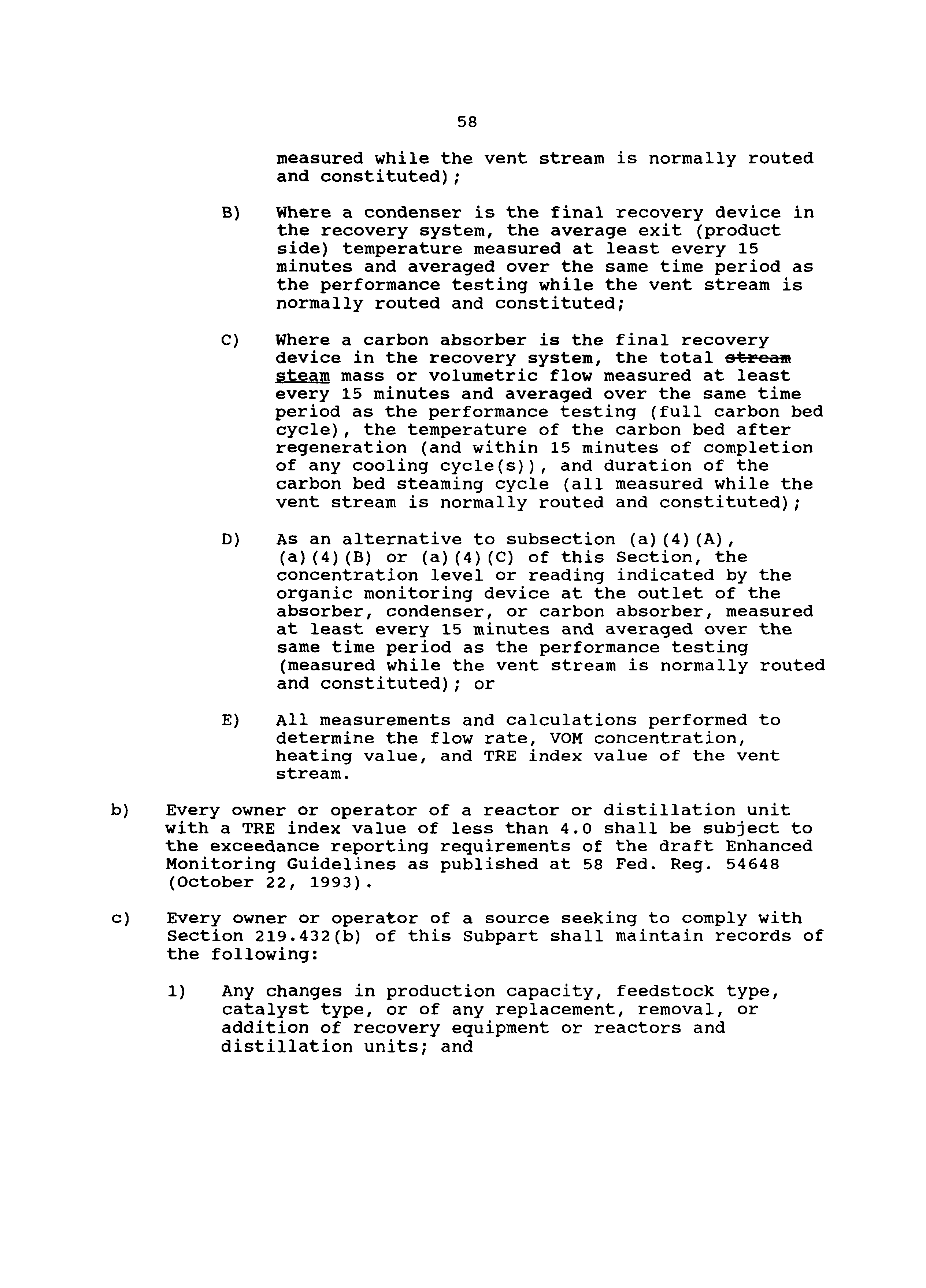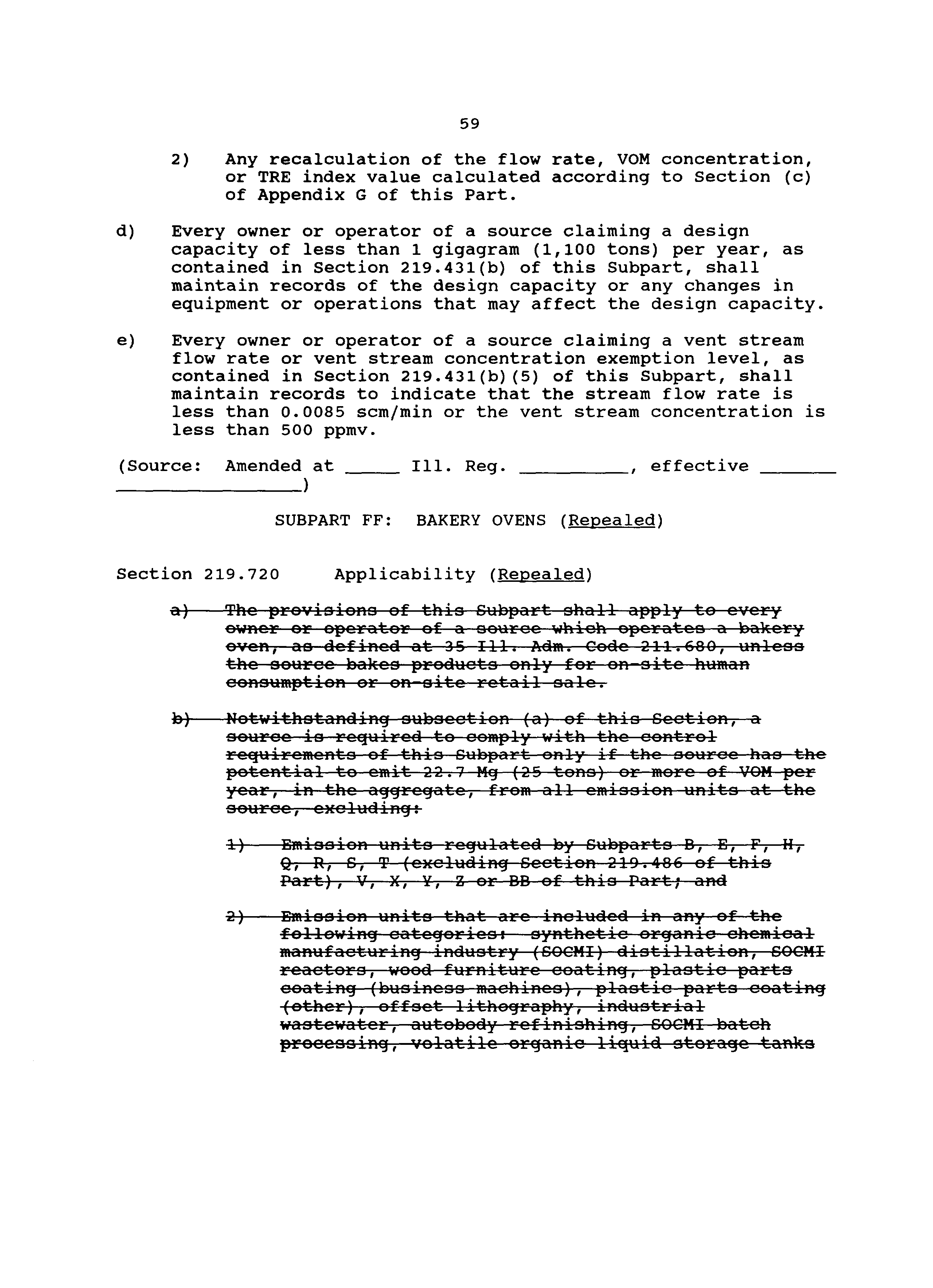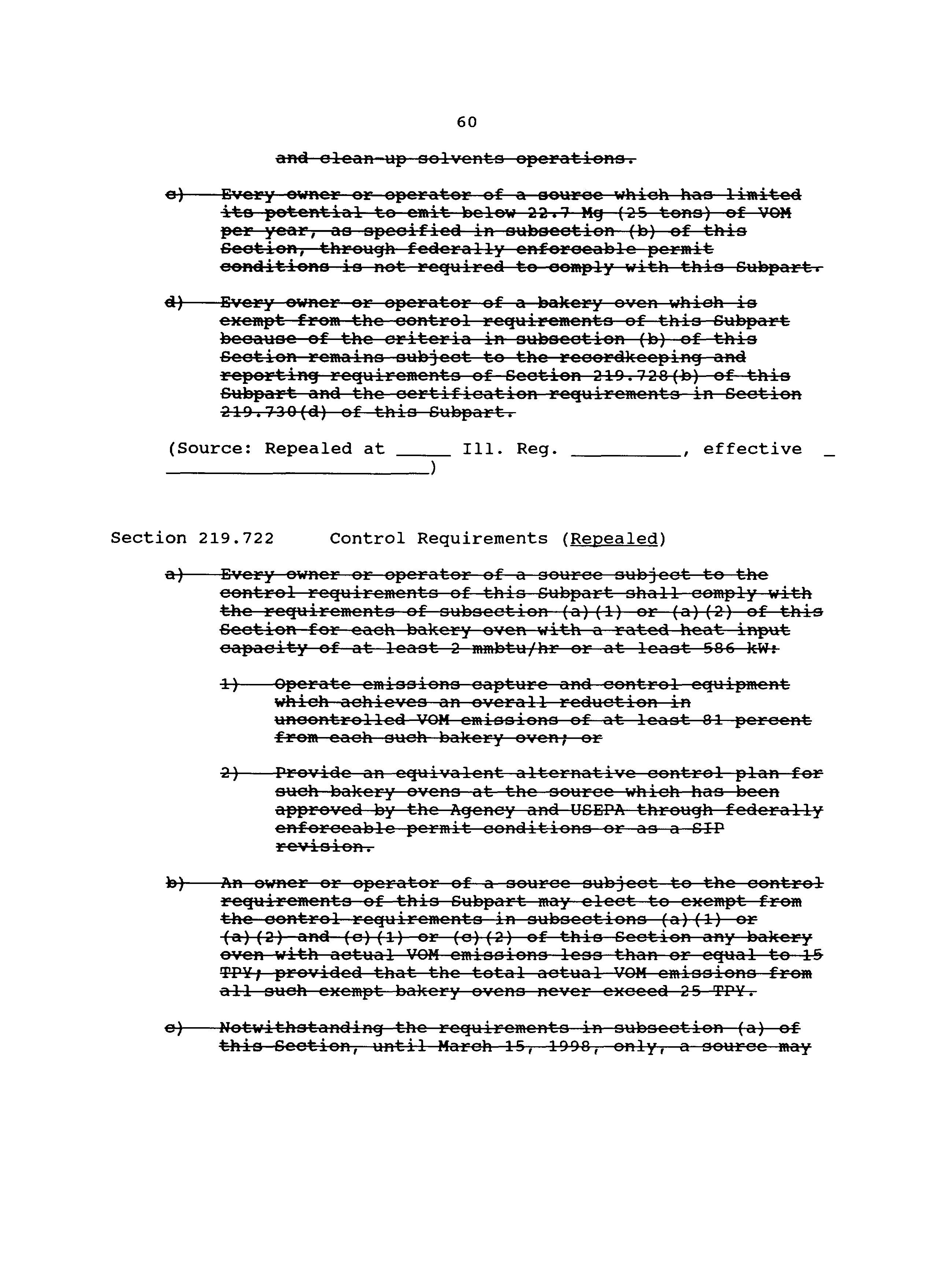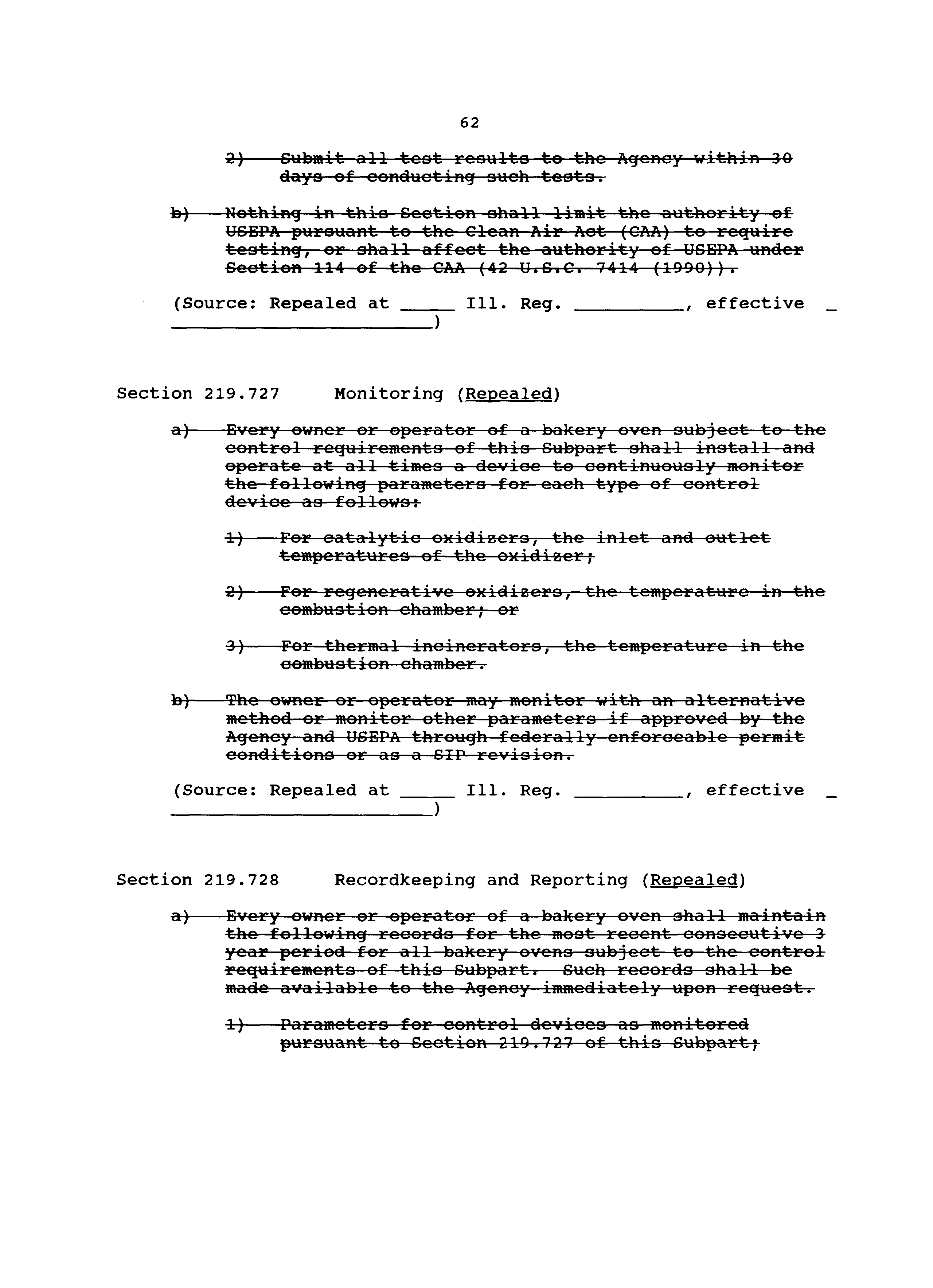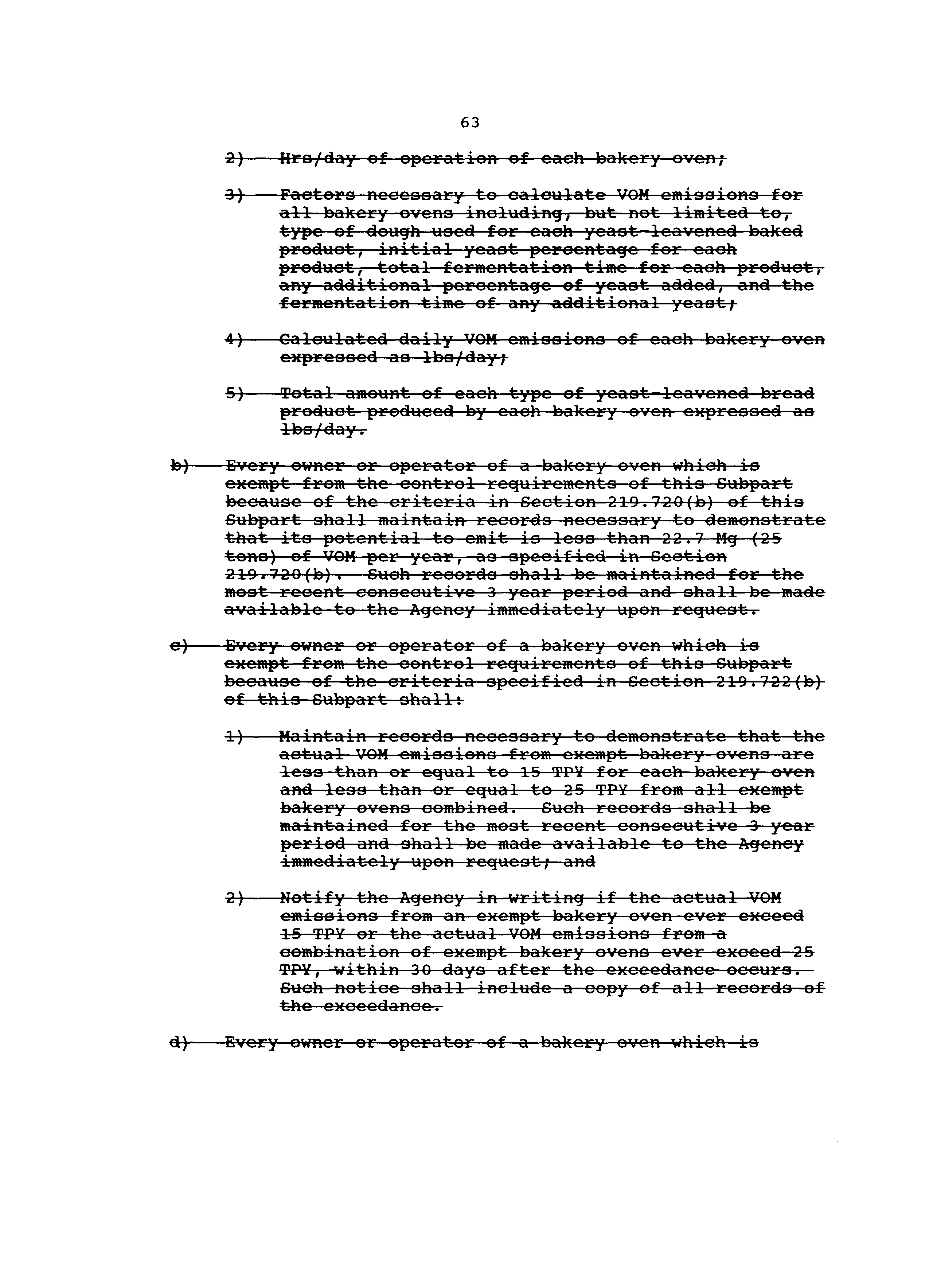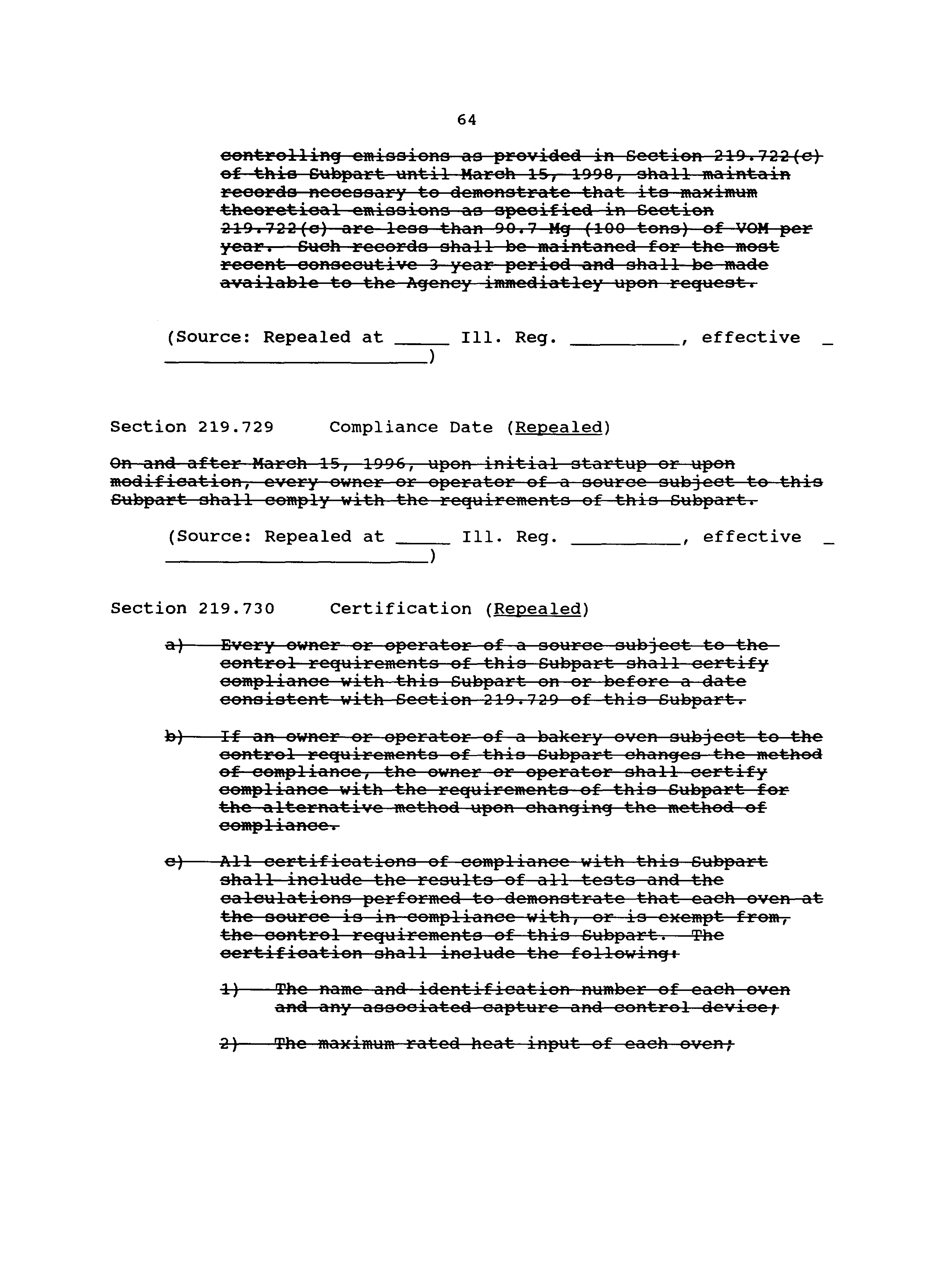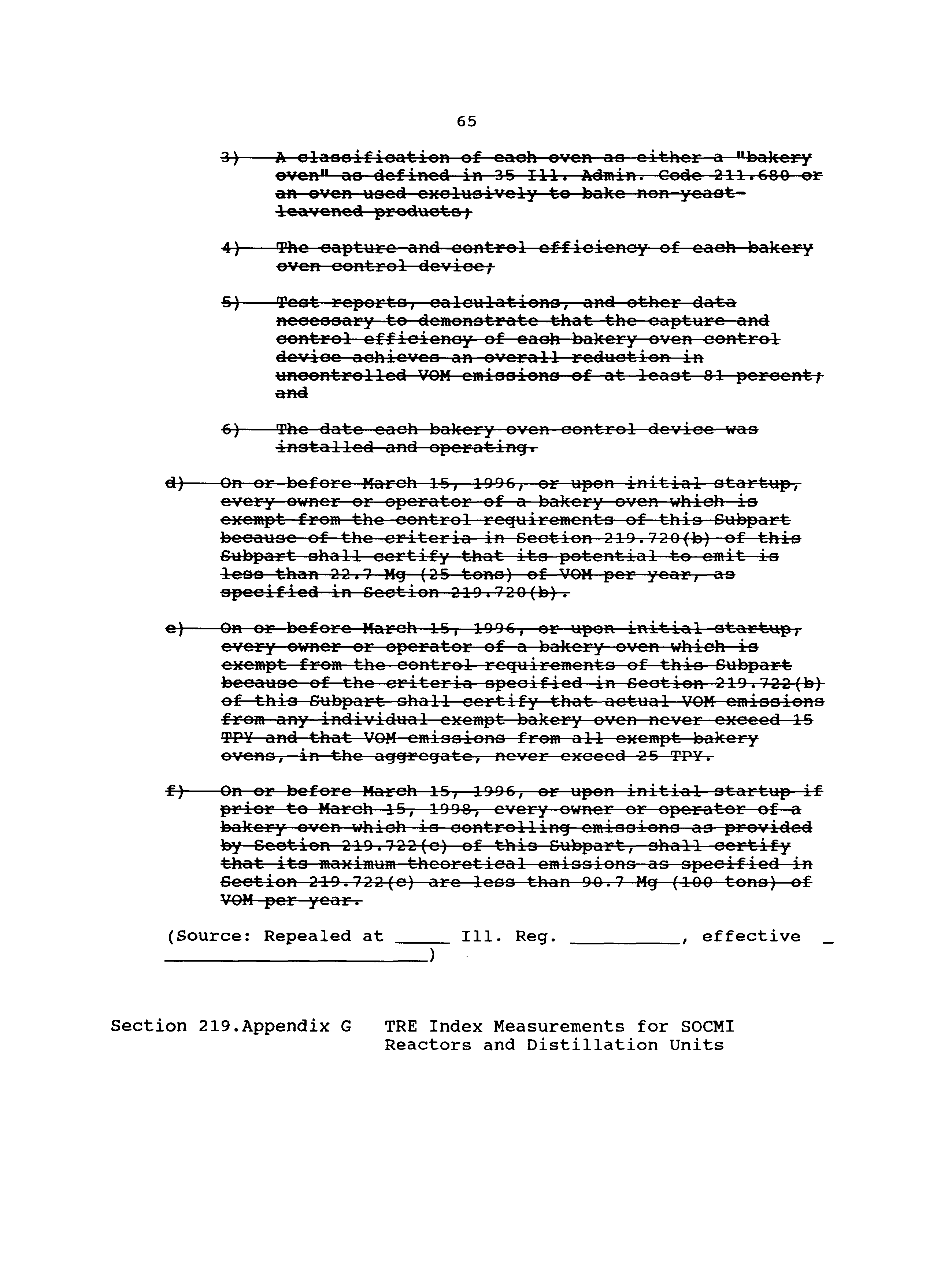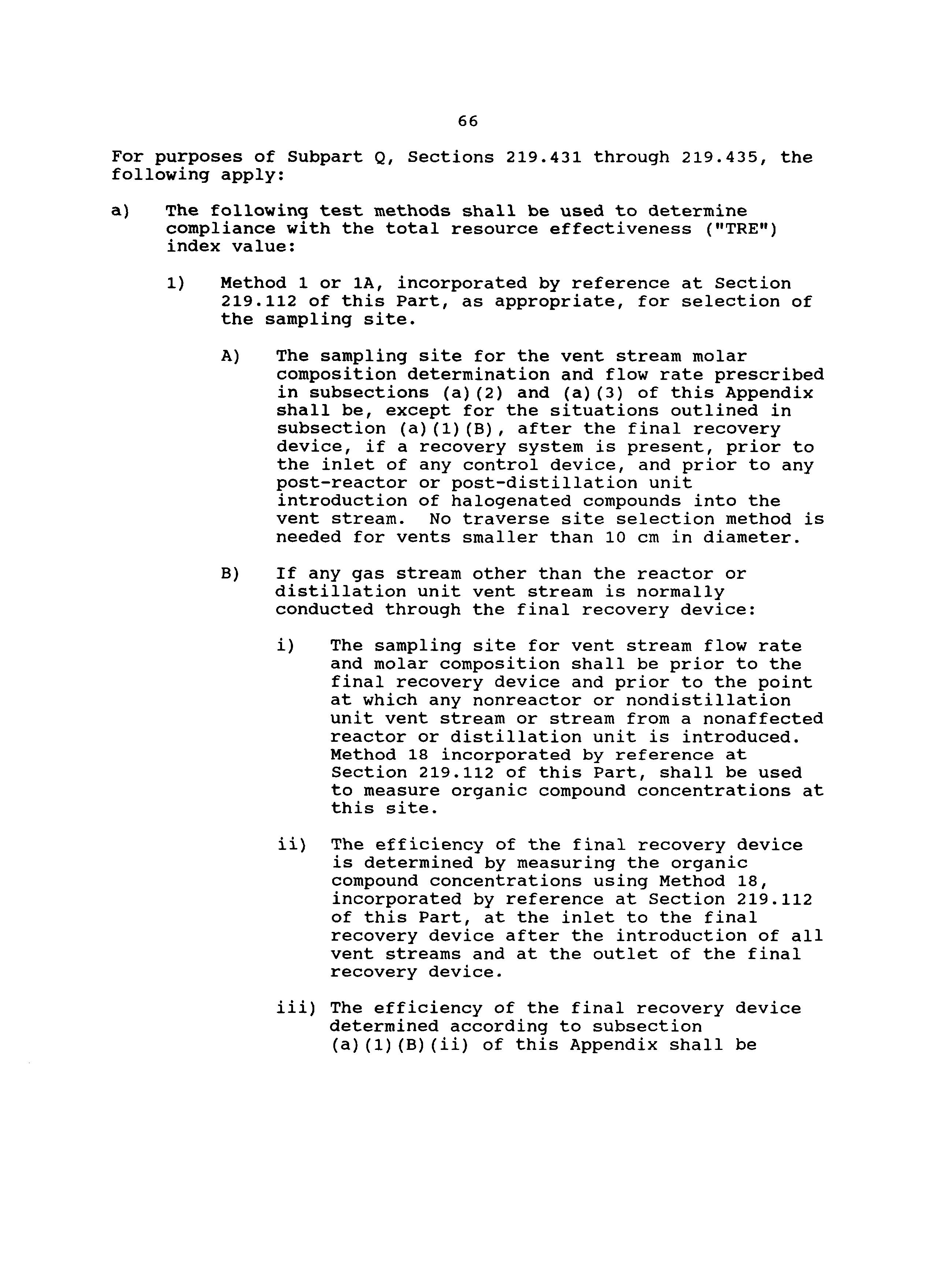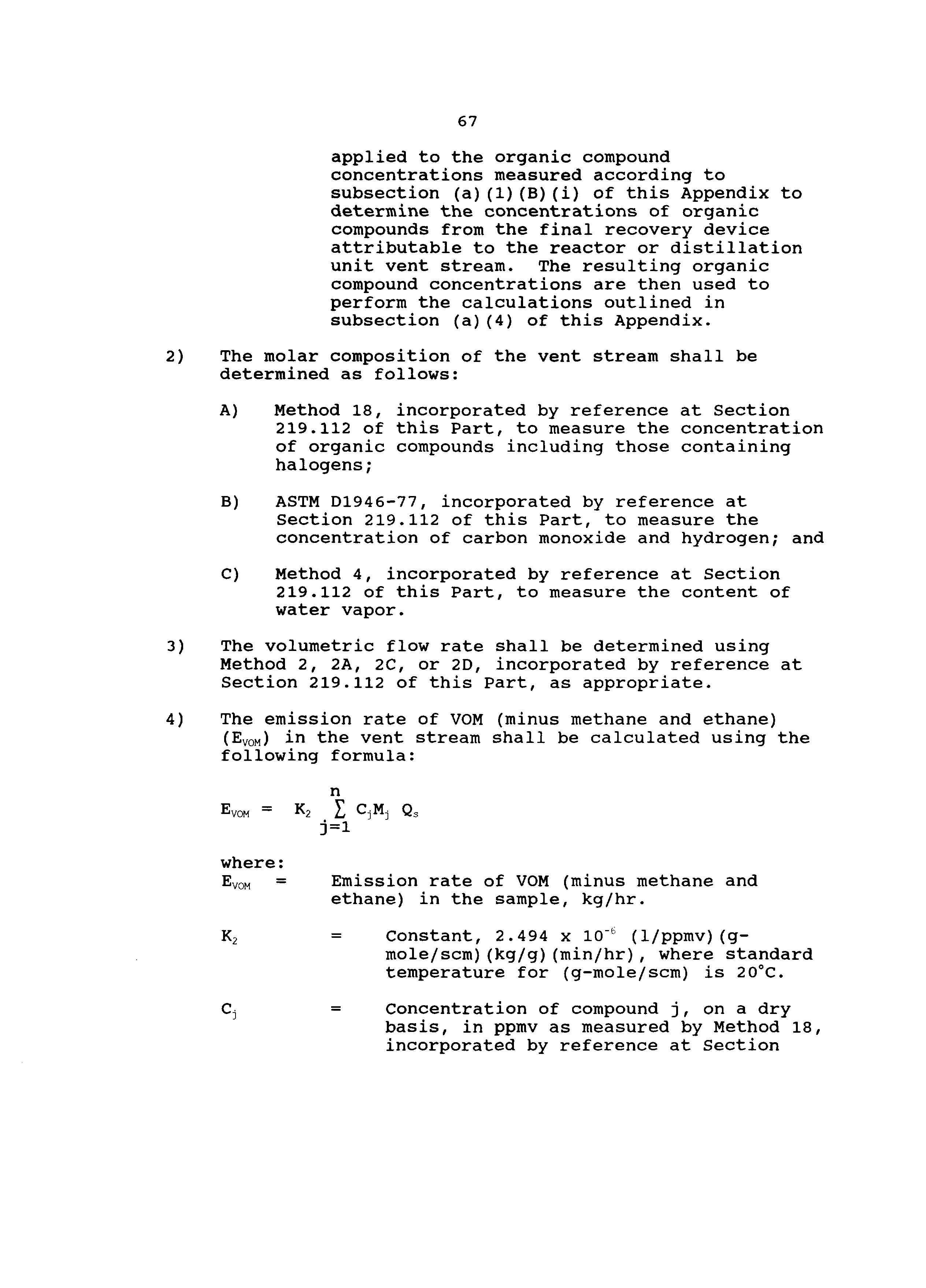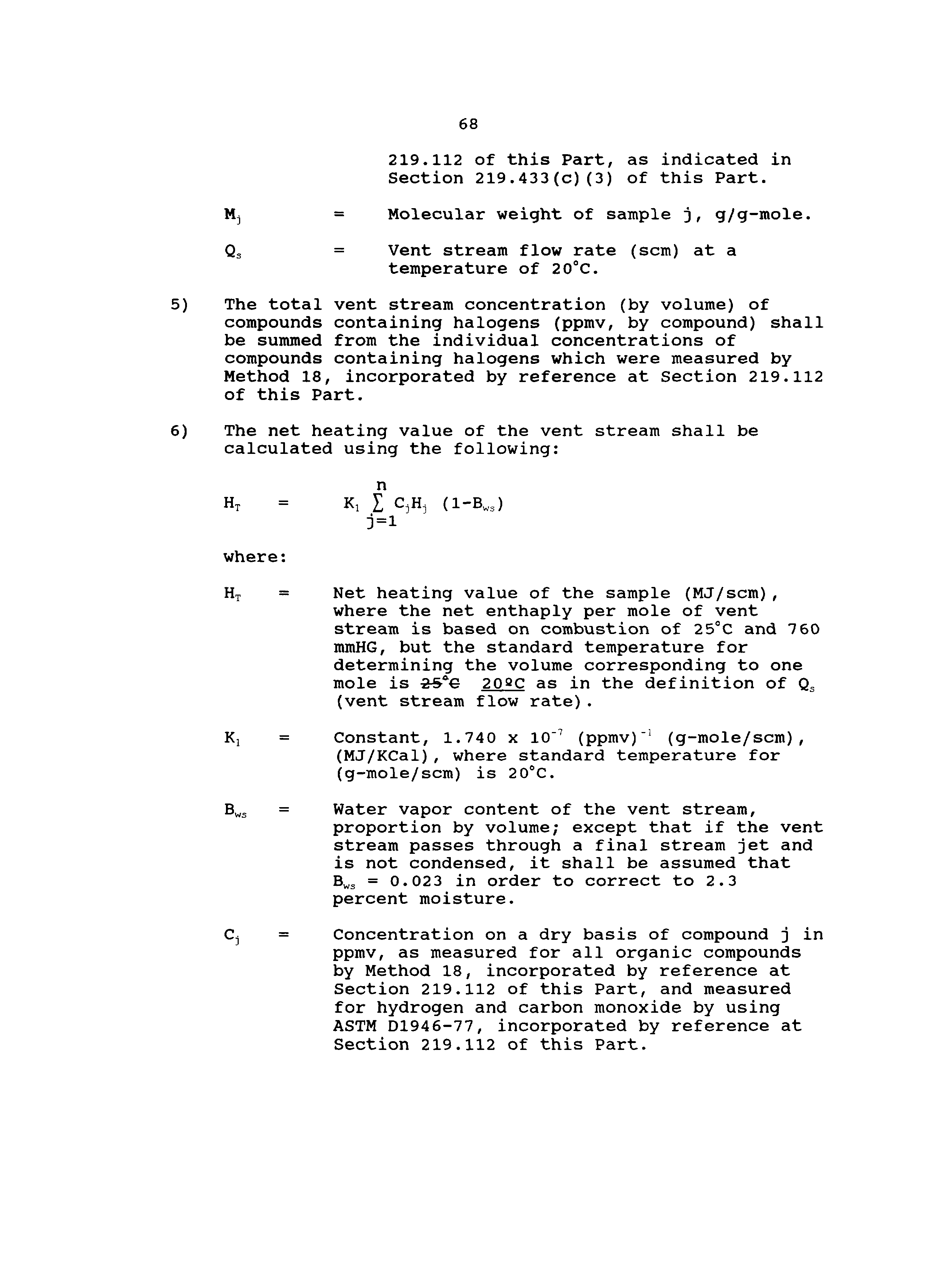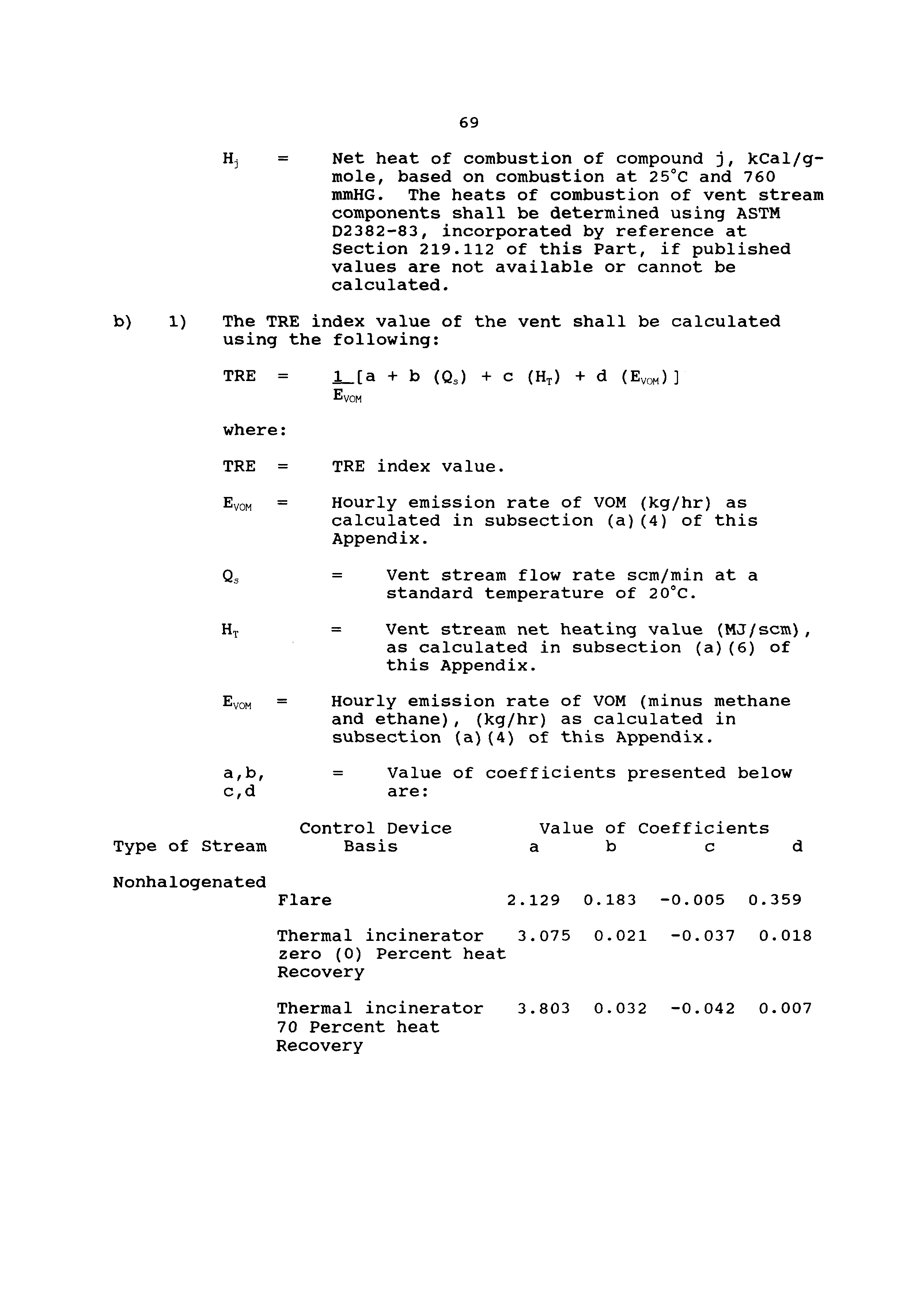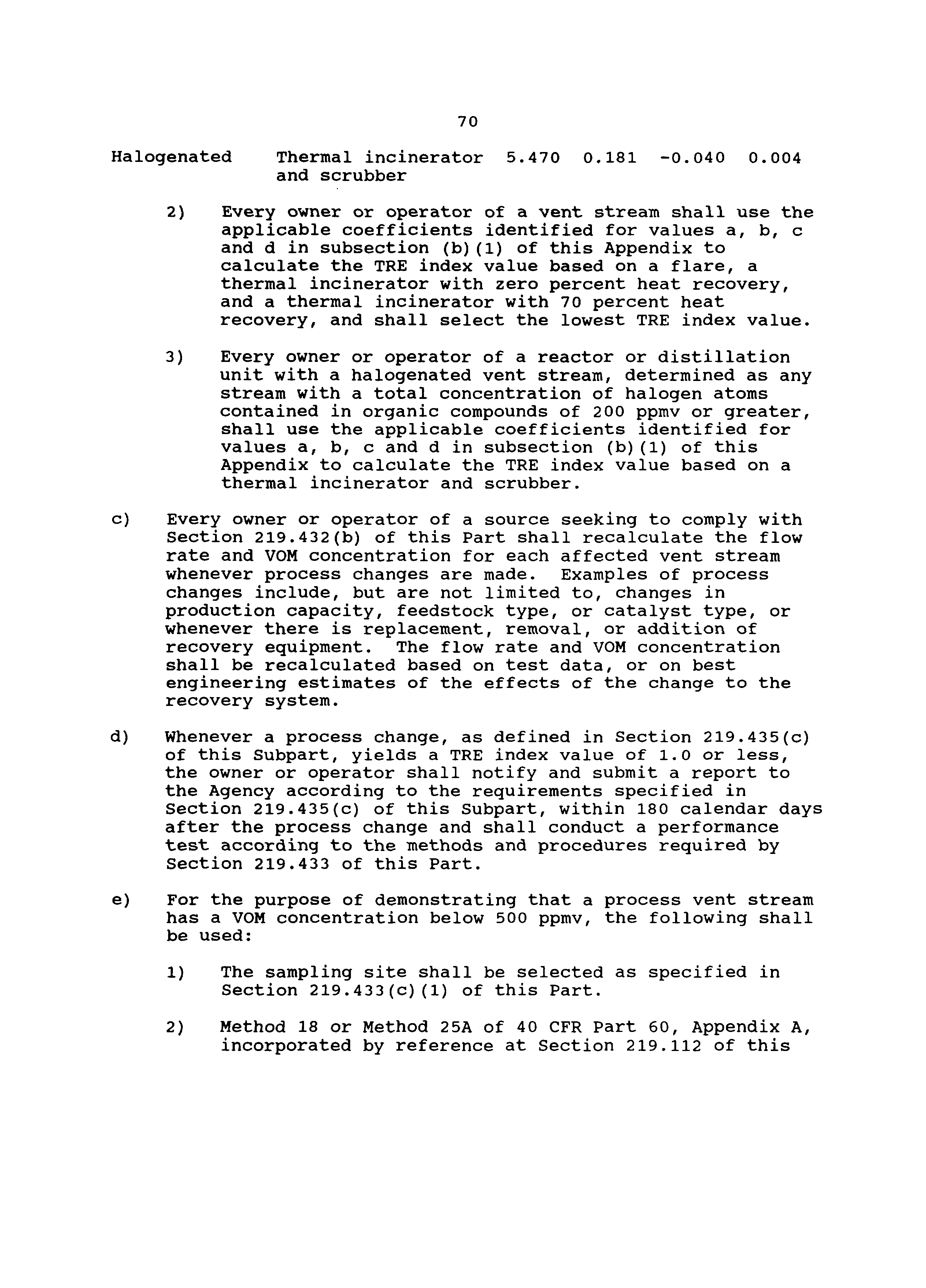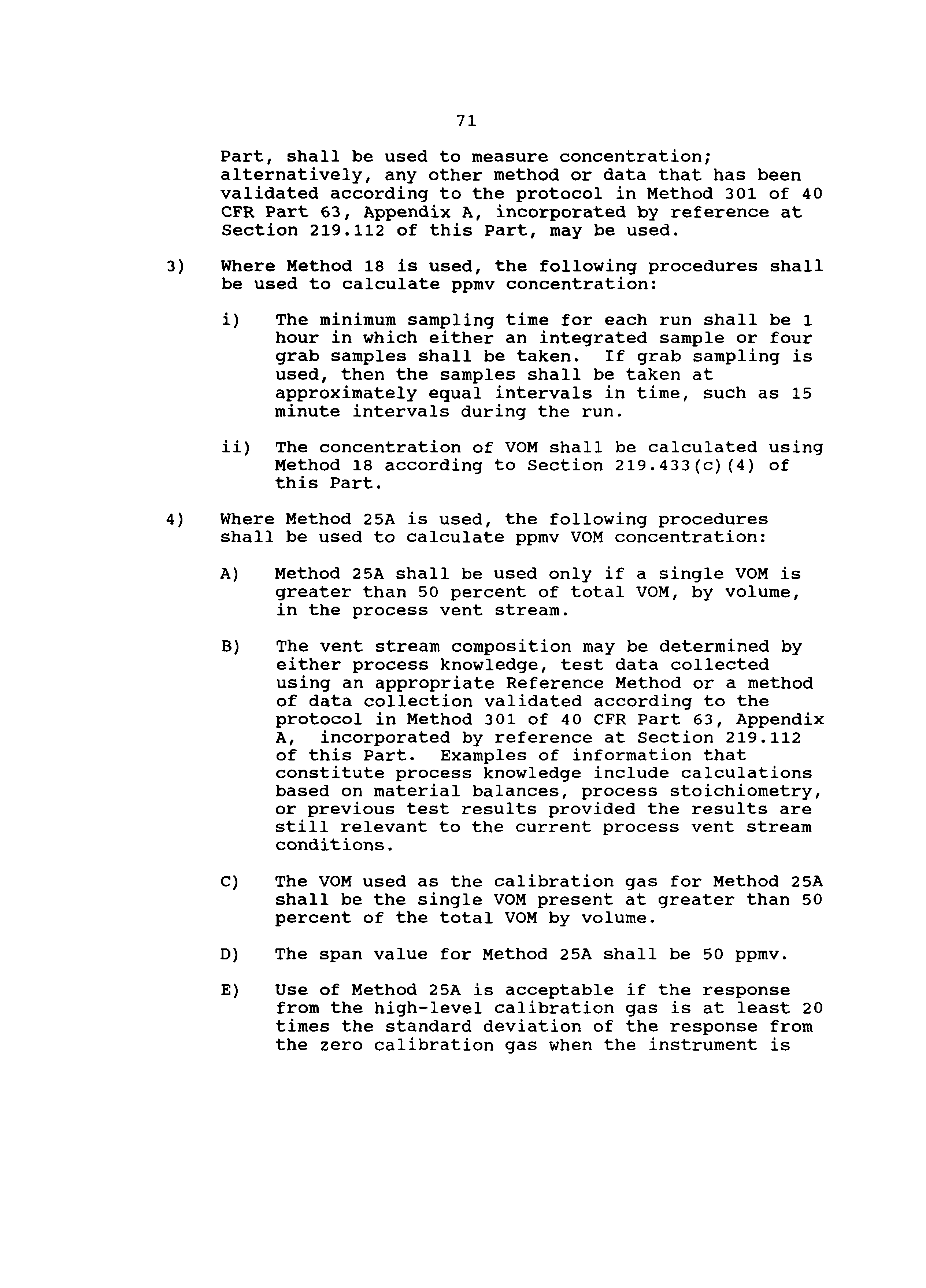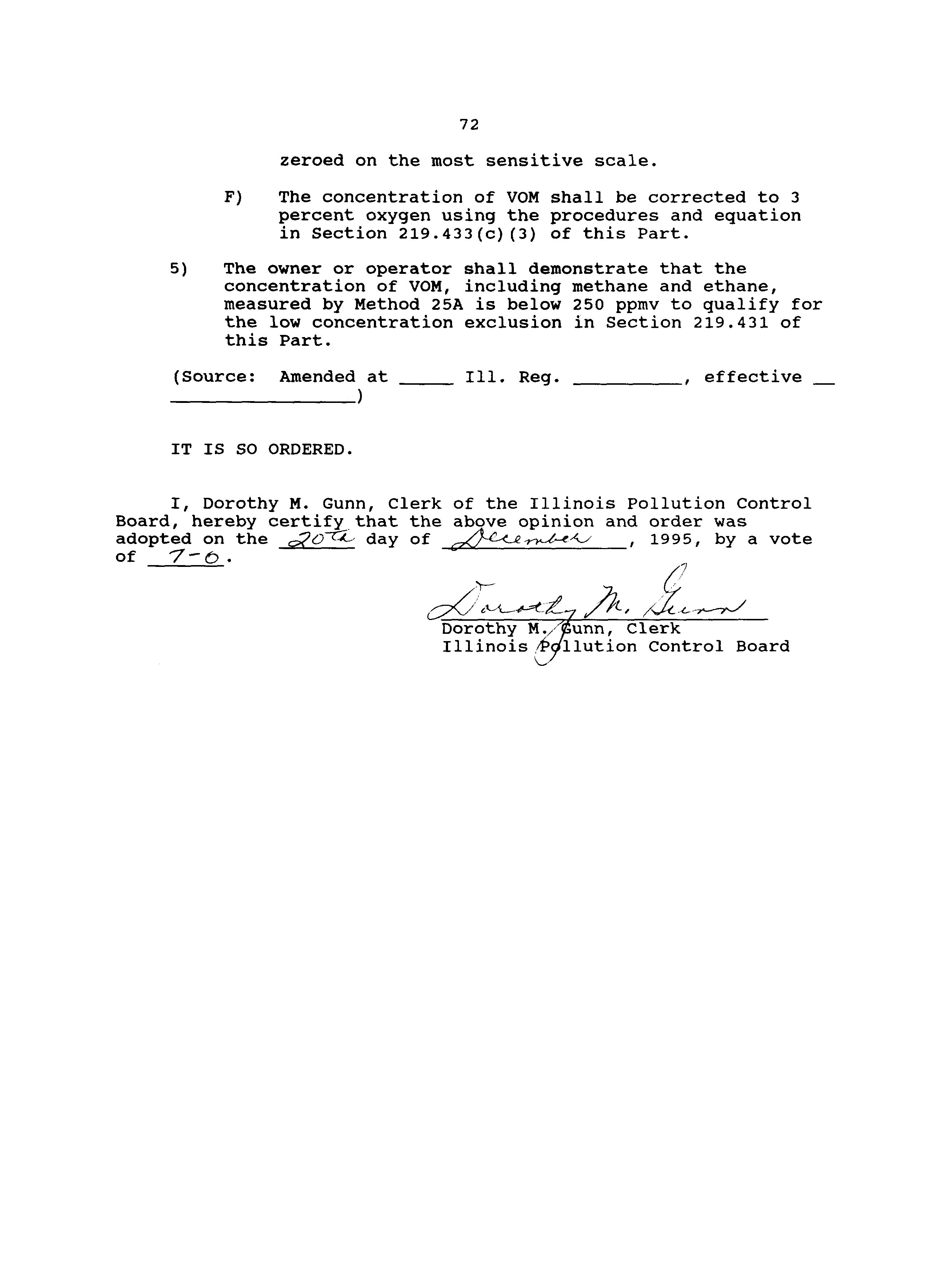ILLINOIS POLLUTION CONTROL BOARD
December 20,
1995
IN THE MATTER OF:
)
15
ROP PLAN:
)
CLEAN-UP PART II:
)
R96-l3
AMENDMENTS TO 35
ILL. ADM.
)
(Rulemaking-Air)
CODE PARTS 218
AND
219
ProDosed Rule.
First Notice.
OPINION
AND
ORDER OF THE BOARD
(by J.
Theodore Meyer):
On December 13,
1995 the Illinois Environmental Protection
Agency (Agency)
filed this proposal for rulemaking.
In addition
to the proposal, the Agency filed a motion to waive certain
filing requirements.
Section 182(b) (1) of the Clean Air Act
(42
U.s.c.
7511(b) (1))
required Illinois to submit a plan by November 15,
1993,
for achieving a 15
reduction of volatile organic material
(VOM)
emissions in the Chicago and Metro—East ozone nonattainment
areas
(15
Rate—of-Progress
(ROP)
Plan).
Section 182(b)
of the
CAA
also required Illinois to submit fully adopted measures to
implement the ROP Plan.
Illinois submitted its 15
ROP plan
November 13,
1993, and thereafter proposed regulations to
implement the ROP Plan.
The Agency proposes seven
(7)
minor
amendments to 35 Ill. Adm.
Code Parts
218 and 219:
1)
Add identical
language found in Section 218.208(b)
regarding “equivalent alternative control plans” to
Section 219.108(b);
2)
Revise certain equations for vapor pressure
in Subpart
A;
3)
Clarify the applicable record keeping and reporting
requirements for coating operations using touch-up and
repair coatings in Subpart
F;
4)
Correct a Federal Register citation regarding Synthetic
Organic Chemical and Polymer Manufacturing Plants
(SOCMI)
and correct typographical errors in Subpart Q;
5)
Reflect the Illinois General Assembly’s repeal in
Public Law 89-79
of the bakery oven rules
in Subpart
FF;
6)
Amend the exemption for polyethylene manufacturing
operations in Subpart TT; and,
7)
Correct a typographical error in Appendix G.
As mentioned above,
the Agency also filed a motion to waive
certain filing requirements of 35
Ill.
Adm.
Code
102.
Specifically, the Agency requests a waiver of the nine
(9)
copy
filing requirement,
stating that, due to the length of the
2
proposal, it would be more feasible to file five
(5)
full copies
and four
(4)
partial copies with the Board.
The Agency also
requested relief from 35
Ill.
Adm.
Code 120 which requires that
the entire proposal be submitted to the Attorney General and the
Department of Natural Resources.
The Agency contacted
representatives of both departments who agreed that it would be
sufficient to be formally notified that a proposal has been made
and where it can be reviewed.
Finally, the Agency asked for
relief from providing copies of incorporated material to meet the
requirement of 35
Iii. Adm. Code 102.121(f).
The Board hereby
grants the Agency’s motion to waive the above described filing
requirements.
Today the Board acts to send this proposal to first notice
under the Illinois Administrative Procedure Act,
but without
commenting on the merits of the proposal.
This proposal was filed pursuant to Sections 27 and 28.5 of
the Environmental Protection Act
(Act)
as a fast—track rulemaking
proceeding.
(415 ILCS 5/27 and 28.5
(1994.)
Section 28.5
requires the Board to proceed with rulemaking under set time—
frames.
The Board has no discretion to adjust these time frames
under any circumstances.
The following schedule indicates the
deadlines by which the Board must act, as provided in Section
28.5:
first notice
on or before December 20,
1995
first hearing
on or before February 6,
1996
second hearing
no later than 30 days after
the start of the first hearing
third hearing
no later than
14 days after
the start of the second
hearing
second notice
(if third hearing cancelled)
on or before April
4,
1996
(if third hearing held)
on or before May 2,
19956
final adoption and filing
21 days after receipt of JCAR
certificate of no objection
The Board notes that the above dates are the deadlines as
established by Section 28.5 and do not represent actual hearing
dates or filing dates.
While the schedule includes second and
third hearings,
these hearings may be cancelled if unnecessary.
The Board will proceed
in this matter as prescribed
in Section
28.5 and discussed in the Board’s resolution.
(~
Clean Air Act
Rulemaking Procedures Pursuant to Section 28.5 of the
Environmental Protection Act,
as Added By P.A.
87-1213,
(October
29,
1992 and December
3,
1992), RES 92—2.)
In the interest of administrative economy, the Board directs
the Hearing Officer to verify that the persons on the Clean Air
Act Notice List wish to continue to receive mailing
in this
3
proceeding.
ORDER
The Board directs the Clerk to cause publication of the
following amendments
in the Illinois Register for first notice:
TITLE 35:
ENVIRONMENTAL PROTECTION
SUBTITLE B:
AIR POLLUTION
CHAPTER
I:
POLLUTION CONTROL BOARD
SUBCHAPTER c:
EMISSIONS STANDARDS AND
LIMITATIONS FOR STATIONARY SOURCES
PART 218
ORGANIC MATERIAL EMISSION STANDARDS AND
LIMITATIONS FOR THE CHICAGO AREA
SUBPART A:
GENERAL PROVISIONS
Section
218. 100
218. 101
218. 102
218.103
218.104
218.105
218.106
218.107
218.108
218. 109
218.110
218
.
ill
218.112
218.113
218. 114
Introduction
Savings Clause
Abbreviations and Conversion Factors
Applicability
Definitions
Test Methods and Procedures
Compliance Dates
Operation of Afterburners
Exemptions, Variations, and Alternative Means of
Control or Compliance Determinations
Vapor Pressure of Volatile Organic Liquids
Vapor Pressure of Organic Material or Solvent
Vapor Pressure of Volatile Organic Material
Incorporations by Reference
Monitoring for Negligibly-Reactive Compounds
Compliance with Permit Conditions
SUBPART B:
ORGANIC EMISSIONS FROM STORAGE
AND LOADING OPERATIONS
Applicability for VOL
Control Requirements for Storage Containers of VOL
Storage Containers of VPL
Loading Operations
Petroleum Liquid Storage Tanks
External Floating Roofs
Compliance Dates
Compliance Plan (Repealed)
Testing VOL Operations
Monitoring VOL Operations
Recordkeeping and Reporting for VOL Operations
Section
218. 119
218.120
218.121
218. 122
218.123
218.124
218.125
218. 126
218.127
218.128
218.129
4
SUBPART
C:
ORGANIC EMISSIONS FROM
MISCELLANEOUS EQUIPMENT
Section
218.141
218.142
218.143
218.144
Separation Operations
Pumps and Compressors
Vapor Blowdown
Safety Relief Valves
SUBPART E:
SOLVENT CLEANING
SUBPART
F:
COATING OPERATIONS
Emission Limitations
Daily-Weighted Average Limitations
Solids Basis Calculation
Alternative Emission Limitations
Exemptions from Emission Limitations
Exemption from General Rule on Use of Organic Material
Compliance Schedule
Recordkeeping and Reporting
Cross-Line Averaging to Establish Compliance for
Coating Lines
218.213
Recordkeeping and Reporting for Cross—Line Averaging
Participating Coating Lines
218.214
Changing Compliance Methods
SUBPART
0:
USE OF ORGANIC MATERIAL
Use of Organic Material
Alternative Standard
Fuel Combustion Emission Units
Operations with Compliance Program
SUBPART H:
PRINTING AND PUBLISHING
Section
218.401
218.402
218.403
218.404
218.405
Flexographic and Rotogravure Printing
Applicability
Compliance Schedule
Recordkeeping and Reporting
Lithographic Printing:
Applicability
Solvent Cleaning in General
Cold Cleaning
Open Top Vapor Degreasing
Conveyorized Degreasing
Compliance Schedule
(Repealed)
Test Methods
Section
218.181
218.182
218.183
218.184
218.185
218.186
Section
218.204
218.205
218.206
218.207
218.208
218.209
218.210
218.211
218.212
Section
218.301
218.302
218.303
218.304
5
218.406
Provisions Applying to Heatset Web Offset Lithographic
Printing Prior to March
15,
1996
218.407
Emission Limitations and Control Requirements for
Lithographic Printing Lines On and After March 15, 1996
218.408
Compliance Schedule for Lithographic Printing on and
After March 15,
1996
218.409
Testing for Lithographic Printing On and After March
15,
1996
218.410
Monitoring Requirements for Lithographic Printing
218.411
Recordkeeping and Reporting for Lithographic Printing
SUBPART
Q:
SYNTHETIC ORGANIC CHEMICAL
AND
POLYMER
MANUFACTURING
PLANT
Section
218.421
218.422
218.423
218.424
218.425
218.426
2 18.427
218.428
218.429
218.430
218.43.
218.432
218.433
218.434
218.435
218.436
Section
218.441
218.442
218.443
218.444
218.445
218.446
218.447
218.448
218.449
218.450
218.451
218.452
218.453
General Requirements
Inspection Program Plan for Leaks
Inspection Program for Leaks
Repairing Leaks
Recordkeeping for Leaks
Report for Leaks
Alternative Program for Leaks
Open-Ended Valves
Standards for Control Devices
Compliance Date
(Repealed)
Applicability
Control Requirements
Performance and Testing Requirements
Monitoring
Requirements
Recordkeeping and Reporting Requirements
Compliance Date
SUBPART R:
PETROLEUM REFINING AND
RELATED INDUSTRIES; ASPHALT MATERIALS
Petroleum Refinery Waste Gas Disposal
Vacuum Producing Systems
Wastewater
(Oil/Water)
Separator
Process Unit Turnarounds
Leaks:
General Requirements
Monitoring Program Plan for Leaks
Monitoring Program for Leaks
Recordkeeping for Leaks
Reporting for Leaks
Alternative Program for Leaks
Sealing Device Requirements
Compliance Schedule for Leaks
Compliance
Dates
(Repealed)
6
SUBPART
5:
RUBBER
AND
MISCELLANEOUS
PLASTIC
PRODUCTS
Manufacture
of
Pneumatic Rubber Tires
Green
Tire
Spraying
Operations
Alternative
Emission
Reduction Systems
Emission Testing
Compliance Dates
(Repealed)
Compliance Plan
(Repealed)
SUBPART
T:
PHARMACEUTICAL MANUFACTURING
Section
218.480
Applicability
218.481
Control of Reactors,
Distillation Units,
Crystallizers,
Centrifuges and Vacuum Dryers
218.482
Control of Air Dryers, Production Equipment Exhaust
Systems and Filters
Material Storage and Transfer
In—Process Tanks
Leaks
Other Emission Units
Testing
Monitoring for Air Pollution Control Equipment
Recordkeeping for Air Pollution Control Equipment
SUBPART V:
BATCH OPERATIONS AND AIR
OXIDATION PROCESSES
Applicability for Batch Operations
Control Requirements for Batch Operations
Determination of Uncontrolled Total Annual Mass
Emissions and Average Flow Rate Values for Batch
Operations
218.503
Performance and Testing Requirements for Batch
Operations
Monitoring
Requirements
for
Batch
Operations
Reporting and Recordkeeping for Batch Operations
Compliance Date
Emission Limitations for Air Oxidation Processes
Definitions (Repealed)
Savings Clause
Compilance
Determination of Applicability
Emission Limitations for Air Oxidation Processes
(Renumbered)
218.526
Testing and Monitoring
218.527
Compliance Date
(Repealed)
Section
218.461
218.462
218.463
2 18.464
218.465
218.466
218.483
218.484
218.485
218.486
218.487
218.488
218.489
Section
218.500
218.501
218.502
218.504
218.505
2 18.506
218.520
218.521
218.522
218.523
218.524
218.525
7
Section
218.54
1
SUBPART W:
Pesticide Exception
AGRICULTURE
Architectural Coatings
Paving Operations
Cutback Asphalt
Section
218.581
218.582
218.583
218.584
218.585
218.586
Bulk Gasoline Plants
Bulk Gasoline Terminals
Gasoline Dispensing Operations
-
Storage Tank Filling
Operations
Gasoline Delivery Vessels
Gasoline Volatility Standards
Gasoline Dispensing Operations
-
Motor Vehicle Fueling
Operations
SUBPART
Z:
DRY CLEANERS
Section
218.601
218.602
218.603
2 18.604
218.605
218 .606
218.607
218.608
218.609
218.610
218.611
218.612
218.613
Section
218.620
218.621
218.623
218.624
218.
625
218.626
Perchloroethylene Dry Cleaners
Applicability
Leaks
Compliance Dates
(Repealed)
Compliance Plan
(Repealed)
Exception to Compliance Plan (Repealed)
Standards for Petroleum Solvent Dry Cleaners
Operating Practices for Petroleum Solvent Dry Cleaners
Program for Inspection and Repair of Leaks
Testing and Monitoring
Applicablity for Petroleum Solvent Dry Cleaners
Compliance Dates
(Repealed)
Compliance Plan
(Repealed)
SUBPART AA:
PAINT AND INK MANUFACTURING
Applicability
Exemption for Waterbase Material and Heatset-Offset Ink
Permit Conditions
(Repealed)
Open Top Mills,
Tanks, Vats or Vessels
Grinding Mills
Storage Tanks
Section
218.561
218.562
218.563
SUBPART X:
CONSTRUCTION
SUBPART Y:
GASOLINE DISTRIBUTION
8
218.628
Leaks
218.630
Clean Up
218.636
Compliance Schedule
218.637
Recordkeeping and Reporting
SUBPART BB:
POLYSTYRENE PLANTS
Section
218.640
Applicability
218.642
Emissions Limitation
at Polystyrene Plants
218.644
Emissions Testing
SUBPART CC: POLYESTER RESIN PRODUCT
MANUFACTURING
PROCESS
Section
218.660
Applicability
218.666
Control Requirements
218.667
Compliance Schedule
218.668
Testing
218.670
Recordkeeping and Reporting for Exempt Emission Units
218.672
Recordkeeping and Reporting for Subject Emission Units
SUBPART DD: AEROSOL CAN FILLING
Section
218.680
Applicability
218.686
Control Requirements
218.688
Testing
218.690
Recordkeeping and Reporting for Exempt Emission Units
218.692
Recordkeeping and Reporting for Subject Emission Units
SUBPART FF:
BAKERY OVENS
(Repealed)
Section
218.720
Applicability
(Repealed)
218.722
Control Requirements
(Repealed)
218.726
Testing
(Repealed)
218.727
Monitoring
(Repealed)
218.728
Recordkeeping and Reporting
(Repealed)
218.729
Compliance Date
(Repealed)
218.730
Certification
(Repealed)
SUBPART GG:
MARINE TERMINALS
Section
218.760
Applicability
218.762
Control Requirements
218.764
Compliance Certification
218.766
Leaks
9
218.768
Testing and Monitoring
218.770
Recordkeeping and Reporting
SUBPART HH:
MOTOR VEHICLE REFINISHING
Section
218.780
218.782
2 18.784
218.786
218.787
2 18.788
218.789
218.790
218.791
218.792
218.875
218.877
218.879
218.881
218.883
218.886
Section
218.940
218.943
218.946
218.947
218.948
Section
218.960
218.963
218.966
Emission
Limitations
Alternative Control Requirements
Equipment Specifications
Surface Preparation Materials
Work Practices
Testing
Monitoring and Recordkeeping for Control Devices
General Recordkeeping and Reporting
Compliance Date
Registration
Applicability of Subpart BB
(Renumbered)
Emissions Limitation at Polystyrene Plants
(Renumbered)
Compliance Date
(Repealed)
Compliance Plan
(Repealed)
Special Requirements for Compliance Plan (Repealed)
Emissions Testing
(Renumbered)
SUBPART PP:
MISCELLANEOUS FABRICATED
PRODUCT MANUFACTURING PROCESSES
SUBPART QQ:
MISCELLANEOUS FORMULATION
MANUFACTURING
PROCESSES
Applicability
Permit Conditions
(Repealed)
Control Requirements
Compliance Schedule
Testing
SUBPART RR:
MISCELLANEOUS ORGANIC
CHEMICAL MANUFACTURING PROCESSES
Applicability
Permit Conditions
(Repealed)
Control Requirements
Section
218.920
218.923
218.926
218.927
218.928
Applicability
Permit Conditions
(Repealed)
Control Requirements
Compliance Schedule
Testing
10
218.967
Compliance Schedule
218.968
Testing
Exempt Emission Units
Subject Emission Units
Section 218.Appendix A:
Section 218.Appendix B:
Section 218.Appendix C:
Section 218.Appendix D:
Section 2l8.Appendix E:
Section 218.Appendix G:
Section 218.Appendix H:
List of Chemicals Defining Synthetic
Organic Chemical and Polymer
Manufacturing
VOM Measurement Techniques for Capture
Efficiency
Reference Methods and Procedures
Coefficients for the Total Resource
Effectiveness Index
(TRE)
Equation
List of Affected Marine Terminals
TRE Index Measurements for SOCMI
Reactors and Distillation Units
Baseline VOM Content Limitations for
Subpart F,
Section 218.212 Cross-Line
Averaging
AUTHORITY:
Implementing Section 10 and authorized by Section
28.5 of the Environmental Protection Act 415
ILCS 5/10 and
28.5.
SOURCE:
Adopted at R91-7 at 15 Ill.
Reg.
12231, effective August
16,
1991; amended in R91—23 at 16 Ill.
Reg.
13564, effective
August 24,
1992; amended in R91—28 and R91-30 at 16 Ill.
Reg.
13864, effective August 24,
1992; amended in R93-9
at 17
Ill.
Reg.
16636, effective September 27,
1993; amended in R93—l4 at 18
Ill. Reg. at
1945, effective January 24, 1994;
amended in R94-12
at 18 Ill. Reg.
at 14973, effective September 21,
1994;
amended
in R94—15 at
18 Ill. Reg.
16392, effective October 25,
1994;
amended in R94-16 at 18
Ill. Reg.
16950, effective November 15,
1994; amended in R94—2l,
R94—31 and R94—32 at 19
Ill.
Reg.
6848,
effective May 9,
1995; amended in R94—33 at 19 Ill. Reg.
7359,
effective May 22,
1995; amended at
_____
Ill. Reg.
effective
_____________________
Section
218.980
218.983
218.986
218.987
218.988
Section
218.990
218.991
SUBPART TT:
OTHER EMISSION UNITS
Applicability
Permit Conditions
(Repealed)
Control Requirements
Compliance Schedule
Testing
SUBPART UU:
RECORDKEEPING
AND
REPORTING
11
BOARD NOTE:
This Part implements the Environmental Protection
Act as of July
1,
1994.
SUBPART A:
GENERAL PROVISIONS
Section 218.110
Vapor Pressure of Organic Material or Solvent
a)
If the organic material or solvent consists of only a
single compound, the vapor pressure shall be determined
by ASTN Method D2879-86 (incorporated by reference in
Section 218.112 of this Part)
or the vapor pressure may
be obtained from a publication such as:
Boublik,
T.,
V. Fried and E. Hala,
“The Vapor Pressure of Pure
Substances,” Elsevier Scientific Publishing Co., New
York
(1973); Perry’s Chemical Engineer’s Handbook,
McGraw-Hill Book Company
(1984);
CRC Handbook of
Chemistry and Physics, Chemical Rubber Publishing
Company
(1986-87); and Lange’s Handbook of Chemistry,
John A.
Dean,
editor, McGraw-Hill Book Company
(1985).
b)
If the organic material or solvent is in a mixture made
up of both organic material compounds and compounds
which are not organic material,
the vapor pressure
shall be determined by the following equation:
n
E
P,
X,
Pvom ~om
=
i=1
n
B
i=l
where:
Porn
=
Total vapor pressure of the portion of
the mixture which is composed of organic
material;
n
=
Number of organic material components
in
the mixture;
i
=
Subscript denoting an individual
component;
P1
=
Vapor pressure of an organic material
component determined
in accordance with
subsection
(a)
of this Section;
Xl
=
Mole fraction of the organic material
component of the total organic mixture.
12
c)
If the organic material or solvent is
in a mixture made
up of only organic material compounds, the vapor
pressure shall be determined by ASTM Method D2879-86
(incorporated by reference
in Section 218.112
of this
Part)
or by the above equation.
(Source:
Amended at
_____
Ill. Req.
__________,
effective
—
_______________________________________________________
)
Section 218.111
Vapor Pressure of Volatile Organic Material
a)
If the VON consists of only a single compound,
the
vapor pressure shall be determined by ASTM Method
D2879—86
(incorporated by reference
in Section 218.112
of this Part)
or the vapor pressure may be obtained
from a publication such as:
Boublik, T.,
V.
Fried and
E. Hala,
“The Vapor Pressure of Pure Substances,”
Elsevier Scientific Publishing Co., New York
(1973);
Perry’s Chemical Engineer’s Handbook, McGraw-Hill Book
Company
(1984); CRC Handbook of Chemistry and Physics,
Chemical Rubber Publishing Company
(1986-87); and
Lange’s Handbook of Chemistry,
John A.
Dean, editor,
McGraw-Hill Book Company
(1985).
b)
If the VOM is in
a mixture made up of both VOM
compounds and compounds which are not VOM, the vapor
pressure shall be determined by the following equation:
n
B
P,
X,
~vom
=
i=1
n
B
x,
1=1
where:
Pvom
=
Total vapor pressure of the portion of
the mixture which
is composed of VOM;
n
=
Number of VOM components
in the mixture;
i
=
Subscript denoting an individual
component;
P1
=
Vapor pressure of a VOM component
determined
in accordance with subsection
(a)
of this Section;
Xi
=
Mole fraction of the VOM component of
13
the total organic mixture.
c)
If the VOM is in a mixture made up of only VOM
compounds, the vapor pressure shall be determined by
ASTM Method D2879-86
(incorporated by reference in
Section 218.112
of this Part)
or by the above equation.
(Source:
Amended at
_____
Ill.
Reg.
_________,
effective
—
____________________________________________________________
)
SUBPART
F:
COATING OPERATIONS
Section 218.208
Exemptions From Emission Limitations
a)
Exemptions for all coating categories except wood
furniture coating.
The limitations of this Subpart
shall not apply to coating lines within a source,
that
otherwise would be subject to the same subsection of
Section 218.204
(because they belong to the same
coating category,
e.g.
can coating), provided that
combined actual emissions of VOM from all lines at the
source subject to that subsection never exceed 6.8
kg/day
15
lbs/day
before the application of capture
systems and control devices.
(For example, can coating
lines within a source would not be subject to the
limitations of Section 218.204(b)
of this Subpart if
the combined actual emissions of VON from the can
coating lines never exceed 6.8 kg/day
15
lbs/day
before the application of capture systems and control
devices.)
Volatile organic material emissions from
heavy off-highway vehicle products coating lines must
be combined with VOM emissions from miscellaneous metal
parts and products coating lines to determine
applicability.
Any owner or operator of a coating
source shall comply with the applicable coating
analysis test methods and procedures specified in
Section 218.105(a)
of this Part and the recordkeeping
and reporting requirements specified in Section
218.211(a)
of this Subpart if total VOM emissions from
the subject coating lines are always less than or equal
to 6.8 kg/day
15
lbs/day
before the application of
capture systems and control devices and,
therefore, are
not subject to the limitations of Section 218.204 of
this Subpart.
Once a category of coating lines at a
source is subject to the limitations
in Section 218.204
of this Subpart the coating lines are always subject to
the limitations in Section 218.204
of this Subpart.
b)
Applicability for wood furniture coating
14
1)
The limitations of this Subpart shall apply to a
source’s wood furniture coating lines if the
source contains process emission units,
not
regulated by Subparts B,
E, F (excluding Section
218.204(1)
of this Subpart), H (excluding Section
218.405 of this Part),
Q,
R,
5, T
(excluding
Section 218.486 of this Part),
V,
X,
Y, or BB of
this Part, which as a group both:
A)
Have a maximum theoretical emissions of 91 Mg
(100 tons)
or more per calendar year of VOM
if no air pollution control equipment were
used,
and
B)
Are not limited to less than
91 Mg
(100 tons)
of VON per calendar year
if no air pollution
control equipment were used, through
production or capacity limitations contained
in a federally enforceable permit or SIP
revision.
2)
The limitations of this Subpart shall apply to a
source’s wood furniture coating
lines,
on and
after March 15,
1996,
if the source contains
process emission units, which as
a group,
have a
potential to emit 22.7 Mg
(25 tons)
or more of VOM
per calendar year and have not limited emissions
to less than 22.7 Mg
(25 tons)
of VOM per calendar
year through production or capacity limitations
contained in a federally enforceable operating
permit or SIP revision,
and which:
A)
Are not regulated by Subparts B,
E,
F
(excluding Section 218.204(1)
of this
Subpart),
H,
Q,
R,
S, T
(excluding Section
218.486 of this Part),
V,
X,
Y,
Z
or BB of
this Part; and
B)
Are not included
in any of the following
categories:
synthetic organic chemical
manufacturing industry
(SOCMI)
distillation,
SOCMI reactors,
plastic parts coating
(business machines), plastic parts coating
(other), offset lithography,
industrial
wastewater, autobody refinishing, SOCMI batch
processing, volatile organic liquid storage
tanks and clean-up solvents operations.
3)
If a source ceases to fulfill the criteria of
subsection
(b) (1)
or
(b) (2)
of this Section, the
15
limitations of Section 218.204(1)
of this Subpart
shall continue to apply to any wood furniture
coating line which was ever subject to the
limitations of Section 218.204(1)
of this Subpart.
4)
For the purposes of subsection
(b)
of this
Section, an emission unit shall be considered to
be regulated by a Subpart if it is subject to the
limitations of that Subpart.
An emission unit is
not considered regulated by a Subpart
if it
is not
subject to the limits of that Subpart,
e.g.,
the
emission unit is covered by an exemption in the
Subpart or the applicability criteria of the
Subpart are not met.
5)
Any owner or operator of a wood furniture coating
line to which the limitations of this Subpart are
not applicable due to the criteria
in subsection
(b) of this Section shall, upon request by the
Agency or the USEPA,
submit records to the Agency
and the USEPA within 30 calendar days from the
date of the request that document that the coating
line is exempt from the limitations of this
Subpart.
C)
On and after March 15,
1996,
the limitations of this
Subpart shall not apply to touch—up and repair coatings
used by a coating source described by subsections
218.204(b),
(d),
(f),
(g),
(i),
(j),
(n) and
(0)
of
this Subpart; provided that the source-wide volume of
such coatings used does not exceed 0.95
1
(1 quart) per
eight—hour period or exceed 209 1/yr
55
gal/yr
for
any rolling twelve month period.
Recordkeeping and
reporting for touch—up and repair coatings shall be
consistent with Section 218.211(b) (4)
of this Subpart
subsection
(d)
of this Section.
d)
On and after March 15,
1996,
the owner or operator of a
coating line or a group of coating lines using touch—up
and repair coatings that are exempted from the
limitations of Section 218.204(b),
(d),
(f),
(g),
(i),
(j),
(n) and
(o)
of this Subpart because of the
provisions of Section 218.208(c)
of this Subpart shall:
1)
Collect and record the name,
identification
number, and volume used of each touch—up and
repair coating,
as applied on each coating line,
per eight-hour period and per month;
2)
Perform calculations on a daily basis,
and
16
maintain at the source records of such
calculations, of the combined volume of touch—up
and repair coatings used source—wide for each
eight-hour period;
3)
Perform calculations on
a monthly basis,
and
maintain at the source records of such
calculations, of the combined volume of touch-up
and repair coatings used source—wide for the month
and the rolling twelve month period;
4)
Prepare and maintain at the source an annual
summary of the information required to be compiled
pursuant to subsections
(c) (4) (A)
and
(c) (4) (B)
(d) (1)
and
(d) (2)
of this Section on or before
January 31 of the following year;
5)
Maintain at the source for a minimum period of
three years all records required to be kept under
this subsection and make such records available to
the Agency upon request;
6)
Notify the Agency in writing
if the use of touch-
up and repair coatings at the source ever exceeds
a volume of 0.95
1
(1 quart)
per eight-hour period
or exceeds 209 1/yr
-f-j55
gal/yr-J-j for any rolling
twelve month period within 30 days after any such
exceedance.
Such notification shall include a
copy of any records of such exceedance; and
7)
“Touch—up and repair coatings” means,
for purposes
of 35 Ill. Adm. Code 218.208, any coating used to
cover minor scratches and nicks that occur during
manufacturing and assembly processes.
(Source:
Amended at
_____
Ill.
Reg.
__________,
effective
SUBPART Q:
SYNTHETIC ORGANIC CHEMICAL
AND POLYMER MANUFACTURING PLANT
Section 218.431
Applicability
a)
The provisions of Sections 218.431 through 218.436 of
this Subpart shall apply to:
1)
Every owner or operator of any chemical
manufacturing process unit that manufactures, as a
primary product, one or more of the chemicals
17
listed in Appendix A of this Part and that
chemical manufacturing process unit causes or
allows any reactor or distillation unit,
either
individually or
in tandem,
to discharge one or
more process vent streams either directly to the
atmosphere or to a recovery system.
2)
All continuous distillation and reactor process
emission units not subject to Section 218.520
through 218.527 of this Part, and located within
Stepan Company’s Millsdale manufacturing facility,
Elwood, Illinois.
b)
Notwithstanding subsection
(a)
of this Section, the
control requirements set forth within Section 218.432
of this Subpart shall not apply to the following:
1)
Any process vent stream with
a total resource
effectiveness
(TRE)
index value greater than 10.
However,
such process vent stream remains subject
to the performance testing requirements contained
in Section 218.433 of this Subpart and the
reporting and recordkeeping requirements contained
in Section 218.435
of this Subpart;
2)
Any reactor or distillation unit that
is designed
and operated as a batch operation;
3)
Any reactor or distillation unit that
is part of a
polymer manufacturing operation;
4)
Any reactor or distillation unit that
is part of
the chemical manufacturing process unit with a
total design capacity of less than
1 gigagram
(1,100 tons) per year for all chemicals produced,
as a primary product, within that process unit.
However,
such operations remain subject to the
reporting and recordkeeping requirements contained
in Section 218.435(d)
of this Subpart;
5)
Any vent stream with a flow rate less than 0.0085
scm/mm
or a total VOM concentration of less than
500 ppniv,
less methane and ethane,
as measured by
Method 18, or a concentration of VOM of less than
250 ppmv as measured by Method 25A.
However, such
operations remain subject to the performance
testing requirement listed in Section 218.433 of
this Subpart,
as well as the reporting and
recordkeeping requirements contained in Section
218.435
of this Subpart; or
18
6)
Any reactor or distillation unit included within
an Early Reduction Program,
as specified in 40 CFR
63, and published
in
57
Fed.
Reg.
61970
(October
22,
1993) jDecember 29,
1992), evidenced by a
timely enforceable commitment approved by USEPA.
(Source:
Amended at
_____
Ill.
Reg.
_________,
effective
—
Section 218.434
Monitoring Requirements
a)
The owner or operator of a source subject to the control
requirements
in Section 218.432 of this Subpart that uses an
incinerator to comply with the VOM emission limitation
specified
in Section 218.432 (a) (1)
shall install, calibrate,
maintain,
and operate, according to manufacturer’s
specifications,
a temperature monitoring device equipped
with a continuous recorder and having an accuracy of ±1
percent of the temperature measured expressed
in degress
Celsius,
or ±0.5°C,whichever is greater.
1)
Where an incinerator other than a catalytic incinerator
is used,
a temperature monitoring device shall be
installed
in the firebox.
2)
Where a catalytic incinerator is used, temperature
monitoring devices shall be installed in the gas stream
immediately before and after the catalyst bed.
b)
The owner or operator of a source that uses
a flare to
comply with Section 218.432(a) (2)
of this Subpart shall
install, calibrate, maintain and operate, according to
manufacturer’s specifications,
a heat—sensing device,
such
as an ultraviolet beam sensor or thermocouple,
at the pilot
light to indicate continuous presence of a flame.
c)
The owner or operator of a source that uses a boiler or
process heater with a design heat input capacity less than
44 megawatts to comply with Section 218.432(a) (1)
of this
Subpart shall install, calibrate, maintain and operate,
according to the manufacturer’s specifications,
a
temperature monitoring device in the firebox.
The
monitoring device shall be equipped with a continuous
recorder with an accuracy of ±1percent of the temperature
being measured expressed in degrees Celsius or ±0.5°C,
whichever is greater.
Any boiler or process heater in which
all vent streams are introduced with primary fuel
is exempt
from this requirement.
d)
The owner or operator of
a process vent with
a TRE index
19
value of 4.0 or less that uses one or more product recovery
devices shall install either an organic monitoring device
equipped with a continuous recorder or the monitoring
equipment specified in subsections
(d) (1),
(d) (2),
(d) (3)
or
(d) (4)
of this Section, depending on the type of recovery
device used.
All monitoring equipment shall be installed,
calibrated and maintained according to the manufacturer’s
specifications.
1)
Where an absorber is the final recovery device in the
recovery system,
a scrubbing liquid temperature
monitoring device and a specific gravity monitoring
device,
each equipped with a continuous recorder,
shall
be used.
2)
Where a condenser is the final recovery device in the
recovery system,
a condenser exit
(product side)
temperature monitoring device equipped with
a
continuous recorder and having an accuracy of ±1
percent of the temperature being monitored expressed in
degrees Celsius or ±0.5°C,whichever
is greater.
3)
Where a carbon adsorber is the final recovery device in
the recovery system, an integrating regeneration Qtream
steam flow monitoring device having an accuracy of ±10
percent, capable of recording the total regeneration
strcam steam mass flow for each regeneration cycle;
and
a carbon bed temperature monitoring device having an
accuracy of ±1percent of the temperature being
monitored expressed in degrees Celsius of ±0.5°C,
capable of recording the carbon bed temperature after
each regeneration and within
15 minutes of completing
any cooling cycle.
4)
Where a scrubber is used with an incinerator,
boiler,
or,
in the case of halogenated vent streams,
a process
heater, the following monitoring equipment
is required
for
the
scrubber:
A)
A
pH
monitoring
device
equipped
with
a
continuous
recorder to monitor the pH
of
the
scrubber
effluent;
and
B)
Flow meters equipped with a continuous recorder at
the scrubber influent for liquid flow and the
scrubber inlet for gas stream flow.
e)
The owner or operator of a process vent using a vent system
that contains bypass lines capable of diverting a vent
stream away from the control device associated with a
20
process vent shall comply with either
(e) (1)
or
(e) (2)
of
this Section.
Equipment needed for safety purposes,
including, but not limited to, pressure relief devices, are
not subject to this subsection.
1)
The owner or operator shall install, calibrate,
maintain and operate a flow indicator that provides a
record of vent stream flow at least once every 15
minutes.
The flow indicator shall be installed at the
entrance to any bypass line that could divert the vent
stream away from the control device to the atmosphere.
2)
The owner or operator shall secure the bypass line
valve in the closed position with a car-seal or a
lock-and-key type configuration.
A visual inspection
of the seal or closure mechanism shall be performed at
least once every month to ensure that the valve is
maintained in the closed position and the vent stream
is not diverted through the bypass line.
f)
The owner or operator of a process vent may monitor by an
equivalent alternative means or parameters other than those
listed in subsections
(a) through
(d)
of this Section.
Any
equivalent alternative shall be approved by the Agency and
USEPA, and contained in the source’s operating permit as
federally enforceable permit conditions.
(Source:
Amended at
Ill. Reg.
_________,
effective
Section 218.435
Recordkeeping and Reporting Requirements
a)
Every owner or operator of a reactor or distillation unit
with a TRE index value of 4.0 or less shall keep records,
for a minimum of
3 years,
of the following parameters
measured during a performance test or TRE determination
required under Section 218.433 of this Subpart, and required
to be monitored under Section 218.434 of this Subpart.
1)
Every owner or operator of a source that seeks to
demonstrate compliance with Section 218.432 (a) (1)
of
this Subpart through the use of either a thermal or
catalytic incinerator shall maintain records of the
following:
A)
The average firebox temperature of the incinerator
(or the average temperature upstream and
downstream of the catalyst bed for a catalytic
incinerator), measured at least every 15 minutes
and averaged over the same time period of the
21
performance testing; and
B)
The percent reduction of VOM determined as
specified in Section 218.433(c)
of this Subpart
achieved by the incinerator,
or the concentration
of VOM (ppmv,
by compound)
determined as specified
in Section 218.433(c)
of this Subpart at the
outlet of the control device,
on a dry basis,
corrected to
3 percent oxygen.
2)
Every owner or operator of a source that seeks to
demonstrate compliance with Section 218.432 (a) (1)
of
this Subpart through the use of a boiler or process
heater shall maintain the records described below.
Any
boiler or process heater in which all vent streams are
introduced with primary fuel are exempt from these
requirements.
A)
A description of the location at which the vent
stream is introduced into the boiler or process
heater; and
B)
The average combustion temperature of the boiler
or process heater with a design heat input
capacity of less than 44 megawatt measured at
least every 15 minutes and averaged over the same
time period of the performance testing.
3)
Every owner or operator of a source that seeks to
demonstrate compliance with Section 218.432 (a) (2)
of
this Subpart through use of a smokeless
flare,
or flare
design
(i.e., steam—assisted,
air—assisted,
or
nonassisted), shall maintain records of all visible
emission readings, heat content determinations,
flow
rate measurements, and exit velocity determinations
made during the performance test,
continuous records of
the flare pilot flame monitoring, and records of all
periods of operations during which the pilot flame is
absent.
4)
Every owner or operator of a source that seeks to
demonstrate compliance with Section 218.432(b)
of this
Subpart shall maintain records of the following:
A)
Where an absorber is the final recovery device
in
the recovery system,
the exit specific gravity
(or
alternative parameter which is a measure of the
degree of absorbing liquid saturation,
if approved
by the Agency and USEPA, and average exit
temperature of the absorbing liquid measured at
22
least every 15 minutes and averaged over the same
time period as the performance testing
(both
measured while the vent stream is normally routed
and constituted);
B)
Where a condenser is the final recovery device in
the recovery system, the average exit
(product
side)
temperature measured at least every 15
minutes and averaged over the same time period as
the performance testing while the vent stream is
normally routed and constituted;
C)
Where
a carbon absorber is the final recovery
device in the recovery system,
the total strcam
steam mass or volumetric flow measured at least
every 15 minutes and averaged over the same time
period as the performance testing
(full carbon bed
cycle),
the temperature of the carbon bed after
regeneration
(and within 15 minutes
of completion
of any cooling cycle(s)),
and duration of the
carbon bed steaming cycle
(all measured while the
vent stream is normally routed and constituted);
D)
As an alternative to subsection
(a) (4) (A),
(a) (4) (B)
or
(a) (4) (C)
of this Section, the
concentration level or reading indicated by the
organic monitoring device at the outlet of the
absorber,
condenser,
or carbon absorber,
measured
at least every 15 minutes and averaged over the
same time period as the performance testing
(measured while the vent stream
is normally routed
and constituted);
or
E)
All measurements and calculations performed to
determine the flow rate,
VOM concentration,
heating value,
and TRE index value of the vent
stream.
b)
Every owner or operator of a reactor or distillation unit
with a TRE index value of less than 4.0 shall be subject to
the exceedance reporting requirements of the draft Enhanced
Monitoring Guidelines as published at 58 Fed.
Reg.
54648
(October 22,
1993).
c)
Every owner or operator of a source seeking to comply with
Section 218.432(b)
of this Subpart shall maintain records of
the following:
1)
Any changes in production capacity,
feedstock type,
catalyst type,
or of any replacement,
removal,
or
23
addition of recovery equipment or reactors and
distillation units; and
2)
Any recalculation of the flow rate, VON concentration,
or TRE index value calculated according to Section
(c)
of Appendix G of this Part.
d)
Every owner or operator of a source claiming a design
capacity of less than
1 gigagram (1,100 tons)
per year,
as
contained in Section 218.431(b)
of this Subpart, shall
maintain records of the design capacity or any changes
in
equipment or operations that may affect the design capacity.
e)
Every owner or operator of
a source claiming a vent stream
flow rate or vent stream concentration exemption level,
as
contained in Section 218.431(b) (5)
of this Subpart, shall
maintain records to indicate that the stream flow rate is
less than 0.0085 scm/mm
or the vent stream concentration
is
less than 500 ppmv.
(Source:
Amended at
_____
Ill.
Reg.
__________
,
effective
—
SUBPART FF:
BAKERY OVENS
(Repealed)
Section 218.720
Applicability (Repealed)
a)
The provisions of this Subpart shall apply to every
owner or operator of a source which operates a bakery
oven,
as defined at 35
Ill. Admin.
Code 2l1.C80, unless
tihc~
source bakes products only for on—site human
n-mntion or on—site retail sale.
~thatanding
~_~~on
(a) of this Section,
source
w
LLgulrcd to comply with the control
~
~
“dart
orL;
~
i
i
v
i
i
i. ii
c
ci
u r-
ci ci
h
z
~
th
ci
rcguiremefltci
cli-
iriii~
r.tirir
potential
to cmii~
~
i
my
(.z
LUflL~)
or
more of VON per
year,
in the aggregate,
from all emission units at the
source,
cxc lud.~....,.
1)
Emission units regulated by Subparts B,
E,
F,
H,
Q,
R,
C,
T
(excluding Section 218.486
of this
Part),
V,
X,
Y,
Z or BB of this Part;
and
2)
Emissi,.,., units that
...~
inc1~~.-L. ~
of the
following categories:
synthetic organic chemical
manufacturing industry
(COCHI)
distillation,
COCMI~
reactors, wood furniture coating, plastic parts
coating (business machines),
plastic parts coating
24
(other), offset lithography,
industrial
wastcwater,
autobody refinishing,
COCHI batch
processing,
volatile organic liquid storage tanks
~
~n—’~
oolvent~
operations.
Every owner or operator of a source which has limited
its i~ntcntialto emit below 22.7 Mg
(25 tons)
of VON
per year,
as specified in subsection
(b)
of this
Section, through federally enforceable permit
conditions
is not required to comply with this Subpart.
d)
Every
owner
or
CXCIU~L
irum
t~.nc
control
rcquircmcn-w
01
LfllB
~UD~UEt
because of the criteria in subsection
(b)
of this
Section remains ~ubjcct
to the rccordkccping and
reporting requirements of Section 218.728(b)
Subpart and the certification rcquircmcnto
in
of this
Scotion
.~it~.ii0(d)
of
this
Subpart.
(Source: Repealed at
_____
Ill. Reg.
__________,
effective
—
Section 218.722
Control Requirements
(Repealed)
~vcry
owner
nr
nn~r.~torof
a source subject to the
control requirements of this Subpart shall comply wi’cn
the requirements of subsection
(a) (1)
or
(a) (2)
of this
Section for each bakery oven with a rated heat input
capacity of at least
2 mmbtu/hr or at least 586
kW:
1)
Operate emissions capture and control equipment
which achieves an overall reduction
in
uncontrolled VON emissions of at least
n,-’rs-’r~ni
~‘-‘-
such
bakcry
~
2)
Provide
an
equivalent
alternative
c
suon
~akcry
ovens
at
tnc
source
wnion
nas
ucen
approves
oy
tnc
Agency
ana
UCEPA
tnrrillTn Icacrally
enforceable
permit
conai~.....
revision.
b)
An owner or operator of a source subject to the control
requirements of this Subpart may elect to exempt from
the control requirements
in subsections
(a) (1)
or
(a) (2) and
(c) (1)
or
(c) (2)
of this Section any bakery
oven with actual VON emissions
less than or equal to
15
TPY; provided that the total actual VON emissions from
all such exempt bakery ovens never exceed 25 TPY.
25
‘a~s
t~
.-Th#-n.-
—‘..—..~.
~——~..—.——‘.
~.a
‘as
~
ovens at the source which has been
approved
by
the Agency and UCEPA through federally
enforceable permit conditions or as a SIP
revision.
d)
Any bakery oven that becomes subject to the
requirements of this Subpart
at any time shall remain
subject to the requirements of this Subpart at all
times thereafter.
(Source: Repealed at
Ill.
Reg.
__________
,
effective
—
Section 218.726
Testing
(Repealed)
I
~--.4--’-.
4-----~~
(a)
of
..~.
this Section, until March
15,
1998,
only,
a
source
may
elect to comply with the control requirements
in
subsection
(c) (1)
or
(0)
(2)
of this Section, rather
than the control requirements
in subsection
(a) (1)
or
(a) (2)
of this Section,
if all emission units at the
source,
in the aggregate, excluding emission units
regulated by Subparts B,
E,
F, H (excluding Section
218.405 of this Subpart),
Q,
R,
5,
T (excluding Section
218.486 of this Subpart),
V,
X,
Y,
Z
or BB of this
Part, have maximum theoretical emissions of
less than
90.7 Mg
(100 tons)
of VON p~r
v~ar or
are limited to
1a”~i
th.,ri
r)fl7
Mg
(iflO
fcinr~i
rn-
vat
~mi’~ic1n’~
pm
in the
ak...~.......-e of ai
~l1uti...
-ee&’~’
~
through production or capacity limitati~.~
_c__,
._1,__
c______t1
__~!s..
_~__11s..1
in
~11I1CU
in
icacrui~ycniorocuuic
p~riu1Leoriuii~ion~
or
a SIP revision:
1)
Operate emissions capture and control equipment
which
achieves
an
overall
reduction
in
uncontrolled
VON emissions of at least
CO
percent
from each bakery oven with
a
rated heat input
capacity of at least
2 mmbtu/hr
or
at least 586
KW; or
2)
Provide
an equivalent alternative control plan for
suun
tests in accordance with the applicable test methods
and procedures specified
in Section 218.105(f)
of this
Part to demonstrate compliance with the control
requirements of this Subpart and shall:
1)
Notify the Agency 30 days prior to conducting such
26
tcsts~ and
2)
Submit all test
days of ccnduc1~
b)
Nothing in this Section shall limit the authority of
UCEPA pursuant to the Clean Air Act
(CAA)
to require
testing, or shall affect the authority of USEPA unde
Section
114 of the
CAA
(42
U.S.C.
7414
(1990)—)--
(Source: Repealed at
_____
Ill. Reg.
_________,
effective
—
Section 218.727
Monitoring
(Repealed)
a)
Every owner or operator of
a bakery oven subject to the
control requirements of this Subpart shall install and
operate at all times a device to continuously monitor
the following parameters for each type of control
device as
follow-si-
1)
For catalytic oxidizers,
the inlet and outlet
temperatures
of the oxidizer;
2)
For regenerative oxidizers,
the temperature in the
combustion chamber;
or
3)
For thermal incinerators,
the temperature in the
combustion chamber.
‘‘~‘
‘~“~ ‘~
~
may monitor with an alternative
“-~ametcrs if approved by the
enforceable permit
(Source: Repealed at
_____
Ill.
Reg.
__________,
effective
—
Section 218.728
Recordkeeping and Reporting
(Repealed)
a)
Every
owner
or
operator
of
a
bakery
oven
shall
maintain
the following records for the moot recent consecutive
3
year period for all bakery ovens subject
to the control
requirements of this Subpart.
Such records shall be
made available to the Agency immediately upon request.
.1
—F
methodo; ;;ni~~~
Agency
and
UCEPA
through
federally
conditions or as a SIP revision.
1)
Parameters for control devices as monitored
pursuant to Section 218.727 of this Subpart
27
2)
Hrs/day of operation of
each
bakery
ovcn-j-ET?1 w?144 736 m?473 736 l?S?BT?
3)
Factors necessary to calculate VON omissions for
all bakery ovens including, but not limited to,
type of dough used for each yeast-leavened baked
product,
initial yeast percentage for
ea-e1~i
product, total fermentation time for each product,
any additional percentage of yeast added,
and the
fermentation time of any additional yeas-ti
C~tlculateddaily VON cmiooi~~
-ef
~ch
bakery
expressed
as
lbs/day;
5)
Total
amount
of
each
type
of
yeast-l
product
produced
by
each
bakery
oven
lbs/day.
b)
Every owner or operator of a bakery oven which
is
exempt from the control requirements of this Subpart
because of the criteria
in Section 218.720(b)
of this
Subpart shall maintain records necessary to demonstrate
that its potential to emit is less than 22.7 Mg
(25
tons)
of VON per year,
as
218.720(b).
Such ret-!r~~d~
mos’-
-cacnt
~cified
in Ccct~-~
“~‘‘
l-~-~
maintained for ~-‘-e
-3-
period and shall
be
-~
available to the Agency immediately upon request.
1tt’-..’-—’—.
a)
Every owner
exempt from
or
the
operator
control
of a bakery
requirements
oven whic
of this
h is
Subpart
because of the criteria specified in Section 218.722(b)-
of this Subpart shall:
1)
ctua’
¶1f~1R
.1
~.-.-~_-
~
necessary
1r~
m~n~.i1r
th~i-
Fhi
~
from
exempt
bakery
or
equal
to
15
TPY
for
each
bakery
oven
and
less than or equal to 25 TPY from all
exempt
b~kcryovens combined.
Such records shall
be
maintained for the most recent consecutive
3 year
period and shall be made available to the Agency
immr~rii~fi—1~i
nnr~n
ir-~-~1-
2)
Notify
the
Agency
in
writing
if the actual VOM
xempt bak_~
-
~---.,.,
.~
.-.
~
~
~
a~mI .~3 ~
I ci
fl!~ r
r
iim
i fl
a.
1 S
TPV
r~r
ncir-li..
-
vciri
r’m
.~.
-.
.~
-
TPY,
within 30 ~e—a2~
the ~
Such notice shall include a copy of all records of
the
cxcccdance.
y
~-
i--a~-v nvcin
~-~Jr~ u
cixcir~r~i1
—
~
cxcmnt
baker”
“~
25
—
occurs
~&)
-~
l-~-_~
-‘
-~
1
28
controlling
emissions
as
provided
in
Section
218.722(c)
of this Subpart until March 15,
1998,
shall maintain
records necessary to demonstrate that its maximum
theoretical emissions as specified in Section
218.722(c)
arc less than 90.7 Hg
(100 tons)
of VON per
year.
Such records shall be maintancd for the most
recent consecutive
3 year period and shall be made
available to the Agency immediatley upon request.
(Source:
Repealed
at
_____
Ill.
Reg.
__________,
effective
—
Section 218.729
Compliance Date
(Repealed)
On and after March
15,
1996,
upon initial startup
or upon
modification,
every
owner or operator of a source
subject
to
this
Subpart shall comply with the requirements
of this Subpart.
(Source: Repealed at
Ill.
Reg.
__________,
effective
Certification (Repealed)
tor
of
a source subject to the
of
this
Subpart
shall
certify
r.~parton or before a
date
218.729 of this Subpart.
—
1
control requirements of this Subpart
of
compliance,
the
owner
or
pnrritnr
compliance with the reguirem
the alternative method upnn
compliance.
--
c)
All certifications
of compliance with this Subpart
shall
include
the
results
of
all tests and the
calculations
performed
~
~
that
each
::~p1ianccwith,
or is exempt from,
its of this Cubpa:~
i..
—
1 1
—
1 ..~
-~
4- K
~
1
1
~‘~‘ing
-
thr
~niirc~
i
:-~
i n
cimnr
the control
i—i--r~’i
rt
-
t~
1)
The name and identification number of each oven
and any associated capture and control dcvice;
2)
The maximum rated heat input of each oven;
3)
A eicissification of each oven as either a
“bakery
Section 218.730
.,
the method
shall _~rtify
ents o~~hio Subpart
f-.-.~
changi~ the method of
29
4)
The capture and control efficiency of each bakery
oven
control
device;
5)
Test reports, calculations, and other data
necessary to demonstrate that the capture and
control efficiency of each bakery
oven
control
device achieves an overall reduction
in
uncontrolled VON cmiss~-~n~i
of at least 81 per
-6)
The
date
each
bak
4-
~L1
.-.~
4
d)
On or before March
15,
1996,
or upon initial startup,
every owner or operator of a
bakery oven which
is
exempt from the control requirements of this Subpart
because of the criteria
in Section 218.720(b)
of this
Subpart shall certify that its potential to emit
is
lcs~than 22.7 Hg
(25 tons)
of VON per year,
as
specified
in
Section
218.720(b).
c)
—
1~
I
~
upon ~-~4-ialsta~tup,
.._.~
owner or
opcra...or
of
a
bakery
oven
which
is
exempt from the control requirements of this Subpart
because of the criteria specified
in Section 218.722(b)
of this Subpart shall certify that actual VON emissions
from any individual exempt bakery oven never exceed 15
TPY and that VON emissions from all exempt bakery
ovens,
in
the
aggregate,
never exceed 25 TPY.
f)
On
or
before
March
15,
1996,
or upon initial startup if
prior
to
March
15,
1998,
every
owner
or
operator
of
a
bakery oven which is controlling emissions
as provided
by Section 218.722(c)
of this Subpart shall certify
that its maximum theoretical emissions as specified
in
Section 218.722(c)
arc less than 90.7 Mg
(100 tons)
of
VOM
r~nrv~r.
--
-L
(Source: Repealed at
_____
Ill.
Reg.
__________,
effective
SUBPART TT:
OTHER EMISSION UNITS
Section 218.980
Applicability
d exclusively to bake non—y
.1
—
30
a)
Maximum theoretical emissions:
1)
A source is
subject
to
this Subpart if
it contains
process emission units not regulated by Subparts
B,
E, F (excluding Section 218.204(1)
of this
Part), H (excluding Section 218.405 of this Part),
Q,
R,
S, T
(excluding Section 218.486
of this
Part),
V,
X,
Y,
Z or BB of this Part,
which as a
group both:
A)
Have maximum theoretical emissions
of 90.7
Mg
(100 tons)
or more per calendar year of VOM,
and
B)
Are not limited to less than 90.7 Mg
(100
tons)
of VON emissions per calendar year in
the absence of air pollution control
equipment through production or capacity
limitations contained
in a federally
enforceable permit or a SIP revision.
2)
If a source
is subject to this Subpart as provided
in this Subpart, the requirements of this Subpart
shall apply to a source’s VOM emission units which
are not included within any of the categories
specified
in Subparts
B,
E,
F,
H,
Q,
R,
5,
T,
V,
X,
Y,
Z,
AA,
BB, PP, QQ, or RR of this Part or
which are not exempted from permitting
requirements pursuant to 35 Ill. Adm.
Code
201.146.
b)
Potential to emit:
1)
A source is subject to this Subpart
if it has the
potential to emit 22.7 Mg
(25 tons)
or more of VON
per year,
in aggregate,
from emission units,
other
than furnaces at glass container manufacturing
sources and VON leaks from components, that are:
A)
Not regulated by Subparts B,
E,
F,
H,
Q,
R,
5,
T,
(excluding Section 218.486
of this
Part),
V,
X,
Y,
Z,
or BB of this Part,
or
B)
Not included
in any of the following
categories:
synthetic organic chemical
manufacturing industry
(SOCMI)
distillation,
SOCMI reactors, wood furniture, plastic parts
coating (business machines),
plastic parts
coating
(other), offset lithography,
industrial wastewater,
autobody refinishing,
31
SOCMI batch processing,
volatile organic
liquid
storage
tanks
and
clean—up
solvents
operations.
2)
If a source is subject to this Subpart as provided
above,
the requirements
of this Subpart shall
apply to a source’s VOM emission units, which are:
A)
Not included within any of the categories
specified in Subparts B,
E,
F,
H,
Q,
R,
S,
T,
V,
X,
1,
Z,
AA,
BB,
CC, DD,
PP,
QQ
or RR of
this Part,
or which are not exempted from
permitting requirements pursuant to 35
Ill.
Adm. Code
201.146
(excluding Section
201.146(0)
and
(p)),
or
B)
Not included in any of the following
categories:
synthetic organic chemical
manufacturing industry
(SOCMI)
distillation,
SOCMI reactors, wood furniture, plastic parts
coating (business machines),
plastic parts
coating
(other), offset lithography,
industrial wastewater,
autobody refinishing,
SOCMI batch processing, volatile organic
liquid storage tanks and clean—up solvents
operations.
c)
If a source ceases to fulfill the criteria of
subsections
(a)
and/or
(b)
of this Section, the
requirements of this Subpart shall continue to apply to
an emission unit which was ever subject to the control
requirements of Section 219.986 of this Part.
d)
No limits under this Subpart shall apply to emission
units with emissions of VON to the atmosphere less than
or equal to 2.3 Mg
(2.5 tons)
per calendar year
if the
total emissions from such emission units not complying
with Section 219.986 of this Part does not exceed 4.5
Mg
(5.0 tons) per calendar year.
e)
For the purposes of this Subpart, an emission unit
shall be considered regulated by
a Subpart,
if it
is
subject to the limits of that Subpart.
An emission
unit is considered not regulated by
a Subpart
if
it is
not subject to the limits of that Subpart,
e.g., the
emission unit
is covered by an exemption in the Subpart
or the applicability criteria of the Subpart are not
met.
f)
The control requirements
in Subpart TT shall not apply
32
to
sewage treatment plants; vegetable oil extraction
and processing; coke ovens
(including by-product
recovery
plants);
fuel
combustion
units;
bakeries;
barge
loading
facilities;
jet
engine
test
cells;
production
of
polystyrene
foam insulation board
including
storage
and
extrusion
of
scrap
where
blowing
agent
is
added
to
the
polystyrene resin at the source,
but not including blending and preliminary expansion of
resin prior to molding where blowing agent
is
incorporated into the polystyrene resin by the producer
of the resin; production of polystyrene or polyethylene
foam
packaging
not including blending and preliminary
expansion of resin prior to molding where blowing agent
is
incorporated
into the polystyrene or polyethylene
resin by the producer of the resin,
and not including
storage and extrusion of scrap where blowing agent is
added to the polystyrene or polyethylene resin at the
source;
and iron and steel production; and furnaces at
glass
container
manufacturing
sources.
(Source:
Amended at
Ill.
Reg.
__________,
effective
Section 218.Appendix G
TRE Index Measurements for SOCMI
Reactors and Distillation Units
For purposes of Subpart
Q,
Sections 218.431 through 218.435, the
following apply:
a)
The following test methods shall be used to determine
compliance with the total resource effectiveness
(“TRE”)
index value:
1)
Method
1 or
1A, incorporated by reference at Section
218.112 of this Part, as appropriate,
for selection of
the sampling site.
A)
The sampling site for the vent stream molar
composition determination and flow rate prescribed
in subsections
(a) (2)
and
(a)
(3)
of this Appendix
shall be, except for the situations outlined
in
subsection
(a) (1) (B),
after the final recovery
device,
if a recovery system is present, prior to
the inlet of any control device,
and prior to any
post-reactor or post-distillation unit
introduction of halogenated compounds into the
vent stream.
No traverse site selection method is
needed for vents smaller than
10 cm in
diameter.
33
B)
If any gas stream other than the reactor or
distillation unit vent stream is normally
conducted through the final recovery device:
i)
The sampling site for vent stream flow rate
and molar composition shall be prior to the
final recovery device and prior to the point
at which any nonreactor or nondistillation
unit vent stream or stream from
a nonaffected
reactor or distillation unit is introduced.
Method 18 incorporated by reference at
Section
218.112
of this Part,
shall be used
to measure organic compound concentrations at
this site.
ii)
The efficiency of the final recovery device
is determined by measuring the organic
compound concentrations using Method
18,
incorporated by reference at Section 218.112
of this Part,
at the inlet to the final
recovery device after the introduction of all
vent streams and at the outlet of the final
recovery device.
iii)
The efficiency of the final recovery device
determined according to subsection
(a) (1) (B) (ii) of this Appendix shall be
applied to the organic compound
concentrations measured according to
subsection
(a) (1) (B) (i)
of this Appendix to
determine the concentrations of organic
compounds from the final recovery device
attributable to the reactor or distillation
unit vent stream.
The resulting organic
compound concentrations are then used to
perform the calculations outlined
in
subsection
(a) (4) of this Appendix.
2)
The molar composition of the vent stream shall be
determined as follows:
A)
Method 18,
incorporated by reference at Section
218.112 of this Part, to measure the concentration
of organic compounds including those containing
halogens;
B)
ASTM Dl946-77,
incorporated by reference
at
Section 218.112
of this Part,
to measure the
concentration of carbon monoxide and hydrogen;
and
34
C)
Method
4,
incorporated
by
reference
at
Section
218.112 of this Part,
to measure the content of
water
vapor.
3)
The volumetric flow rate shall be determined using
Method 2,
2A,
2C,
or 2D, incorporated by reference at
Section
218.112 of this Part,
as appropriate.
4)
The emission rate of VOM (minus methane and ethane)
(EVOM)
in the vent stream shall be calculated using the
following formula:
n
EVOM
=
K2
~
C1M1
Q5
j=l
where:
EVOM
=
Emission rate of VOM
(minus methane and
ethane)
in the sample, kg/hr.
K2
=
Constant,
2.494
x 10~ (l/ppmv) (g-
mole/scm) (kg/g) (min/hr), where standard
temperature for
(g—molefscm)
is 20°C.
C1
=
Concentration of compound
j,
on a dry
basis,
in ppmv as measured by Method 18,
incorporated by reference at Section
218.112 of this Part,
as indicated in
Section 218.433(c) (3) of this Part.
=
Molecular weight of sample
j,
g/g-mole.
Q~
=
Vent stream flow rate
(scm)
at a
temperature of
20°C.
5)
The total vent stream concentration (by volume)
of
compounds containing halogens
(ppmv,
by compound)
shall
be summed from the individual concentrations of
compounds containing halogens which were measured by
Method
18,
incorporated
by
reference
at
Section
218.112
of this Part.
6)
The net heating value of the vent stream shall be
calculated using the following:
n
HT
=
K1 ~
C1H1
(l-B~~)
j=l
where:
35
HT
=
Net heating value of the sample
(MJ/scm),
where
the
net
enthaply
per
mole of vent stream is based on
combustion of 25°Cand 760 mmHG, but the
standard
temperature
for
determining
the
volume
corresponding
to
one
mole
is
2-~~
2OQC,
as in the definition of Q,
(vent
stream flow rate).
K1
=
Constant,
1.740 x 10~ (ppmv)1
(g-mole/scm),
(MJ/KCal),
where standard
temperature for
(g-mole/scm)
is 20°C.
B~5
=
Water vapor content of the vent stream,
proportion by volume; except that
if the vent
stream passes through a final stream jet and
is not condensed,
it shall be assumed that
B~5
=
0.023
in order to correct to 2.3
percent moisture.
C1
=
Concentration on a dry basis of compound
j
in ppmv,
as measured for all organic
compounds by Method
18,
incorporated by
reference at Section 218.112 of this
Part, and measured for hydrogen and
carbon monoxide by using ASTM Dl946-77,
incorporated by reference at Section
218.112 of this Part.
H1
=
Net heat of combustion of compound
j,
kCal/g—mole, based on combustion at 25°C
and 760 mmHG.
The heats of combustion
of vent stream components shall be
determined using ASTM D2382-83,
incorporated by reference at Section
218.112 of this Part,
if published
values are not available or cannot be
calculated.
b)
1)
The TRE index value of the vent shall be calculated
using the following:
TRE
=
1~a
+
b
(Q3)
+
c
(HT)
+
d
(Ev(M)J
where:
EVOM
36
TRE
=
TRE index value.
EVOM
Qs
HT
EVOM
a,b,
=
c,d
Hourly emission rate of VON
(kg/hr)
as
calculated in subsection
(a)
(4)
of this
Appendix.
=
Vent stream flow rate scm/mm
at a
standard temperature of
20°C.
=
Vent
stream
net
heating
value
(NJ/scm),
as calculated in subsection
(a) (6)
of
this Appendix.
Hourly emission rate of VON (minus methane
and ethane),
(kg/hr)
as calculated
in
subsection
(a) (4)
of this Appendix.
Value of coefficients presented below
are:
V?~
1
lip
flf (~pFf~,‘j
c~r~4-
Type of
Stream
Nonhalogenated
Basis
‘are
2.129
0.183 —0.005
0.359
Thermal incinerator
zero
(0)
Percent heat
Recovery
Thermal incinerator
70 Percent heat
Recovery
3.075
0.021 —0.037
0.018
803
0.032 —0.042
0.007
Halogenated
Thermal
5.470
incinerator
and scrubber
0.
~-040
0.004
2)
Every owner or operator of a vent stream shall use tn~..
applicable coefficients identified for values a,
b,
c
and d in subsection
(b) (1)
of this Appendix to
calculate the TRE index value based on a flare,
a
thermal incinerator with zero percent heat recovery,
and a thermal incinerator with 70 percent heat
recovery,
and shall select the lowest TRE index value.
3)
Every owner or operator of a reactor or distillation
unit with a halogenated vent stream,
determined as any
stream with a total concentration of halogen atoms
contained in organic compounds of
200 ppmv or greater,
37
shall use the applicable coefficients identified for
values a,
b,
c and d in subsection
(b)
(1)
of this
Appendix
to
calculate
the
TRE
index
value
based
on
a
thermal
incinerator
and
scrubber.
C)
Every
owner
or
operator
of
a
source
seeking to comply with
Section
218.432(b)
of this Part shall recalculate the flow
rate and VOM concentration for each affected vent stream
whenever process changes are made.
Examples of process
changes include, but are not limited to, changes in
production capacity, feedstock type, or catalyst type,
or
whenever there is replacement,
removal,
or addition of
recovery equipment.
The flow rate and VOM concentration
shall be recalculated based on test data, or on
best
engineering estimates of the effects of the change to the
recovery system.
d)
Whenever a process change,
as defined in Section 218.435(c)
of this Subpart, yields a TRE index value of 1.0 or less,
the owner or operator shall notify and submit a report to
the Agency according to the requirements specified in
Section 218.435(c)
of this Subpart, within 180 calendar days
after the process change and shall conduct a performance
test according to the methods and procedures required by
Section
218.433 of this Part.
e)
For the purpose of demonstrating that a process vent stream
has
a
VON
concentration
below
500
ppmv,
the
following
shall
be used:
1)
The sampling site shall be selected as specified
in
Section 218.433(c) (1)
of this Part.
2)
Method
18 or Method 25A of 40 CFR Part 60, Appendix A,
incorporated by reference at Section 218.112
of this
Part,
shall be used to measure concentration;
alternatively,
any other method or data that has been
validated according to the protocol in Method 301 of 40
CFR Part 63, Appendix A,
incorporated by reference at
Section
218.112
of this Part,
may be used.
3)
Where
Method
18
is used,
the following procedures shall
be used to calculate ppmv concentration:
i)
The minimum sampling time for each run shall be
1
hour
in which either an integrated sample or four
grab samples shall be taken.
If grab sampling is
used, then the samples shall be taken at
approximately equal intervals
in time, such as
15
minute intervals during the run.
38
ii)
The concentration of VOM shall be calculated using
Method
18 according to Section 218.433(c) (4)
of
this
Part.
4)
Where Method 25A
is used,
the following procedures
shall
I~eused to calculate ppmv VOM concentration:
A)
Method 25A shall be used only if a single VON is
greater than 50 percent of total VOM, by volume,
in the process vent stream.
B)
The vent stream composition may be determined by
either~process
knowledge,
test
data
collected
using an
appropriate
Reference
Method
or
a
method
of data collection validated according to the
protocol
in Method 301 of
40 CFR Part
63, Appendix
A,
incorporated by reference at Section 218.112
of this Part.
Examples of information that
constitute process knowledge include calculations
based
on material balances, process stoichiometry,
or previous test results provided the results are
still relevant to the current process vent stream
conditions.
C)
The VON used as the calibration gas for Method 25A
shall be the single VOM present at greater than
50
percent of the total VOM by volume.
D)
The span value for Method 25A shall be 50 ppmv.
E)
Use
of Method 25A is acceptable if the response
from the high-level calibration gas
is at least 20
times the standard deviation of the response from
the zero calibration gas when the instrument
is
zeroed on the most sensitive scale.
F)
The concentration of VOM shall be corrected to
3
percent oxygen using the procedures and equation
in Section 218.433(c) (3)
of this Part.
5)
The owner or operator shall demonstrate that the
concentration of VOM,
including methane and ethane,
measured by Method 25A is below 250
ppnmv to qualify for
the low concentration exclusion
in Section 218.431
of
this Part.
(Source:
Amended
at
Ill.
Reg.
_________
effective
39
TITLE 35:
ENVIRONMENTAL PROTECTION
SUBTITLE B:
AIR POLLUTION
CHAPTER
I:
POLLUTION
CONTROL BOARD
SUBCHAPTER c:
EMISSIONS STANDARDS
AND
LIMITATIONS
FOR
STATIONARY
SOURCES
PART 219
ORGANIC MATERIAL EMISSION STANDARDS AND
LIMITATIONS
FOR
THE METRO EAST AREA
SUBPART A:
GENERAL PROVISIONS
Section
219. 100
219. 101
219. 102
219.103
219.104
219.105
219.106
219.107
219.108
219.109
219.110
219.111
219.112
219. 113
Section
Introduction
Savings
Clause
Abbreviations
and
Conversion
Factors
Applicability
Definitions
Test Methods and Procedures
Compliance
Dates
Operation of Afterburners
Exemptions, Variations,
and Alternative Means of
Control
or Compliance Determinations
Vapor Pressure of Volatile Organic Liquids
Vapor Pressure of Organic Material or Solvent
Vapor
Pressure of Volatile Organic Material
Incorporations by Reference
Monitoring for Negligibly-Reactive Compounds
SUBPART B:
ORGANIC EMISSIONS FROM STORAGE
AND LOADING OPERATIONS
219.119
219.120
219.121
219.122
219.123
219.124
219.125
219.126
219.
127
219. 128
219.129
Section
219.141
Applicability for VOL
Control Requirements for Storage Containers of VOL
Storage Containers of VPL
Loading Operations
Petroleum Liquid Storage Tanks
External
Floating
Roofs
Compliance
Dates
Compliance Plan
(Repealed)
Testing VOL Operations
Monitoring VOL Operations
Recordkeeping and Reporting for VOL Operations
SUBPART C:
ORGANIC EMISSIONS FROM
MISCELLANEOUS EQUIPMENT
Separation Operations
40
219.142
Pumps and Compressors
219.143
Vapor Blowdown
219.144
Safety Relief Valves
SUBPART
E:
SOLVENT
CLEANING
Section
219.181
Solvent Cleaning in General
219.182
Cold
Cleaning
219.183
Open Top Vapor Degreasing
219.184
Conveyorized Degreasing
219.185
Compliance
Schedule
(Repealed)
219.186
Test Methods
SUBPART
F:
COATING OPERATIONS
Section
219.204
Emission Limitations
219.205
Daily—Weighted
Average
Limitations
219.206
Solids
Basis
Calculation
219.207
Alternative Emission Limitations
219.208
Exemptions
From Emission Limitations
219.209
Exemption
From
General
Rule
on
Use
of
Organic
Material
219.210
Compliance Schedule
219.211
Recordkeeping
and
Reporting
219.212
Cross-Line Averaging to Establish Compliance for
Coating
Lines
219.213
Recordkeeping
and
Reporting
for
Cross-Line
Averaging
Participating
Coating
Lines
219.214
Changing Compliance Methods
SUBPART G:
USE OF ORGANIC MATERIAL
Section
219.301
Use of Organic Material
219.302
Alternative
Standard
219.303
Fuel Combustion Emission Units
219.304
Operations with Compliance Program
SUBPART H:
PRINTING AND PUBLISHING
Section
219.401
Flexographic and
Rotogravure
Printing
219.402
Applicability
219.403
Compliance Schedule
219.404
Recordkeeping
and
Reporting
219.405
Lithographic Printing:
Applicability
219.406
Provisions Applying to Heatset Web Offset Lithographic
Printing Prior to March
15,
1996
219.407
Emission Limitations and Control Requirements for
41
Lithographic Printing Lines On and After March
15,
1996
219.408
Compliance Schedule for Lithographic Printing on and
After
March
15,
1996
219.409
Testing for Lithographic Printing On and After March
15,
1996
219.410
Monitoring Requirements for Lithographic Printing
219.411
Recordkeeping and Reporting for Lithographic Printing
SUBPART
Q:
SYNTHETIC
ORGANIC
CHEMICAL
AND
POLYMER
MANUFACTURING
PLANT
Section
219.421
219.422
219.423
219.424
219.425
219.426
219.427
219.428
219.429
219.430
219.431
219.432
219.433
219.434
219.435
219.436
Section
219.441
219.442
219.443
219.444
219.445
219.446
219.447
219.448
219.449
219.450
219.451
219.452
219.453
General Requirements
Inspection Program Plan for Leaks
Inspection Program for Leaks
Repairing
Leaks
Recordkeeping for Leaks
Report
for
Leaks
Alternative Program for Leaks
Open-Ended Valves
Standards for Control Devices
Compliance Date
(Repealed)
Applicability
Control Requirements
Performance and Testing Requirements
Monitoring Requirements
Recordkeeping
and
Reporting
Requirements
Compliance Date
SUBPART
R:
PETROLEUM
REFINING
AND
RELATED INDUSTRIES; ASPHALT MATERIALS
Petroleum Refinery Waste Gas Disposal
Vacuum Producing Systems
Wastewater
(Oil/Water)
Separator
Process Unit Turnarounds
Leaks:
General Requirements
Monitoring Program Plan for Leaks
Monitoring Program for Leaks
Recordkeeping for Leaks
Reporting for Leaks
Alternative Program for Leaks
Sealing Device Requirements
Compliance Schedule for Leaks
Compliance
Dates
(Repealed)
SUBPART
S:
RUBBER AND MISCELLANEOUS
PLASTIC PRODUCTS
42
Section
219.461
Manufacture
of
Pneumatic
Rubber
Tires
219.462
Green Tire Spraying Operations
219.463
Alternative Emission Reduction Systems
219.464
Emission
Testing
219.465
Compliance
Dates
(Repealed)
219.466
Compliance
Plan
(Repealed)
SUBPART T:
PHARMACEUTICAL MANUFACTURING
Section
219.480
Applicability
219.481
Control of Reactors,
Distillation Units,
Crystallizers,
Centrifuges
and
Vacuum
Dryers
219.482
Control of Air Dryers,
Production Equipment Exhaust
Systems and Filters
219.483
Material Storage and Transfer
219.484
In—Process
Tanks
219.485
Leaks
219.486
Other Emission Units
219.487
Testing
219.488
Monitoring for Air Pollution Control Equipment
219.489
Recordkeeping for Air Pollution Control Equipment
SUBPART V:
BATCH OPERATIONS AND AIR OXIDATION PROCESSES
Section
219.500
Applicability for Batch Operations
219.501
Control Requirements for Batch Operations
219.502
Determination of Uncontrolled Total Annual Mass
Emissions
and
Actual
Weighted Average Flow Rate Values
for
Batch
Operations
219.503
Performance and Testing Requirements for Batch
Operations
219.504
Monitoring Requirements for Batch Operations
219.505
Reporting
and
Recordkeeping
for
Batch
Operations
219.506
Compliance Date
219.520
Emission Limitations for Air Oxidation Processes
219.521
Definitions (Repealed)
219.522
Savings
Clause
219.523
Compliance
219.524
Determination of Applicability
219.525
Emission Limitations for Air Oxidation Processes
(Renumbered)
219.526
Testing
and
Monitoring
219.527
Compliance Date
(Repealed)
SUBPART W:
AGRICULTURE
Section
43
Architectural Coatings
Paving
Operations
Cutback Asphalt
Section
219.581
219.582
219.583
219.584
219.585
219.586
Section
219.601
219.602
219.603
219.604
219.605
219.606
219.607
219.608
219.609
219.610
219.611
219.612
219.613
Bulk Gasoline Plants
Bulk Gasoline Terminals
Gasoline Dispensing Operations
—
Storage Tank Filling
Operations
Gasoline Delivery Vessels
Gasoline Volatility Standards
Gasoline Dispensing Operations
-
Motor Vehicle Fueling
Operations
(Repealed)
SUBPART Z:
DRY CLEANERS
Perchloroethylene Dry Cleaners
Exemptions
Leaks
Compliance Dates
(Repealed)
Compliance Plan
(Repealed)
Exception to Compliance Plan
(Repealed)
Standards for Petroleum Solvent Dry Cleaners
Operating Practices for Petroleum Solvent Dry Cleaners
Program
for
Inspection
and
Repair
of
Leaks
Testing
and
Monitoring
Exemption
for
Petroleum
Solvent
Dry
Cleaners
Compliance
Dates
(Repealed)
Compliance Plan
(Repealed)
SUBPART AA:
PAINT AND INK MANUFACTURING
Section
219.620
219.621
219.623
219.624
219.625
219.626
219.628
219.630
219.636
Applicability
Exemption for Waterbase Material and Heatset-Offset Ink
Permit Conditions
Open—Top
Mills,
Tanks,
Vats
or
Vessels
Grinding Mills
Storage
Tanks
Leaks
Clean Up
Compliance Schedule
219.541
Pesticide
Exception
SUBPART
X:
CONSTRUCTION
Section
219.561
219.562
219.563
SUBPART
Y:
GASOLINE DISTRIBUTION
44
219.637
Recordkeeping
and
Reporting
SUBPART BB:
POLYSTYRENE PLANTS
Section
219.640
219.642
219.644
Section
219.720
219.722
219.726
219.727
219.728
219.729
219.730
Section
219.760
219.762
219.764
219.766
219.768
219.770
Section
219.780
219.782
219.784
219.786
219.787
219.788
219.789
219.790
219.791
219.792
219.875
219.877
219.879
219.881
219.883
219.886
Applicability
Emissions
Limitation
at
Polystyrene
Plants
Emissions Testing
SUBPART
FF:
BAKERY
OVENS
(Repealed)
Applicability
(Repealed)
Control
Requirements
(Repealed)
Testing
(Repealed)
Monitoring
(Repealed)
Recordkeeping and Reporting
(Repealed)
Compliance Date
(Repealed)
Certification (Repealed)
SUBPART GG:
MARINE TERMINALS
Applicability
Control
Requirements
Compliance Certification
Leaks
Testing and Monitoring
Recordkeeping
and
Reporting
SUBPART
HI-i:
MOTOR VEHICLE REFINISHING
Emission Limitations
Alternative Control Requirements
Equipment Specifications
Surface Preparation Materials
Work
Practices
Testing
Monitoring and Recordkeeping for Control Devices
General
Recordkeeping
and
Reporting
Compliance
Date
Registration
Applicability
of
Subpart
BB
(Renumbered)
Emissions
Limitation
at
Polystyrene
Plants
(Renumbered)
Compliance
Date
(Repealed)
Compliance
Plan
(Repealed)
Special Requirements for Compliance Plan (Repealed)
Emissions Testing
(Renumbered)
45
SUBPART
PP:
MISCELLANEOUS FABRICATED
PRODUCT
MANUFACTURING
PROCESSES
Section
219.920
Applicability
219.923
Permit
Conditions
219.926
Control
Requirements
219.927
Compliance
Schedule
219.928
Testing
SUBPART
QQ:
MISCELLANEOUS
FORMULATION
MANUFACTURING
PROCESSES
Section
219.940
Applicability
219.943
Permit Conditions
219.946
Control Requirements
219.947
Compliance Schedule
219.948
Testing
SUBPART RR:
MISCELLANEOUS ORGANIC
CHEMICAL MANUFACTURING PROCESSES
Section
219.960
Applicability
219.963
Permit
Conditions
219.966
Control
Requirements
219.967
Compliance Schedule
219.968
Testing
SUBPART
TT:
OTHER EMISSION UNITS
Section
219.980
Applicability
219.983
Permit
Conditions
219.986
Control Requirements
219.987
Compliance
Schedule
219.988
Testing
SUBPART UU:
RECORDKEEPING AND REPORTING
Section
219.990
Exempt Emission Units
219.991
Subject Emission Units
Section
219.Appendix
A:
List
of
Chemicals
Defining Synthetic
Organic Chemical and Polymer
Manufacturing
Section
219.Appendix
B:
VON
Measurement
Techniques
for
Capture
Efficiency
46
Section
219.Appendix
C:
Reference
Methods
And
Procedures
Section
219.Appendix
D:
Coefficients
for
the Total Resource
Effectiveness Index
(TRE)
Equation
Section
219.Appendix
E:
List
of
Affected
Marine
Terminals
Section
2l9.Appendix
G:
TRE
Index
Measurements
for
SOCMI
Reactors and Distillation Units
Section 2l9.Appendix H:
Baseline VOM Content Limitations for
Subpart
F,
Section
219.212
Cross-Line
Averaging
AUTHORITY:
Implementing Section 10 and authorized by Section
28.5 of the Environmental Protection Act 415
ILCS 5/10 and
28.5.
SOURCE:
Adopted at R91-8 at 15 Ill. Reg.
12491, effective August
16,
1991; amended in R91—24 at 16
Ill. Reg.
13597, effective
August
24,
1992;
amended
in
R91—30
at 16
Ill. Reg.
13883,
effective August 24,
1992; emergency amendment in R93-12 at 17
Ill. Reg.
8295,
effective May 24,
1993,
for a maximum of 150
days,
amended in R93-9 at 17 Ill.
Reg.
16918, effective September
27,
1993
and
October
21,
1993; amended in R93-28 at 18 Ill.
Reg.
4242,
effective March
3,
1994;
amended in R94-12 at 18
Ill. Reg.
14987, effective September 21,
1994;
amended in R94-15 at
18 Ill.
Reg.
16415, effective October 25,
1994; amended in R94-16 at 18
Ill. Reg.
16980, effective November 15,
1994; emergency amendment
in R95-lO at 19
Ill.
Reg.
3059,
effective February 28,
1995,
for
a
maximum
of
150
days;
amended
in
R94-21,
R94-31
and
R94-32
at
19
Ill. Reg.
6958,
effective May 9,
1995;
amended in R94—33 at 19
Ill.
Reg.
7385,
effective May 22,
1995;
amended in R96-2 at
_____
Ill. Reg.
__________,
effective
________________________;
amended
in
R96
at
_____
Ill.
Reg.
_________,
effective
_______
BOARD NOTE:
This Part implements the Illinois Environmental
Protection Act as of July
1,
1994.
SUBPART A:
GENERAL PROVISIONS
Section
219.108
Exemptions,
Variations,
and
Alternative
Means
of Control or Compliance Determinations
Notwithstanding the provisions of any other Sections of this
PartT
~j.
a~ny
exemptions, variations or alternatives to the
control requirements, emission limitations,
or test
methods
set
forth
in
this
Part shall be effective only
when
approved
by
the
Agency
and
approved
by
the
USEPA
as a SIP revision.
47
Any equivalent alternative control plans, equivalent
device,
or
other
equivalent
practice
authorized
by
the
Agency
where
this
Part
provides
for
such
alternative
or
equivalent
practice
or
egutvalent
variations
or
alterations
to
test
methods
a~~roved by
the
Agency
shall
be
effective
only
when
included
in
a
federally
enforceable
permit
or
approved
as
a
SIP
revision.
(Source:
Amended
at
_____
Ill.
Reg.
_________,
effective
—
Section
219.110
Vapor
Pressure
of
Organic
Material
or
Solvent
a)
If
the
organic
material
or
solvent
consists
of
only
a
single compound, the vapor pressure shall be determined
by
ASTM
Method
D2879-86
(incorporated
by
reference
in
Section 219.112 of this Part)
or the vapor pressure may
be obtained from
a publication such as:
Boublik,
T.,
V. Fried and E. Hala,
“The Vapor Pressure of Pure
Substances,”
Elsevier
Scientific
Publishing
Co.,
New
York
(1973); Perry’s Chemical Engineer’s Handbook,
McGraw-Hill
Book
Company
(1984);
CRC
Handbook
of
Chemistry and Physics, Chemical Rubber Publishing
Company
(1986-87);
and
Lange’s
Handbook
of
Chemistry,
John
A.
Dean,
editor,
McGraw-Hill
Book
Company
(1985).
b)
If
the
organic
material
or
solvent
is
in
a
mixture
made
up
of
both
organic
material
compounds
and
compounds
which are not organic material, the vapor pressure
shall be determined by the following equation:
n
B
P1x,
Porn
i=1
n
i=1
where:
Porn
=
Total vapor pressure of the portion of
the
mixture
which
is
composed
of
organic
material;
n
=
Number of organic material components
in
the
mixture;
i
=
Subscript
denoting
an
individual
component;
48
P1
=
Vapor
pressure
of
an
organic material
component determined in accordance with
subsection
(a)
of
this
Section;
Xl
=
Mole
fraction
of
the organic material
component
of
the
total
organic
mixture.
c)
If
the
organic
material
or
solvent
is
in
a
mixture
made
up
of
only
organic
material
compounds,
the
vapor
pressure
shall
be
determined
by
ASTM
Method
D2879-86
(incorporated
by
reference
in
Section
219.112
of
this
Part)
or by the above equation.
(Source:
Amended at
____
Ill.
Reg.
_________,
effective
—
Section 219.111
Vapor Pressure of Volatile Organic Material
a)
If
the
VON
consists
of
only
a
single
compound,
the
vapor pressure shall be determined by ASTM Method
D2879-86
(incorporated by reference in Section 219.112
of this Part)
or the vapor pressure may be obtained
from
a publication such as:
Boublik, T.,
V.
Fried and
E.
Hala,
“The Vapor Pressure of Pure Substances,”
Elsevier Scientific Publishing Co., New York (1973);
Perry’s Chemical Engineer’s Handbook,
McGraw-Hill Book
Company
(1984);
CRC
Handbook
of Chemistry and Physics,
Chemical Rubber Publishing Company
(1986-87); and
Lange’s Handbook of Chemistry, John A. Dean,
editor,
McGraw-Hill Book Company
(1985).
b)
If the VOM is in a mixture made up of both VOM
compounds and compounds which are not VON,
the vapor
pressure shall be determined by the following equation:
n
B
P1X,
Pvorn
i=1
n
B
X,
i=1
where:
~vom
=
Total
vapor
pressure
of
the portion of the
mixture which is composed of VON;
n
=
Number of VON components in the mixture;
1
=
Subscript
denoting
an
individual component;
49
P1
=
Vapor
pressure
of
a
VON
component
determined
in
accordance
with
subsection
(a)
of
this
Section;
Xl
=
Mole fraction of the VOM component of the
total organic mixture.
c)
If
the
VOM
is
in
a
mixture
made
up
of
only
VOM
compounds,
the
vapor
pressure
shall
be
determined
by
ASTM
Method
D2879-86
(incorporated
by
reference
in
Section 219.112 of this Part)
or by the above equation.
(Source:
Amended at
Ill. Reg.
_________,
effective
SUBPART F:
COATING OPERATIONS
Section 219.208
Exemptions From Emission Limitations
a)
Exemptions for all coating categories except wood
furniture coating.
The limitations of this Subpart
shall not apply to coating lines within a source, that
otherwise would be subject to the same subsection of
Section
219.204
(because
they
belong
to
the
same
coating
category,
e.g.
can
coating),
provided that
combined actual emissions of VOM from all lines at the
source subject to that subsection never exceed 6.8
kg/day
(15 lbs/day) before the application
of
capture
systems and control devices.
(For example, can coating
lines within a source would not be subject to the
limitations of Section 219.204(b)
of this Subpart if
the combined actual emissions of VOM from the can
coating lines never exceed 6.8 kg/day
(15 lbs/day)
before the application of capture systems and control
devices.)
Volatile
organic
material emissions from
heavy off-highway vehicle products coating lines must
be combined with VON emissions from miscellaneous metal
parts and products coating lines to determine
applicability.
Any owner or operator of a coating
source shall comply with the applicable coating
analysis
test
methods
and
procedures specified in
Section 219.105(a)
of this Part and the recordkeeping
and reporting requirements specified
in Section
219.211(a)
of
this
Subpart
if
total VON emissions from
the subject coating lines are always less than or equal
to 6.8 kg/day
(15 lbs/day) before the
application
of
capture systems and control devices and,
therefore,
are
not subject to the limitations of Section 219.204 of
this
Subpart.
Once
a
category
of
coating lines at a
50
source
is
subject
to
the
limitations
in Section 219.204
of
this
Subpart
the
coating
lines
are
always
subject
to
the
limitations
in
Section
219.204
of
this
Subpart.
b)
Applicability
for
wood
furniture
coating
1)
The limitations of this Subpart shall apply to a
source’s wood furniture coating lines if the
source
contains
process
emission
units,
not
regulated
by
Subparts
B,
E,
F
(excluding
Section
219.204(1)
of
this
Subpart),
H
(excluding
Section
219.405
of
this
Part),
Q,
R,
S, T (excluding
Section 219.486 of this Part),
V,
X,
Y,
Z or BB of
this
Part,
which
as
a
group
both:
A)
Have
a
maximum
theoretical
emissions of 91 Mg
(100
tons)
or
more
per calendar year of VOM
if no air pollution control equipment were
used,
and
B)
Are not limited to less than
91
Mg
(100
tons)
of
VOM
per calendar year if no air pollution
control equipment were used,
through
production or capacity limitations contained
in a federally enforceable permit or SIP
revision.
2)
The limitations of this Subpart shall apply to a
source’s
wood
furniture coating lines,
on and
after
March
15,
1996,
if
the
source
contains
process
emission
units,
which
as
a
group
have
a
potential
to
emit
22.7
Mg
(25
tons)
or
more
of
VOM
per
calendar
year
and
have
not
limited
emissions
to
less
than
22.7
Mg
(25
tons)
of
VOM per calendar
year through production or capacity limitations
contained in a federally enforceable operating
permit
or
SIP revision, and which:
A)
Are not regulated by Subparts B,
E, F
(excluding Section
219.204(1)
of
this
Subpart),
H,
Q,
R,
5,
T
(excluding
Section
219.486
of
this
Part),
V,
X,
1,
Z
or
BB
of
this Part; and
B)
Are
not
included
in
any
of
the
following
categories:
synthetic organic chemical
manufacturing industry
(SOCMI)
distillation,
SOCMI reactors, plastic parts coating
(business machines), plastic parts coating
(other), offset lithography,
industrial
51
wastewater, autobody refinishing,
SOCMI batch
processing,
volatile
organic
liquid
storage
tanks and clean-up solvents operations.
3)
If a source ceases to fulfill the criteria of
subsection
(b)
(1)
or
(b)
(2)
of
this
Section,
the
limitations
of
Section
219.204(1)
of
this
Subpart
shall continue to apply to any wood furniture
coating
line
which
was
ever
subject
to
the
limitations
of
Section
219.204(1)
of
this
Subpart.
4)
For
the
purposes
of
subsection
(b)
of
this
Section,
an
emission
unit shall be considered to
be regulated by a Subpart if
it
is
subject
to
the
limitations of that Subpart.
An emission unit is
not
considered
regulated
by
a
Subpart
if
it
is
not
subject
to
the limits of that Subpart,
e.g., the
emission unit
is covered by an exemption in the
Subpart or the applicability criteria of the
Subpart are not met.
5)
Any
owner
or
operator
of
a
wood furniture coating
line to which the limitations of this Subpart are
not applicable due to the criteria in subsection
(b)
of
this
Section
shall,
upon
request
by
the
Agency
or
the
USEPA,
submit records to the Agency
and the USEPA within 30 calendar days from the
date
of
the request that document that the coating
line
is
exempt
from
the
limitations
of
this
Subpart.
c)
On
and
after
March
15,
1996,
the limitations of this
Subpart
shall
not apply to touch-up and repair coatings
used by a coating source described by subsections
219.204(b),
(d),
(f),
(g),
(i),
(j),
(m)
and
(n)
of
this Subpart; provided that the source-wide volume of
such
coatings
used
does
not
exceed
0.95
1
(1
quart)
per
eight-hour
period
or
exceed
209
1/yr
(55
gal/yr)
for
any rolling twelve month period.
Recordkeeping and
reporting for touch-up and repair coatings shall be
consistent
with
Section
219.211(b)
(4)
of
this
Subpart
subsection
(d)
of
this
Section.
d)
On and after March
15,
1996,
the owner
or
operator
of
a
coating
line
or
a
group
of coating lines using touch—up
and repair coatings that are exempted from the
limitations of Section 219.204(b),
(d),
(f),
(g),
(i),
(j),
(m) and
(n)
of
this Subpart because of the
provisions of Section 219.208(c)
of this Subpart
shall:
52
1)
Collect and record the name,
identification
number,
and
volume
used
of
each
touch—up
and
repair coating,
as applied on each coating me,
per
eight-hour
period
and
per
month;
2)
Perform
calculations
on
a
daily
basis,
and
maintain
at
the
source
records
of
such
calculations of the combined volume of touch—up
and
repair
coatings
used
source—wide
for
each
eight-hour
period;
3)
Perform
calculations
on
a
monthly
basis, and
maintain at the source records of such
calculations of the combined volume of touch—up
and repair coatings used source—wide for the month
and
the
rolling
twelve
month
period;
4)
Prepare and maintain at the source an annual
summary of the information required to be compiled
pursuant
to
subsections
(a)
(4)
(A)
and
(a)
(4)
(B)
(d) (1) and
(d) (2)
of this Section on or before
January 31 of the following year;
5)
Maintain at the source for a minimum period of
three years all records reuqired to be kept under
this subsection and make such records available to
the Agency upon request;
6)
Notify the Agency
in writing if
the
use
of
touch-
up
and repair coatings at the source ever exceeds
a
volume
of
0.95
1
(1 quart) per eight-hour period
or exceeds 209 1/yr
(55 gal/yr)
for any rolling
twelve month period within 30 days after any such
exceedance.
Such
notification
shall
include
a
copy
of
any
records
of
such
exceedance;
and
7)
“Touch—up
and
repair
coatings”
means,
for
purposes
of 35
Ill.
Adm.
Code 219.208, any coating used to
cover minor scratches and nicks that occur during
manufacturing and assembly processes.
(Source:
Amended
at
_____
Ill.
Reg.
_________,
effective
—
SUBPART
Q:
SYNTHETIC ORGANIC CHEMICAL
AND
POLYMER MANUFACTURING PLANT
Section 219.431
Applicability
53
a)
The
provisions
of
Sections
219.431
through
219.436
of
this
Subpart
shall
apply
to
every
owner
or
operator
of
any chemical manufacturing process unit that
manufactures,
as
a
primary
product,
one
or
more
of
the
chemicals
listed
in
Appendix
A
of
this
Part
and
that
chemical
manufacturing
process
unit
causes
or
allows
any
reactor
or
distillation
unit,
either
individually
or
in
tandem,
to
discharge
one
or
more
process
vent
streams
either
directly
to
the
atmosphere
or
to
a
recovery
system.
b)
Notwithstanding subsection
(a)
of this Section, the
control
requirements
set
forth
within
Section
219.432
of
this
Subpart
shall
not
apply
to
the
following:
1)
Any
process
vent
stream
with
a
total
resource
effectiveness
(TRE)
index value greater than 1.0.
However, such process vent stream remains subject
to the performance testing requirements contained
in Section 219.433 of this Subpart and the
reporting
and
recordkeeping
requirements
contained
in
Section
219.435
of
this
Subpart;
2)
Any
reactor
or
distillation
unit
that
is
designed
and
operated
as
a batch operation;
3)
Any reactor or distillation unit that is part of a
polymer manufacturing operation;
4)
Any reactor or distillation unit that is part of
the chemical manufacturing process unit with a
total design capacity of less than
1 gigagram
(1,100 tons)
per year for all chemicals produced,
as
a
primary
product,
within
that
process
unit.
However,
such
operations remain subject to the
reporting
and
recordkeeping
requirements
contained
in Section 219.435(d)
of this Subpart;
5)
Any vent stream with
a flow rate less than 0.0085
scm/mm
or
a
total
VON
concentration
of
less
than
500
ppnmv,
less
methane
and
ethane,
as
measured
by
Method
18,
or a concentration of VON of less than
250
ppmv
as
measured
by
Method
25A.
However,
such
operations remain subject to the performance
testing requirement listed in Section 219.433
of
this
Subpart,
as
well
as
the
reporting
and
recordkeeping requirements contained
in Section
219.435
of
this
Subpart;
or
6)
Any reactor or distillation unit included within
54
an
Early
Reduction
Program,
as
specified
in
40
CFR
63,
and
published
in
57
Fed.
Reg.
61970
(October
22,
1993)
(December
29.
1992), evidenced by a
timely
enforceable commitment approved by USEPA.
(Source:
Amended
at
Ill.
Reg.
_________,
effective
Section
219.434
Monitoring
Requirements
a)
The owner or operator of a source subject to the control
requirements
in
Section
219.432
of this Subpart that uses an
incinerator
to
comply
with
the
VON
emission
limitation
specified
in
Section
219.432(a)
(1)
shall
install,
calibrate,
maintain,
and
operate, according to manufacturer’s
specifications,
a
temperature
monitoring
device
equipped
with a continuous recorder and having an accuracy of ±1
percent of the temperature measured expressed
in degress
Celsius,
or ±0.5°C,whichever is greater.
1)
Where
an
incinerator
other
than
a
catalytic
incinerator
is
used,
a
temperature
monitoring
device
shall
be
installed
in
the
firebox.
2)
Where
a
catalytic incinerator is used,
temperature
monitoring devices shall be installed in the gas stream
immediately before and after the catalyst bed.
b)
The owner or operator of a source that uses a flare to
comply with Section 219.432(a) (2)
of this Subpart shall
install, calibrate, maintain and operate, according to
manufacturer’s specifications,
a heat—sensing device,
such
as an ultraviolet beam sensor or thermocouple,
at the pilot
light
to
indicate
continuous presence of a flame.
c)
The
owner
or
operator
of
a
source
that
uses
a
boiler
or
process
heater
with
a
design
heat
input
capacity
less
than
44 megawatts to comply with Section 219.432 (a) (1)
of this
Subpart shall install, calibrate, maintain and operate,
according to the manufacturer’s specifications,
a
temperature
monitoring
device
in
the
firebox.
The
monitoring
device
shall
be equipped with a continuous
recorder with an accuracy of ±1percent of the temperature
being
measured
expressed
in
degrees Celsius or ±0.5°C,
whichever
is
greater.
Any
boiler
or process heater in which
all
vent
streams
are
introduced
with
primary
fuel
is
exempt
from
this
requirement.
d)
The owner or operator of a process vent with a TRE index
value of 4.0 or less that uses one or more product recovery
55
devices
shall
install
either
an
organic
monitoring
device
equipped
with
a
continuous
recorder
or
the
monitoring
equipment
specified
in
subsections
(d)
(1),
(d) (2),
(d)
(3)
or
(d) (4) of this Section, depending on the type of recovery
device used.
All monitoring equipment shall be installed,
calibrated
and
maintained
according
to
the
manufacturer’s
specifications.
1)
Where
an
absorber
is
the
final
recovery
device
in
the
recovery
system,
a
scrubbing
liquid
temperature
monitoring
device
and
a
specific
gravity
monitoring
device,
each
equipped
with
a
continuous
recorder,
shall
be
used.
2)
Where
a
condenser
is
the final recovery device
in the
recovery system,
a condenser exit
(product side)
temperature
monitoring
device
equipped
with
a
continuous
recorder
and having an accuracy of ±1
percent
of
the
temperature
being
monitored
expressed
in
degrees Celsius or ±0.5°C,whichever is greater.
3)
Where
a
carbon
adsorber is the final recovery device in
the
recovery
system,
an
integrating regeneration stream
steam flow monitoring device having an accuracy of ±10
percent, capable of recording the total regeneration
stream
steam
mass
flow
for
each
regeneration
cycle; and
a
carbon
bed
temperature
monitoring
device
having
an
accuracy
of
±1percent of the temperature being
monitored expressed in degrees Celsius of ±0.5°C,
capable of recording the carbon bed temperature after
each regeneration and within 15 minutes of completing
any cooling cycle.
4)
Where
a
scrubber
is
used
with
an
incinerator,
boiler,
or,
in
the
case
of
halogenated
vent
streams,
a
process
heater,
the following monitoring equipment
is required
for
the
scrubber:
A)
A pH monitoring device equipped with a continuous
recorder
to monitor the pH
of
the scrubber
effluent;
and
B)
Flow meters equipped with a continuous recorder at
the
scrubber
influent
for
liquid
flow
and
the
scrubber inlet for gas stream flow.
e)
The
owner
or
operator
of
a
process
vent
using
a
vent
system
that
contains
bypass
lines
capable of diverting a vent
stream
away
from
the
control
device
associated
with
a
process
vent
shall
comply
with
either
(e)
(1)
or
(e)
(2)
of
56
this
Section.
Equipment
needed
for
safety
purposes,
including,
but
not
limited
to,
pressure
relief
devices,
are
not
subject
to
this
subsection.
1)
The
owner
or
operator
shall
install,
calibrate,
maintain
and
operate
a
flow
indicator
that
provides
a
record
of
vent
stream
flow
at
least
once
every
15
minutes.
The
flow
indicator
shall
be
installed
at
the
entrance to any bypass line that could divert the vent
stream
away
from
the
control
device
to
the
atmosphere.
2)
The
owner
or
operator
shall
secure
the
bypass
line
valve
in
the
closed
position
with
a
car—seal
or
a
lock-and-key type configuration.
A visual inspection
of
the
seal
or
closure
mechanism
shall
be performed at
least once every month to ensure that the valve is
maintained
in
the
closed
position
and
the
vent
stream
is not diverted through the bypass line.
f)
The owner or operator of a process vent may monitor by an
equivalent alternative means or parameters other than those
listed in subsections
(a) through
(d) of this Section.
Any
equivalent alternative shall be approved by the Agency and
USEPA,
and contained in the source’s operating permit as
federally enforceable permit conditions.
(Source:
Amended
at
Ill.
Reg.
__________,
effective
Section 219.435
Recordkeeping and Reporting Requirements
a)
Every owner or operator of a reactor or distillation unit
with a TRE index value of 4.0 or less shall keep
records,
for a minimum of
3 years, of the following parameters
measured
during
a
performance
test
or TRE determination
required
under
Section
219.433
of
this Subpart, and required
to
be
monitored under Section 219.434
of this Subpart.
1)
Every
owner
or
operator
of
a
source
that
seeks
to
demonstrate
compliance
with
Section
219.432(a)
(1)
of
this
Subpart
through
the
use
of
either
a
thermal
or
catalytic incinerator shall maintain records of the
following:
A)
The
average
firebox
temperature
of
the
incinerator
(or
the
average
temperature
upstream
and
downstream
of
the
catalyst
bed
for
a
catalytic
incinerator),
measured
at
least
every
15
minutes
and
averaged
over
the
same
time
period
of
the
performance testing; and
57
B)
The
percent
reduction
of
VON
determined
as
specified
in
Section
219.433(c)
of
this
Subpart
achieved
by
the
incinerator,
or
the
concentration
of VOM (ppmv,
by compound)
determined as specified
in Section 219.433(c)
of this Subpart at the
outlet
of
the
control
device,
on
a
dry
basis,
corrected
to
3
percent
oxygen.
2)
Every owner or operator of a source that seeks to
demonstrate compliance with Section 219.432(a) (1)
of
this Subpart through the use of a boiler or process
heater
shall
maintain
the
records described below.
Any
boiler
or
process
heater
in
which
all
vent
streams
are
introduced with primary fuel are exempt from these
requirements.
A)
A
description
of
the
location
at
which
the
vent
stream
is
introduced
into the boiler or process
heater;
and
B)
The
average
combustion
temperature
of
the
boiler
or process heater with a design heat input
capacity
of
less
than
44
megawatt
measured
at
least
every
15
minutes
and
averaged
over
the
same
time
period
of
the
performance
testing.
3)
Every owner or operator of a source that seeks to
demonstrate compliance with Section 219.432(a) (2)
of
this Subpart through use of a smokeless flare, or flare
design
(i.e.,
steam—assisted,
air—assisted,
or
nonassisted), shall maintain records of all visible
emission
readings,
heat
content
determinations,
flow
rate
measurements,
and
exit
velocity
determinations
made
during
the
performance
test,
continuous records of
the flare pilot flame monitoring, and records of all
periods of operations during which the pilot flame is
absent.
4)
Every
owner
or
operator
of
a
source
that
seeks
to
demonstrate
compliance with Section 219.432(b)
of
this
Subpart shall maintain records of the following:
A)
Where
an
absorber is the final recovery device
in
the recovery
system,
the
exit
specific
gravity
(or
alternative parameter which
is a measure of the
degree of absorbing liquid saturation,
if approved
by the Agency and USEPA, and average exit
temperature
of
the
absorbing
liquid
measured
at
least every 15 minutes and averaged over the same
time
period
as
the
performance
testing
(both
58
measured
while
the
vent
stream
is
normally routed
and
constituted);
B)
Where
a
condenser
is
the
final recovery device in
the
recovery
system,
the
average
exit
(product
side)
temperature
measured
at
least
every
15
minutes
and
averaged
over
the
same
time
period
as
the
performance
testing
while
the
vent
stream
is
normally
routed
and
constituted;
C)
Where
a
carbon
absorber
is
the
final
recovery
device
in
the
recovery
system,
the
total
stream
steam
mass
or
volumetric
flow
measured
at
least
every
15
minutes
and
averaged
over
the
same
time
period
as
the performance testing
(full carbon bed
cycle),
the
temperature
of
the
carbon
bed
after
regeneration
(and within
15 minutes of completion
of
any
cooling
cycle(s)),
and
duration
of
the
carbon bed steaming cycle
(all measured while the
vent
stream
is
normally
routed
and
constituted);
D)
As
an
alternative
to
subsection
(a)
(4) (A),
(a)(4)(B)
or
(a)(4)(C)
of
this
Section, the
concentration level
or reading indicated by the
organic
monitoring
device
at
the outlet of the
absorber,
condenser,
or
carbon
absorber,
measured
at
least
every
15
minutes and averaged over the
same time period as the performance testing
(measured while the vent stream is normally routed
and
constituted);
or
E)
All measurements and calculations performed to
determine
the
flow rate, VOM concentration,
heating
value,
and
TRE index value of the vent
stream.
b)
Every
owner
or
operator
of
a reactor or distillation unit
with a TRE index value of less than 4.0 shall be subject to
the exceedance reporting requirements of the draft Enhanced
Monitoring Guidelines as published at 58 Fed.
Reg.
54648
(October
22,
1993).
c)
Every
owner
or
operator
of
a
source seeking to comply with
Section 219.432(b)
of this Subpart shall maintain records of
the
following:
1)
Any changes
in production capacity,
feedstock type,
catalyst type,
or of any replacement,
removal,
or
addition
of
recovery
equipment
or
reactors
and
distillation
units;
and
59
2)
Any
recalculation
of
the
flow
rate,
VON
concentration,
or
TRE
index
value
calculated
according
to
Section
(c)
of
Appendix
G
of
this
Part.
d)
Every
owner
or
operator
of
a
source
claiming
a
design
capacity
of
less
than
1
gigagram
(1,100
tons)
per
year,
as
contained
in
Section
219.431(b)
of
this
Subpart, shall
maintain records of the design capacity or any changes in
equipment or operations that may affect the design capacity.
e)
Every owner or
operator
of
a
source
claiming
a
vent
stream
flow
rate
or
vent
stream
concentration
exemption
level,
as
contained
in
Section
219.431(b)
(5)
of
this
Subpart,
shall
maintain records to indicate that the stream flow rate is
less than 0.0085 scm/mm
or the vent stream concentration is
less
than
500
ppmv.
(Source:
Amended
at
_____
Ill.
Reg.
_________,
effective
_______
SUBPART
FF:
BAKERY OVENS
(Repealed)
Section
219.720
Applicability
(Repealed)
a)
The
provisions
of
this
Subpart
shall apply to every
owner
or
operator
of
a
source
which
operates
a
bakery
oven,
as
defined
at
35
Ill.
Adm.
Code
211.680,
unless
the
source
bakes
products
only
for
on-site
human
~
~
1
~
b)
Notwithstanding
source
‘-
(a)of
this
Section,
a
requirements of this Subpart
potential to emit 22.7 Hg
(25
only
if
tons)
the source
or more of
has
VON
the
per
year,
i
n
t~hr’
~rfvrr.-1+o
,
frnm
1
1
r~m
i
i
?~n
ui t~
t~hr~
excluding:
1)
Emission units regulated by Subparts B,
E,
F,
H,
Q,
B,
6,
T
(excluding
Section 219.486
of this
Part),
V,
X,
Y,
Z
or
BB
of
this
Part;
and
Emission units that arc included in any of the
2)
following
categories~
synthetic
organic
chemical
manufacturing
industry
(BOCHI)
distillation, SOCHI
reactors,
wood furniture coating, plastic parts
coating
(business
machines),
plastic
parts
coating
(other), offset lithography,
industrial
wastewatcr,
autobody refinishing,
SOCMI batch
processing,
volatile
organic
liquid
storage
tanks
60
a)
Every
owner
or
operator
of
a
source which has limited
its
potential
to
omit
below
22.7
Mg
(25
tons)
of
VON
per
year,
as
specified
in
subsection
(b)
of
this
through
federally
cnrorceauic
ía
is
not
required
to
comply
with
this
Sul
burrnarr z~ndthe
.ificat..~.,..~
219.730(d)
of
this
Subpart.
.-,‘—‘-—‘—-.--
i_i.!
(Source: Repealed at
_____
Ill.
Reg.
_________,
effective
Section 219.722
Control Requirements
(Repealed)
a)
Every
owner
or
operator
of
a
source
~
control rcquiremcnto of this Subpart shall comply with
the
requirements
of
subsection
(a)
(1)
or
(a)
(2)
of
this
Section
for
each
bakery
oven
with
a
rated
heat
input
capacity
of
at
least
2
mmbtu/hr
or
at
least
586
kW:
1)
Operate
emissions
capture
and
control
equipment
which achieves an ovorall reduction in
uncontrolled
VON
emissions
of
at
least
81
percent
from
each
such
bakery
oven;
or
2)
Provide
an
equivalent
alternative
control
plan
for
such
bakery
ovens
at
the
source
which
has
been
approved
by
the
Agency
and
USEPA
through
federally
enforceable
permit
conditions
or
as
a
SIP
revision.
b)
An
owner
or
operator
of
a
source
subject
to
the
control
requirements
of this Subpart may elect to exempt from
the
control
requirements
in
subsections
(a)
(1)
or
(a)
(2)
and
(a)
(1)
or
(c)
(2)
of
this
Section
any
bakery
oven
with
actual
VON
emissions
less
than
or
equal
to
15
TPY; provided that the total actual VON emissions from
all such exempt bakery ovens never exceed 25 TPY.
Notwithstanding the requir
this Section, until
d)
Every
owner
or
operator
of
a
bakery
oven
which
is
exempt
from
the
control
requirements
of
this
Subpart
because
of
the
criteria
in
subsection
(b)
of
this
Section
remains
subject
to
the
rccordkccping
and
r~cporting
requirements
of
Section
219.728(b’
—-
_a,
only,
a
61
cleat
to
comply
with
the
control
requirements
in
subsection
(c)
(1)
or
(a)
(2)
of
this
Section,
rather
than
the
control
requirements
in
subsection
(a)
(1)
or
(a)
(2)
of
this
Section,
if
all
emission
units
at
the
source,
in the aggregate,
excluding emission units
regulated
by
Subparts
B,
E,
F,
H
(excluding
Section
219.405
of
this
Subpart),
Q,
B,
C,
T (excluding Section
219.406
of
this
Subpart),
V,
X,
Y,
Z
or
BB
of
this
Subpart, have maximum theoretical emissions of less
than
90.7
Hg
(100
tons)
of
VON
per
year
or
arc
limited
to less than 90.7 Mg
(100 tons)
of VON emissions per
calendar
year
in
the
absence
of
air
pollution
control
equipment
through
production
or
capacity
limitations
contained
in
federally
enforceable
permit
conditions
or
in
a
SIP
revisioni-
1)
Operate emissions capture and control equipment
which
achieves
an
overall
reduction
in
uncontrolled
VON
emissions
of
at
least
60
pcraen~
from
each
bakery
oven
with
a
rated
heat
input
capacity of at least
2 minbtu/hr or at least 586
KW; or
2)
Provide
an
equivalent
alternatii~r~
~-
-p~..
such baiery ovens at the source which has been
approved by the Agency and USEPA through federally
~nfnrc~s’~,h1
t’
n’rm’i
i-
r!cunti if--i r~n~i
t~
v-~
~t
revision.
d)
Any
bakery
subject
to
the
~
any time
shal-1
f
this
Subpart
at
all
(Source:
Repealed
at
_____
Ill.
Reg.
__________,
effective
—
Section 219.726
Testing
(Repealed)
a)
Upon request by the Agency, the owner or operator of a
bakery oven shall,
at its own expense, conduct such
tests
in
accordance
with
the
applicable
test
methods
and procedures specified in Section 219.105(f)
of this
Part
to
demonstrate
compliance
with
the
contr-e-1
requirements
of
this
Subpart
and
shall:
4-)-
--Notify the
tests;
and
.-~y~ziuy
30 days prior to conducting such
ii~
that
be
-.--
-~
~i1_
Cubpa~
-~~-
62
2)
Submit
all
teot
results
to
the
Agency
within
30
days
of
conducting
such
tests.
Not..
a..
t-~
tat
......
S
s~
~
L. .I.SflI
b~pa~aa
a
a afla
~..
t1S.
UCEPA
pursuant
to
the
Clean
Air
Act
(CAA)
to
require
testing,
or
shall
affect
the
authority
of
UCEPA
under
gr~c+inn
114
nf
t~hf~
(~AA
(42 TT~C~. 7414.
,
i,jii
(Source:
Repealed
at
Ill.
Reg.
_________,
effective
Section 219.727
Monitoring
(Repealed)
a)
Every
owner
or
operator
of
a
bakery
oven
subject
to
the
control
requirements
of
this
Subpart
shall
install
and
operate at all times a device to continuously monitor
the
following
parameters
for
each
type
of
control
device
as
follows:
1)
For
catalytic
oxidizers,
the inlet and outlet
temperatures
of the oxidizer;
2)
For
regenerative
oxidizers,
the
temperature
in
the
combustion
chamber;
or
3)
For thermal incinerators, the temperature
in the
combustion
chamber.
The
owner
b....
operator
may
...~...
.a.
~
a.
~..
an
...
a.
~— ~_
~
~.5
V
method
or
monitor
other
parameters
if
approved
by
the
Agency and USEPA through federally enforceable permit
(Source:
Repealed
at
)
Ill.
Reg.
__________,
effective
Section
219.728
Recordkeeping
and
Reporting
(Repealed)
a)
Every
owner
or
operator
of
a
bakery
oven
shall
maintain
the
following
rccords
for
the
most
recent
consecutive
3
year period for all bakery ovens subject to the control
requirements
of
this
Subpart.
Such
records
shall
be
made
available
to
the
Agency
immediately
upon
request.
1)
Parameters for control devices as monitored
pursuant to Section 219.727
of this Subpart
63
2)
Hrs/day
of
operation
of
each
bakery
oven
3)
Factors necessary to calculate VON emissions for
all
bakery
ovens
including,
but
not
limited
to,
type
of
dough
used
for
each
yeast-leavened
baked
product,
initial
yeast
percentage
for
each
product,
total
fermentation
time
for
each
product,
any
additional
percentage
of
yeast
added,
and
the
fermentation
time
of
any
additional
yeast;
4)
Calculated
daily
VON
emissions
of
each
bakery
oven
expressed
as
lbs/day;
es
m_A_
I
—I
product
produced
by
lbs/day.
ach bakery
b)
Every
owner
or
operator of a bakery oven which
is
exempt from the control requirements of this Subpart
because of
the
criteria
in
Section
219.720(b)
of
this
Subpart
shall
maintain
records
necessary
to
demonstrate
that
its
potential
to
emit
is
less
than
22.7
Mg
(25
tons)
of VON per year,
as
specified
in
Section
219.720(b).
Such records shall be maintained for the
mn’~it~
rs~-?tnf-
n~ir’r~wt-i’u’,-
3
year
period
-ch~!!
-~-
~
~
~
a)
Every
owner
or
operator
of
a
bakery
oven
which
is
exempt from the control requirements
of this Subpart
because of the criteria specified in Section 219.722(b)
of
this
Subpart
shall:
1)
Maintain records necessary to demonstrate that the
actual
VOM
emissions
from
exempt
bakery
ovens
are
less than or equal to 15 TPY for each bakery oven
and
less
than
or
equal
to
25
TPY
from
all
exempt
bakery ovens combined.
Such records shall be
maintained
for
the
most
recent
consecutive
3
year
made
available
to
the
Agency
period
and
shall
be
immediately upon request; and
...t-~
~
~-~--
15 TPY or the actual VON emissions from a
combination of exempt bakery ovens ever exceed 25
TPY,
within 30 days after the exocedance occurs.
F~uc~h
nnt~irn
~h.-~11
ini-~1iuiic~~
copy
nf
~i11 rc~rnrd~inf
1
—
-.‘~—--~-,
4
-.
~.4
-
d)
Every
owner
or
operator
of
a
bakery
oven
which
is
64
controlling
emissions
as
provided
in
Section
219.722(c-)-
of
this
Cubpart
until
March
15,
1998,
shall
maintain
records
necessary
to
demonstrate
that
its
maximum
theoretical
emissions
as
specified
in
Section
219.722(c)
are less than 90.7 Hg
(100 tons)
of VON
r~r
year.
Cuch
records
shall
be
maintancd
for
the
most
recent
consecutive
3
year
period
and
shall
be
made
available
to
the
Agency
immcdiatlcy
upon
request.
(Source:
Repealed
at
Ill.
Reg.
_________,
effective
Section 219.729
Compliance Date
(Repealed)
On
and
after
March
15,
1996,
upon
initial
startup
or
upon
modification,
every
owner
or
operator
of
a
source
subject
to
this
Subpart
shall
comply
with
the
requirements
of
this
Subpart.
(Source:
Repealed
at
_____
Ill.
Reg.
__________,
effective
Section
219.730
Certification (Repealed)
a)
Every
owner
or
operator
of
a
source
subject
to
the
control requirements of this Subpart shall certify
compliance
with
this
Subpart
on
or
before
a
date
consistent with Section 219.729 of this Subpart.
b)
If
an
owner
or
operator
of
a
bakery
oven
subject
to
the
control
requirements
of
this
Subpart
changes
the
method
of
compliance,
the
owner
or
operator
shall
certify
compliance
with
the
requirements
of
this
Subpart
for
the alternative method upon changing the method of
compliance.
c)
All
certifications
of
compliance
with
this
Subpart
shall include the results of all tests and
the
calculations
performed
to
demonstrate
that
each
oven
at
the source
is in compliance with,
or
is exempt
from,
the
control
requirements
of
this
Subpart.
The
ccrtification
shall
include
the
followingt
1)
The name and identification number of each oven
and
any
associated
capture
and
control
device
2)
The maximum rated heat input of each ovcni-ET?1 w?144 155 m?480 155 l?S?BT?
65
3)
A classification of each oven as either a “bakery
oven” as defined in 35
Ill. Admin. Code 211.680 or
an
oven
used
exclusively
to
bake
non-yeast—
leavened
products,
4)
The
capture
and
control
efficiency
of
each
bakery
oven
control
device;
Test
reports,
~
and
other
data
necessary
to
demonstrate
that
the
capture
and
control
efficiency
of
each
bakery
oven
control
device
achieves
an
overall
reduction
in
uncontrolled
VOM
emissions
of
at
least
Cl
PC
en4
6)
The
date
each
bakery
oven
control
device
was
installed
and
operating.
d)
On
or
before
March
15,
1996,
or upon initial startup,
evcry
owner
or
operator
of
a
bakery
oven
which
is
exempt
from
the
control
requirements
of
this
Subpart
because
of
the
criteria
in
Section
219.720(b)
of
this
Subpart shall certify that its potential to emit
is
less
than
22.7
Hg
(25
tons)
of
VON
per
year,
a-s
specified
in
Section
219.720(b).
e)
On
or
before
March
15,
1996,
or
upon
initial
startup,
every
owner
or
operator
of
a
bakery
oven
which
is
exempt
from
the
control
requirements
of
this
Subpart
because of the criteria specified in Section 219.722(b)
of
this
Subpart
shall
certify
that
actual
VON
emissions
from
any
individual
exempt
bakery
oven
never
exceed
15
TPY and that VON emissions from all exempt bakery
ovens,
in
the
aggregate,
never
exceed
25
TPY.
On
or
before
March
15,
1996,
or
upon
initial
startup
if
f)
prior
to
March
15,
1998,
every
owner
or
operator
of
a
bakery oven which is controlling emissions as provided
by
Section
219.722(c)
of
this
Subpart,
shall
certify
that its maximum theoretical emissions as specified in
Section
219.722(c)
arc
less
than
90.7
Hg
(100
tons)
of
VON per year.
(Source: Repealed at
_____
Ill.
Reg.
_________,
effective
—
Section
219.Appendix
G
TRE
Index
Measurements
for
SOCMI
Reactors and Distillation Units
66
For
purposes
of
Subpart
Q,
Sections
219.431
through
219.435,
the
following
apply:
a)
The
following
test
methods
shall
be
used
to
determine
compliance
with
the
total
resource
effectiveness
(“TRE”)
index
value:
1)
Method
1
or
1A,
incorporated
by
reference
at
Section
219.112
of
this
Part,
as
appropriate,
for
selection
of
the
sampling
site.
A)
The sampling site for the vent stream molar
composition determination and flow rate prescribed
in subsections
(a) (2) and
(a) (3) of this Appendix
shall be, except for the situations outlined in
subsection
(a) (1) (B), after the final recovery
device,
if
a
recovery
system
is
present,
prior
to
the inlet of any control device, and prior to any
post—reactor or post-distillation unit
introduction of halogenated compounds into the
vent stream.
No traverse site selection method
is
needed for vents smaller than 10 cm in diameter.
B)
If any gas stream other than the reactor or
distillation
unit
vent
stream
is normally
conducted through the final recovery device:
i)
The sampling site for vent stream flow rate
and molar composition shall be prior to the
final recovery device and prior to the point
at which any nonreactor or nondistillation
unit
vent
stream
or
stream
from
a
nonaffected
reactor or distillation unit is introduced.
Method 18 incorporated by reference at
Section 219.112 of this Part,
shall be used
to measure organic compound concentrations at
this
site.
ii)
The efficiency of the final recovery device
is
determined
by
measuring
the
organic
compound concentrations using Method
18,
incorporated by reference at Section 219.112
of this Part,
at the inlet to the final
recovery device after the introduction of all
vent streams and at the outlet of the final
recovery device.
iii)
The efficiency of the final recovery device
determined
according
to
subsection
(a)
(1)
(B) (ii)
of
this
Appendix
shall
be
67
applied
to
the
organic
compound
concentrations
measured
according
to
subsection
(a)
(1)
(B) (i)
of
this
Appendix
to
determine
the
concentrations
of
organic
compounds from
the
final
recovery
device
attributable to the reactor or distillation
unit vent stream.
The resulting organic
compound
concentrations
are
then
used
to
perform the calculations outlined in
subsection
(a)
(4)
of
this
Appendix.
2)
The
molar
composition
of
the
vent
stream
shall
be
determined as follows:
A)
Method 18, incorporated by reference at Section
219.112 of this Part,
to measure the concentration
of
organic
compounds
including
those
containing
halogens;
B)
ASTN D1946-77,
incorporated by reference at
Section 219.112 of this Part,
to measure the
concentration of carbon monoxide and hydrogen; and
C)
Method
4,
incorporated by reference at Section
219.112 of this Part, to measure the content of
water
vapor.
3)
The volumetric flow rate shall be determined using
Method
2,
2A,
2C, or 2D, incorporated by reference at
Section
219.112
of
this
Part,
as appropriate.
4)
The emission rate of VON (minus methane and ethane)
(EVOM)
in the vent stream shall be
calculated using
the
following formula:
n
EVOM
=
K2
~ C~M~
Q~
j=l
where:
EVOM
=
Emission rate of VON (minus methane and
ethane)
in the sample, kg/hr.
K2
=
Constant,
2.494 x l0~ (l/ppmv)(g-
mole/scm)
(kg/g) (min/hr), where standard
temperature for (g—mole/scm)
is 20°C.
=
Concentration
of
compound
j,
on a dry
basis,
in ppmv as measured by Method
18,
incorporated by reference at Section
68
219.112 of this Part,
as indicated in
Section
219.433(c)
(3)
of
this
Part.
=
Molecular
weight
of
sample
j,
g/g-mole.
Q~
=
Vent
stream
flow
rate
(scm)
at
a
temperature
of
20°C.
5)
The
total
vent
stream
concentration
(by
volume)
of
compounds containing halogens (ppmv, by compound)
shall
be summed from the individual concentrations of
compounds
containing
halogens which were measured by
Method
18,
incorporated
by
reference
at
Section
219.112
of this Part.
6)
The net heating value of the vent stream shall be
calculated using the following:
n
HT
=
K1 ~ C~H1 (l-B~0)
J=1
where:
HT
=
Net heating value of the sample
(MJ/scm),
where
the
net enthaply per mole of vent
stream
is
based
on
combustion
of
25°C and
760
mmHG, but the standard temperature for
determining the volume corresponding to one
mole is ~-S-~ 2OQC as in the definition of
Q3
(vent stream flow rate).
K1
=
Constant,
1.740
x
l0~
(ppmv)’
(g-mole/scm),
(MJ/KCal),
where
standard
temperature
for
(g—mole/scm)
is 20°C.
B~5
=
Water vapor content of the vent stream,
proportion by volume; except that
if the vent
stream passes through a final stream jet and
is
not
condensed,
it
shall
be
assumed
that
~
=
0.023
in
order
to correct to 2.3
percent moisture.
C1
=
Concentration on a dry basis of compound
j
in
ppinv,
as measured for all organic compounds
by Method 18, incorporated by reference at
Section 219.112 of this Part, and measured
for hydrogen and carbon monoxide by using
ASTM D1946-77,
incorporated by reference at
Section 219.112 of this Part.
69
H~
=
Net
heat
of
combustion
of
compound
j,
kCal/g-
mole, based on combustion at 25°Cand 760
mmHG.
The
heats
of
combustion
of
vent
stream
components
shall
be
determined
using
ASTN
D2382-83,
incorporated
by
reference
at
Section
219.112
of
this
Part,
if
published
values
are
not
available
or
cannot
be
calculated.
b)
1)
The
TRE
index
value
of
the
vent
shall
be
calculated
using
the
following:
TRE
=
1~a
+
b
(Q5)
+
c
(HT)
+
d
(EVOM)
EVOM
where:
TRE
=
TRE
index
value.
EVOM
Hourly emission rate of VOM (kg/hr)
as
calculated in subsection
(a) (4)
of this
Appendix.
Q3
=
Vent stream flow rate scm/mm
at a
standard temperature of 20°C.
=
Vent stream net heating value
(MJ/scm),
as calculated
in subsection
(a) (6)
of
this
Appendix.
EVOM
Hourly emission rate of VOM
(minus methane
and
ethane),
(kg/hr)
as
calculated
in
subsection
(a) (4)
of this Appendix.
a,b,
=
Value of coefficients presented below
c,d
are:
Control Device
Value of Coefficients
Type of Stream
Basis
a
b
c
d
Nonhalogenated
Flare
2.129
0.183
—0.005
0.359
Thermal incinerator
3.075
0.021
—0.037
0.018
zero
(0) Percent heat
Recovery
Thermal
incinerator
3.803
0.032
-0.042
0.007
70 Percent heat
Recovery
70
Halogenated
Thermal incinerator
5.470
0.181
-0.040
0.004
and
scrubber
2)
Every
owner
or
operator
of
a
vent
stream
shall
use
the
applicable
coefficients
identif
led
for
values
a,
b,
c
and
d
in
subsection
(b) (1)
of
this
Appendix
to
calculate
the
TRE
index
value
based
on a flare,
a
thermal
incinerator
with
zero
percent
heat
recovery,
and a thermal incinerator with 70 percent heat
recovery,
and
shall
select
the
lowest
TRE
index
value.
3)
Every
owner
or
operator
of
a
reactor
or
distillation
unit
with
a
halogenated
vent
stream,
determined
as
any
stream with a total concentration of halogen atoms
contained in organic compounds of 200 ppmv or greater,
shall
use
the
applicable
coefficients identified for
values
a,
b,
c
and
d
in
subsection
(b)
(1)
of
this
Appendix
to
calculate
the
TRE index value based on a
thermal incinerator and scrubber.
c)
Every owner or operator of a source seeking to comply with
Section
219.432(b)
of
this
Part
shall
recalculate
the
flow
rate and VON concentration for each affected vent stream
whenever process changes are made.
Examples of process
changes include, but are not limited to, changes
in
production
capacity,
feedstock type,
or catalyst type,
or
whenever
there
is
replacement,
removal,
or
addition
of
recovery
equipment.
The
flow
rate
and
VON
concentration
shall
be
recalculated
based
on
test
data,
or
on
best
engineering
estimates
of
the
effects
of
the
change
to
the
recovery system.
d)
Whenever
a
process
change,
as
defined
in Section 219.435(c)
of this Subpart, yields a TRE index value of 1.0 or
less,
the owner or operator shall notify and submit a report to
the Agency according to the requirements specified in
Section 219.435(c)
of this Subpart, within 180 calendar days
after
the
process
change
and
shall
conduct
a
performance
test according to the methods and procedures required by
Section
219.433
of
this
Part.
e)
For the purpose of demonstrating that a process vent stream
has a VOM concentration below 500 ppmv, the following shall
be
used:
1)
The
sampling
site shall be selected as specified in
Section
219.433(c)
(1)
of
this
Part.
2)
Method
18
or
Method
25A
of
40
CFR
Part
60,
Appendix
A,
incorporated
by
reference
at
Section 219.112
of this
71
Part,
shall
be
used
to
measure
concentration;
alternatively, any other method or data that has been
validated
according
to
the
protocol
in
Method
301
of
40
CFR Part 63, Appendix A,
incorporated by reference at
Section
219.112
of
this
Part,
may
be
used.
3)
Where Method 18
is used, the following procedures shall
be
used
to
calculate
ppmv
concentration:
1)
The minimum sampling time for each run shall be
1
hour in which either an integrated sample or four
grab samples shall be taken.
If grab sampling is
used, then the samples shall be taken at
approximately
equal
intervals
in
time,
such
as
15
minute
intervals
during
the
run.
ii)
The concentration of VON shall be calculated using
Method 18 according to Section 219.433(c) (4)
of
this
Part.
4)
Where Method 25A is used, the following procedures
shall be used to calculate ppinv VOM concentration:
A)
Method 25A shall be used only if a single VOM is
greater than 50 percent of total VOM, by volume,
in the process vent stream.
B)
The vent stream composition may be determined by
either process knowledge,
test data collected
using an appropriate Reference Method or a method
of
data
collection
validated
according
to
the
protocol
in
Method
301
of
40
CFR
Part
63,
Appendix
A,
incorporated by reference at Section 219.112
of this Part.
Examples of information that
constitute
process
knowledge include calculations
based
on
material balances, process stoichiometry,
or previous test results provided the results are
still relevant to the current process vent stream
conditions.
C)
The
VON
used
as
the
calibration
gas
for
Method
25A
shall
be
the
single
VOM
present
at
greater
than
50
percent of the total VOM by volume.
D)
The span value for Method 25A shall
be 50 ppmv.
E)
Use
of
Method
25A
is
acceptable
if
the
response
from the high-level calibration gas
is at least 20
times the standard deviation of the response from
the
zero
calibration
gas
when
the
instrument
is
72
zeroed on the most sensitive scale.
F)
The concentration of VON shall be corrected to
3
percent
oxygen
using
the
procedures
and
equation
in Section 219.433(c) (3) of this Part.
5)
The
owner
or
operator
shall
demonstrate
that
the
concentration
of
VOM,
including
methane
and
ethane,
measured
by
Method
25A
is
below
250
ppmv
to
qualify
for
the
low
concentration
exclusion
in
Section
219.431
of
this Part.
(Source:
Amended
at
_____
Ill.
Reg.
_________,
effective
—
IT
IS
SO
ORDERED.
I,
Dorothy
M.
Gunn,
Clerk
of
the
Illinois
Pollution
Control
Board,
hereby certify that the above opinion and order was
adopted on the
~9~-’
day of
~
,
1995,
by
a
vote
of
7—b.
I
~
~
Dorothy M./”~unn,Clerk
Illinois /~‘Ø”llutionControl Board




